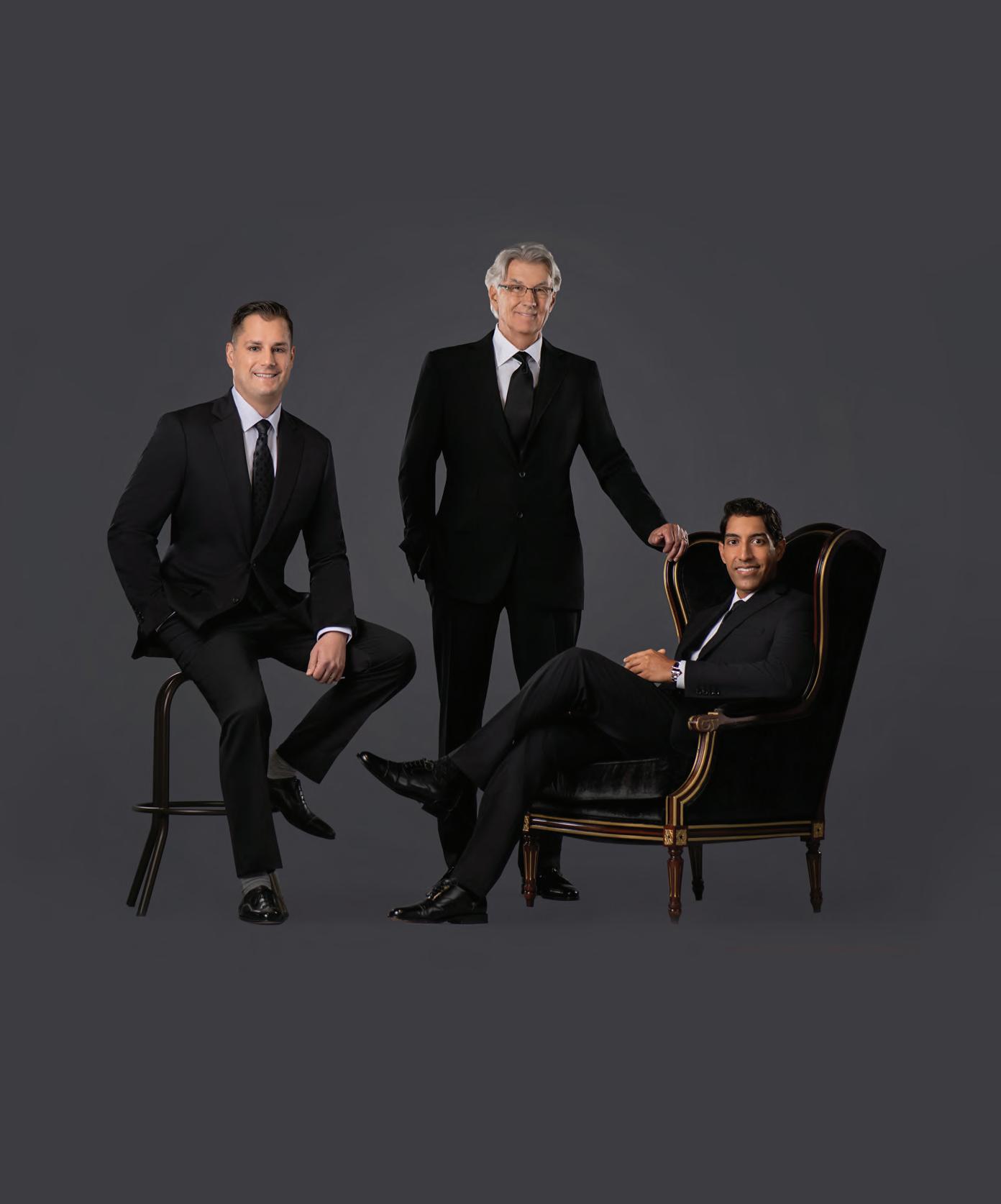ROAD TO PARADISE
COLLIER’S CENTENNIAL
REFLECTING ON THE PAST, LOOKING TO THE FUTURE

CELEBRATING 100 YEARS OF COLLIER COUNTY, FEATURING THE NAPLES COLLECTION BY SEAMAN SCHEPPS EXCLUSIVELY FOR YAMRON JEWELERS.





COLLIER’S CENTENNIAL
REFLECTING ON THE PAST, LOOKING TO THE FUTURE

CELEBRATING 100 YEARS OF COLLIER COUNTY, FEATURING THE NAPLES COLLECTION BY SEAMAN SCHEPPS EXCLUSIVELY FOR YAMRON JEWELERS.




For those who long for a home where captivating modern design and a stunning coastal location are just the beginning, The Ritz-Carlton Residences, Naples redefines elegant Southwest Florida living. Endless Gulf views, white-sand beaches, a marina-front lagoon, more than 50,000 sq.ft. of curated amenities, chef-inspired dining, and The Ritz-Carlton legendary service have all come together in one exclusive address limited to just 128 residences.

Discover the waterfront home you have always craved, with graciously sized residences, penthouses, and grand penthouses, elegantly appointed interiors, rooftop retreats, and impeccable attention to detail.
The time has come to make your life legendary.
THE RITZ-CARLTON RESIDENCES, NAPLES ARE NOT OWNED, SOLD OR DEVELOPED BY THE RITZ-CARLTON HOTEL COMPANY, L.L.C. OR ITS AFFILIATES (“THE RITZ-CARLTON”). STOCK RESIDENCES, USES THE RITZ-CARLTON MARKS UNDER A LICENSE FROM THE RITZ-CARLTON, WHICH HAS NOT CONFIRMED THE ACCURACY OF ANY OF THE STATEMENTS OR REPRESENTATIONS MADE HEREIN. ORAL REPRESENTATION CANNOT BE RELIED UPON AS CORRECTLY STATING THE REPRESENTATIONS OF THE DEVELOPER. FOR CORRECT REPRESENTATIONS REFERENCE







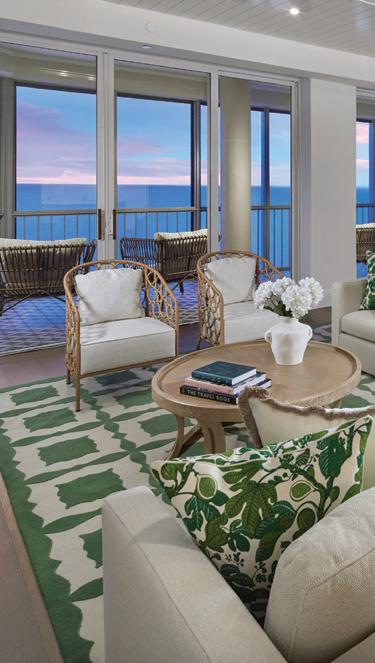




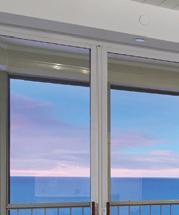


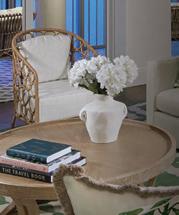









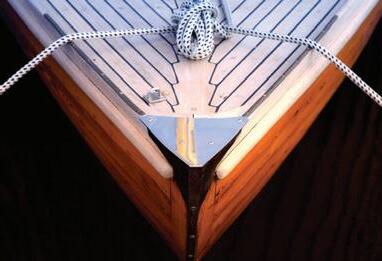



EVERY GREAT DESIGN BEGINS WITH AN EVEN BETTER STORY. YOURS.
GREAT DESIGN BEGINS WITH AN EVEN BETTER STORY. YOURS.
EVERY GREAT DESIGN BEGINS WITH AN EVEN BETTER STORY. YOURS.
Discover how our acclaimed design team creates bespoke luxury interior design solutions driven by the chapters of your life that inspire you. Schedule a complimentary personal Design Profile at our inspiration studio located in Mercato, Naples or at DWest.com.
how our acclaimed design team creates bespoke luxury interior design driven by the chapters of your life that inspire you. Schedule a complimentary personal Design Profile at our inspiration studio located in Naples or at DWest.com.
Discover how our acclaimed design team creates bespoke luxury interior design solutions driven by the chapters of your life that inspire you. Schedule a complimentary personal Design Profile at our inspiration studio located in Mercato, Naples or at DWest.com.








239.860.7176
michelle.thomas@premiersir.com
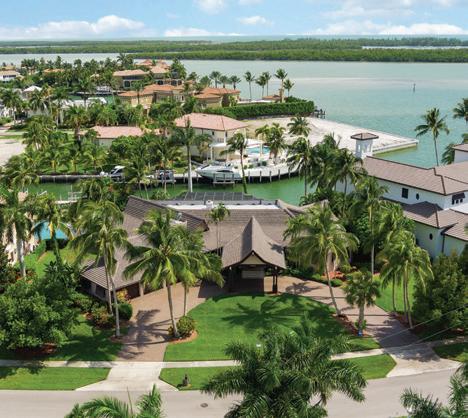





michelle.thomasteamflorida.com
#1

Miles C. Collier’s exclusive collection evokes the region’s longtime love affair with automobiles.




The Osceola-Zepeda family carries on their tribe’s traditional crafts.

Inspired by Doris Reynolds’ book When Peacocks were Roasted and Mullet was Fried , local chefs take on historic recipes.


With two thriving clubs and a buzzy annual show, Naples is a haven for the monosymmetrical blooms.
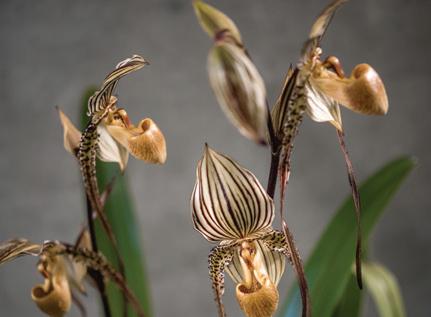



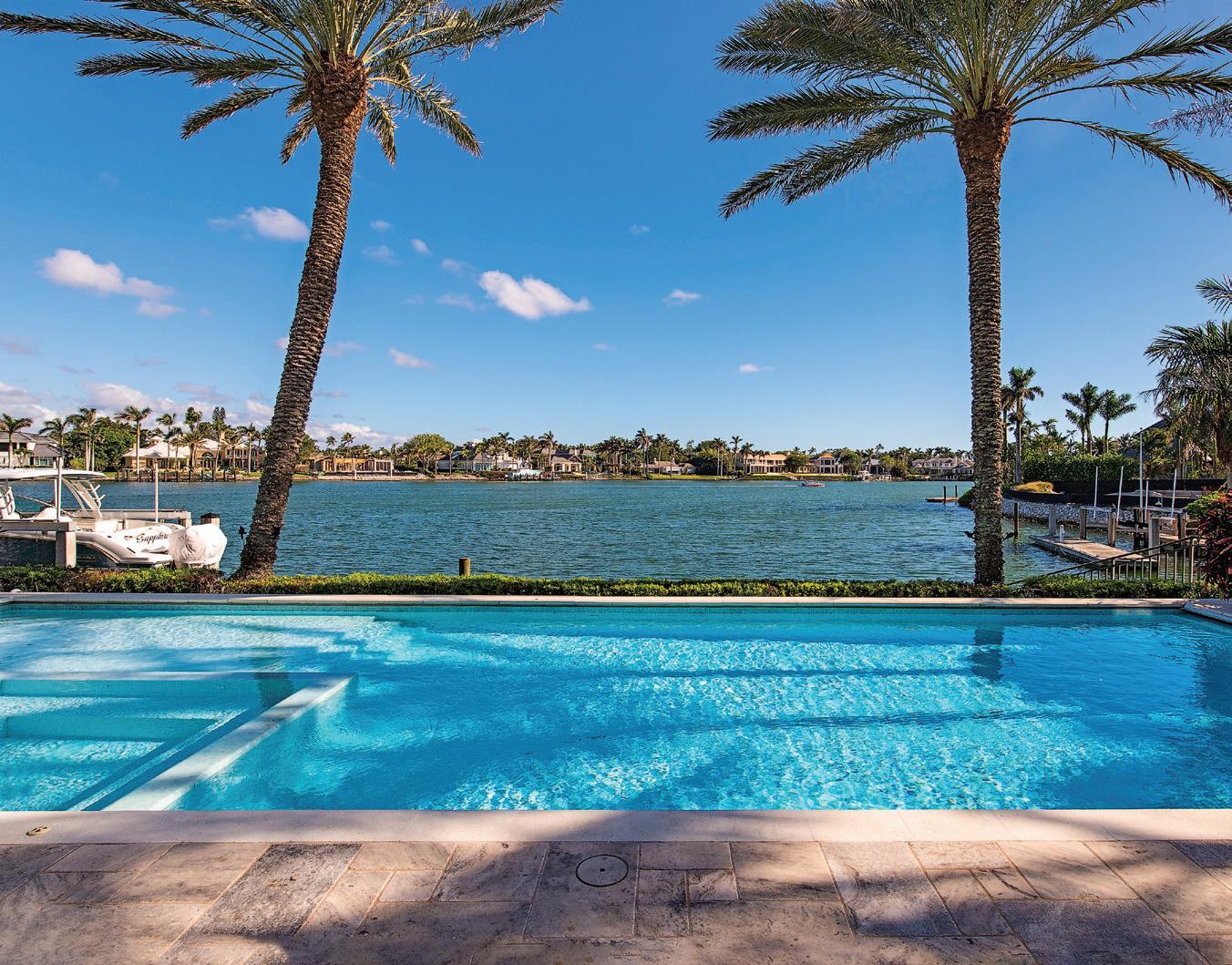
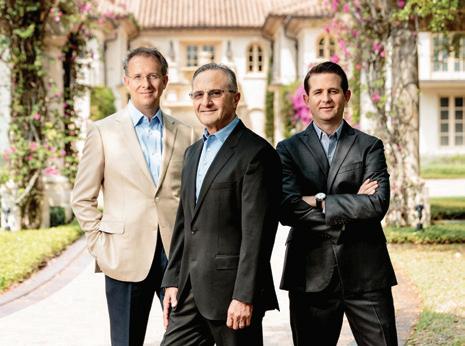





 411 GULF SHORE BOULEVARD SOUTH OLDE NAPLES | $15,495,000
680 8TH AVENUE SOUTH OLDE NAPLES | $5,995,000
411 GULF SHORE BOULEVARD SOUTH OLDE NAPLES | $15,495,000
680 8TH AVENUE SOUTH OLDE NAPLES | $5,995,000
07 — 2023
Arts + Culture
76
—
+
The Past: Ode to Naples Pier
40
The Present: Collier’s descendants
—
76 The Past: Naples’ most storied art collection
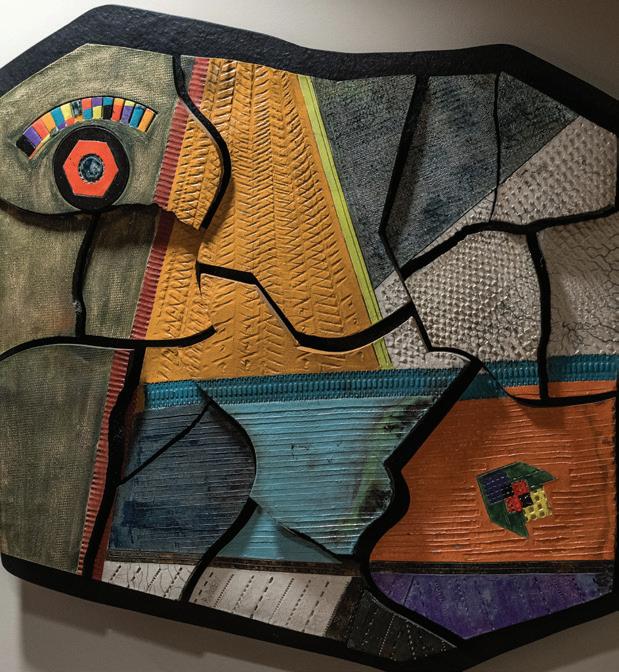
86 The Present: Marco’s retro photographer Austin Bell
196
Brian Denney and Amy Perry of Gems of Note in Naples, collect the earth’s most magnificent works of natural art for those with a discerning taste for beauty and rarity.
Brian Denney, FGA, GG is recognized worldwide as an expert in colored diamonds and rare gemstones. As a master diamond grader, he is pleased to share his knowledge with retailers and private clients across the United States.

Amy Perry brings extensive knowledge of the jewelry industry and direct connections with some of the world’s most important diamond and gem sources. By purchasing directly from the origin mines and partnering with esteemed global suppliers, Gems of Note curates the finest diamonds and gemstones available.
The personal jewelers at Gems of Note can customize your jewelry buying experience by offering some of the world’s finest treasures that fit your exact specifications. They take great pride in showcasing diamonds and colored gemstones of exceptional rarity and bespoke jewelry of outstanding quality.
Let this award-winning team take you on a journey to create your very own jewelry masterpiece from their one-of-a-kind gallery.



The
www.jennifersfortmyers.com Subtle
President/CEO
Jim Schwartzel
Director of News +
Local Content
Tom Doerr
Editor in Chief
Stephanie Granada
Creative Director
Scott Glick
Managing Editor
Gina Valentino
Editor at Large
Dorothea Hunter Sönne
Food Editor
Andrew Atkins
Senior Writer
Jaynie Bartley
Assistant Editor
Emily Flournoy
Editorial Assistant
Addison Pezoldt
Editorial Fellows
Jenna Hackeman
Emma Rodriguez
ART Art Director

Alberto Orta
P hoto Editors
Elizabeth Bankmann
Stephanie Broad
ADVERTISING Associate Publisher
Mindy Roosa
National Account Director
Wendy Tooley

Marketing Consultants
Holly Baldwin
Nikee Fellows
Natasha Gonzalez
MARKETING
D irector of Marketing and Events
Rachel Galante
Digital Media Marketing Manager
Brittney Kleis
CIRCULATION
Director of Audience Development
Kerri Nolan
PRODUCTION
Production Manager
Martha Leavitt
Production Services Manager
Laura Noriega
ADMINISTRATION
Advertising Services Manager/


Reprint Sales & Distribution
Kathleen Hill

Reader Services
OFFICE ADDRESS
26101 S. Tamiami Trail Bonita Springs, FL 34134
Call or text us at (239) 498-8500
Website: gulfshorelife.com
Email: info@gulfshorelife.com
SUBSCRIPTIONS
Your subscription includes 12 issues of Gulfshore Life a year. If you have a question about your subscription, call or text us at (239) 498-8500; write to Subscription Services, Gulfshore Life, 26101 S. Tamiami Trail, Bonita Springs, FL 34134; email subscriptions@ gulfshorelife.com; or visit gulfshorelife.com . Please Note: Subscription refunds are unavailable for this publication due to the excessive discounting from the cover price. You may transfer the remaining issues of your subscription to someone else or to a local business or charity.
GIFT SUBSCRIPTIONS
Call or text us at (239) 498-8500 or order from gulfshorelife.com . We will send a gift announcement card to the recipient.

CHANGE OF ADDRESS
Send the old and new addresses and a mailing label, if possible, to Gulfshore Life, 26101 S. Tamiami Trail, Bonita Springs, FL 34134. Visit gulfshorelife. com/subscribe to log in and update your address; call or text us at (239) 498-8500; or email subscriptions@gulfshorelife.com.
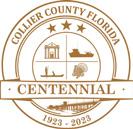
BACK ISSUES
Order online at gulfshorelife.com/ backissues , purchase by mail for $9.95 postage paid or at our office for $5.95 each, plus tax. Call or text us at (239) 498-8500.

REPRINTS
Visit gulfshorelife.com/reprints for plaques and reprints.
LETTERS
Send letters to Gulfshore Life, 26101 S. Tamiami Trail, Bonita Springs, FL 34134; or visit gulfshorelife.com . Include full name, address and phone number.
Gulfshore Life adheres to American Society of Magazine Editors guidelines, which require a clear distinction between editorial content and paid advertising or marketing messages.
©Gulfshore Life Media, LLC. All rights reserved. 26101 S. Tamiami Trail, Bonita Springs, FL 34134
Gulfshore Life and Gulfshore Life Media, LLC retain exclusive rights to all editorial and photographic materials used. Materials cannot be reproduced in any manner without written consent.
© Copyright Gulfshore Life is published by Gulfshore Life Media, LLC. The entire document of Gulfshore Life is © 2023 by Gulfshore Life Media, LLC. No portion may be reproduced in whole or in part by any means, including electronic retrieval systems without the express written permission of the publisher. Gulfshore Life HOME Gordon Drive MINI Healthy Life Southwest Florida Guide to the Arts Visitors’ Guide, Men and Women of the Year, Best of the Gulfshore, Taste of the Gulf, Weekend Insider and Shore Thing are copyrighted service marks and are the property of Gulfshore Life Media, LLC., all rights reserved. Editorial content does not necessarily reflect the opinions of the publisher of this magazine. Editorial or advertising does not constitute advice, but it is considered informative. Gulfshore Life is locally operated. Occasionally we make our subscriber list available to carefully screened companies that offer products and services that we believe would interest our readers. If you do not want to receive these offers, please advise us at Gulfshore Life, 26101 S. Tamiami Trail, Bonita Springs, FL 34134. Please include your name and address as it appears on the mailing label of your most recent issue.






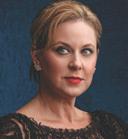


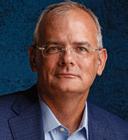






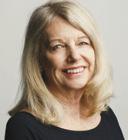


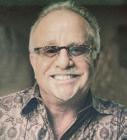
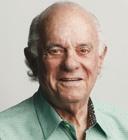 Brian Tietz (11); Courtesy Shirlene Elkins, Ellin Goetz, Mark Loren, Sandy Stilwell Youngquist
Elliott H. Singer Managing Director and Founder, Fairview Advisors Trustee, Naples Children & Education Foundation Member-at-Large
Mark Loren Head Jewelry Designer/Owner, Mark Loren Designs 2016 Man of the Year
Gail Markham Founding Partner, Markham Norton Mosteller Wright & Company 2011 Woman of the Year
Rebecca Maddox Owner/Developer, Three60 Market, Three60 Wine and Celebration Park 2019 Woman of the Year
Denise Cobb Chair, Community Advisory Board Trustee, Naples Children & Education Foundation 2000 Woman of the Year
Dwayne Bergmann Principal Designer/ Owner, Dwayne Bergmann Interiors 2020 Man of the Year
Mary Susan Clinton Founder, Gallien Global Vision Inc. Trustee, Naples Children & Education Foundation 2002 Woman of the Year
Ingrid Aielli Co-Owner, Aielli Group 2016 Woman of the Year
Shirlene Elkins Real Estate Professional, John R. Wood Properties Trustee, Naples Children & Education Foundation 2003 Woman of the Year
Brooke Denson Real Estate Professional, Dina Marie Realty Trustee and Treasurer, SWFL Children’s Charities 2019 Woman of the Year
Ellin Goetz President, Goetz+Stropes Landscape Architects 2000 Woman of the Year
David Corban President, David Corban Architects 2020 Man of the Year
Adria Starkey President, Collier FineMark National Bank & Trust Trustee, Naples Children & Education Foundation 2000 Woman of the Year
Sandra Stilwell Youngquist Owner and CEO, Stilwell Enterprises 2006 Woman of the Year
Brian Tietz (11); Courtesy Shirlene Elkins, Ellin Goetz, Mark Loren, Sandy Stilwell Youngquist
Elliott H. Singer Managing Director and Founder, Fairview Advisors Trustee, Naples Children & Education Foundation Member-at-Large
Mark Loren Head Jewelry Designer/Owner, Mark Loren Designs 2016 Man of the Year
Gail Markham Founding Partner, Markham Norton Mosteller Wright & Company 2011 Woman of the Year
Rebecca Maddox Owner/Developer, Three60 Market, Three60 Wine and Celebration Park 2019 Woman of the Year
Denise Cobb Chair, Community Advisory Board Trustee, Naples Children & Education Foundation 2000 Woman of the Year
Dwayne Bergmann Principal Designer/ Owner, Dwayne Bergmann Interiors 2020 Man of the Year
Mary Susan Clinton Founder, Gallien Global Vision Inc. Trustee, Naples Children & Education Foundation 2002 Woman of the Year
Ingrid Aielli Co-Owner, Aielli Group 2016 Woman of the Year
Shirlene Elkins Real Estate Professional, John R. Wood Properties Trustee, Naples Children & Education Foundation 2003 Woman of the Year
Brooke Denson Real Estate Professional, Dina Marie Realty Trustee and Treasurer, SWFL Children’s Charities 2019 Woman of the Year
Ellin Goetz President, Goetz+Stropes Landscape Architects 2000 Woman of the Year
David Corban President, David Corban Architects 2020 Man of the Year
Adria Starkey President, Collier FineMark National Bank & Trust Trustee, Naples Children & Education Foundation 2000 Woman of the Year
Sandra Stilwell Youngquist Owner and CEO, Stilwell Enterprises 2006 Woman of the Year


On the Cover

Shot on location at The Revs Institute, in Naples, by Omar Cruz

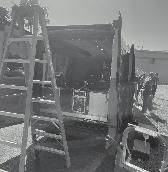
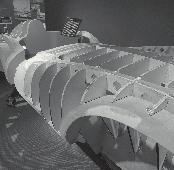



Model Alena
Gorbacheva, NEXT Management
Stylist Anna Ruiz

HMUA Dani Taverna and Kayla Rasmussen, Duality Artistry
On the cover, Alena is shown with the 1937 Delahaye 135 Competition



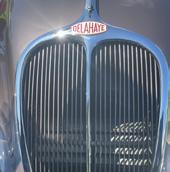



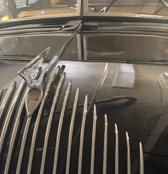








Special Roadster from Revs. She wears a Bronx and Banco jumpsuit, Atoir shirt, Hugo Boss tie and earrings and ring from Yamron Jewelers.
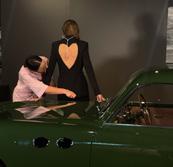

A deed for one of the first homes purchased in Port Royal, Lila Zuck’s 1,007-page history tome Naples: A Second Paradise, lengthy conversations with former mayor Bill Barnett—these are a few of the sources we pored over when developing this edition, which celebrates Naples and Collier County’s 100th birthdays.
The county was signed into existence in May 1923 with founder Barron G. Collier in attendance, followed shortly after by the incorporation of Naples in December. If time and space allowed, we would have included many more landmarks and family names in this book—Ave Maria, Chokoloskee, Waterside Shops, the Watkins, McCabes, Weeks, Suttons. But as it stands, let us consider this a colorful snippet of the people and ideas that left a lasting mark in our county and those charting the course today.
This issue is divided into four sections. Within each, there’s a story related to the past, present and future. Now, don’t go thinking too literally. You won’t find many straightforward historical accounts here. Instead, we looked to key players throughout history and took creative license to
develop stories that get to the heart of Naples culture. With “History Courses,” (p. 154) our food editor Andrew Atkins recruited five of the city’s most inventive chefs to recreate anthropological recipes from longtime food columnist Doris Reynolds’ 1993 book, When Peacocks were Roasted and Mullet was Fried. Bertha Lowdermilk’s wild boar, Ann Wynn’s peanut butter pie and Naples Hotel’s chef William Shultz’s pompano all get modern spins at the hands of culinary maestros Vincenzo Betulia, Todd Johnson and Jason Goddard. Senior writer—and plant lover— Jaynie Bartley dives into Naples’ love affair with orchids and why the plants thrive here with “Where the Orchids Bloom” (p. 188). And, writer Lauren Amalia Redding goes back further to retrace the culture that has been here since before Collier was established, with a look at five descendants of the Osceola family who continue their Seminole ancestors’ crafts (“Art of Our Land,” p. 102).
We also touch on Collier County’s legacy of giving and how that lives on with the next generation, as exemplified by Julia Hall Liegeois’ recent fundraising dinner for Kids’ Minds Matter (“A Generous Affair,” p. 52); how Naples has become a hub for athletic excellence (“In the Game,” p. 172); and the many ways people are fighting
to preserve the natural beauty that drew us all here (“Greener Grasses,” p. 186).
If you ever wonder about that special something that hooks you to Naples, just look to the city’s past. From the beginning in the late 1880s, those who came here felt a strong pride of place. Time and again in our research and conversations with modern-day residents, we come across accounts of settlers enamored by the natural setting, and intent on creating a place where kindness toward others and reverence for nature prevails. Here’s to the next 100 years.
Stephanie Granada Editor in Chief

Every area of Naples has a great story to tell—and I’m always fascinated with the story of Port Royal. It would require quite a lengthy dissertation to discuss the importance of the neighborhood in the evolution of the city, but the impact of the area and the people who call it home is undeniable.
In 1938, John Glen Sample envisioned the elegantly appointed neighborhood emerging from a tangled swath of mangroves and clam-filled mud flats along the Gulf. Mr. Sample—as he asked to be called by all outside his friend circle—fell in love with the landscape and community of 390 hardy, independent Neapolitans. He dreamt of creating an enclave like Hobe Sound on the Atlantic coast, but “without the snobbishness.” That idea permeates today.
The thing about Port Royal is it draws fascinating characters with big hearts. Many will recall early planning meetings in Gordon Drive homes for the Naples Winter Wine Festival, Conservancy of Southwest Florida, Naples Botanical Garden and many other essential institutions. Before us, Mr. Sample and
his cohorts are said to have been instrumental in Naples Yacht Club and Naples Community Hospital (now NCH Healthcare System). Preserving the natural beauty in this low-density development was an arduous task born out of love for Naples. Winding waterways all lead to Gordon Pass and the Gulf of Mexico or to the mangrove-lined inland waterways that allow a rare experience in today’s world. The covetable layout with waterfront access for all was created through an unfortunate dredge-and-fill method that was outlawed in 1976. It’s said our forefathers didn’t recognize the harm of these methods—they wanted to create an oasis that exalted Naples’ singular connection to nature. To that end, Mr. Sample bought more than 10,000 royal and coconut palms to line the streets, and there was a nursery in the neighborhood for residents to fill their gardens.
Mr. Sample—who funded everything “down to the last ashtray at the Port Royal Club,” historian Doris Reynolds wrote—had strict rules around all matters, including who could live in the neighborhood. Depth of pockets, he said, didn’t matter, but the prospects must be kind, ladies and gentlemen—no millionaire playboys, no real estate developers. He wanted to create the best place for a sequestered, welllived life.
Sure, the homes have gotten larger and the construction sometimes seems never-ending, but Mr. Sample’s notion of service for others first remains a guiding principle. In that way, Port Royal reflects the common thread woven through all of Naples: a desire to protect the unmatched quality of life, to maintain our unpretentious lifestyle and to uphold the philanthropic mindset to always help others.
Adria Starkey President, Collier FineMark National Bank & Trust Trustee, Naples Children & Education Foundation 2000 Woman of the Year


The Seminole people nourished the land long before Barron G. Collier established Collier County. Living in harmony with nature, Florida’s Indigenous people hunted and foraged from the Everglades. They carved dugout canoes to navigate the waterways and weaved baskets from native sweetgrass. Read more about today’s Seminole descendants keeping their tribe’s artistic traditions alive on p. 102.






Imagine that day, arriving by steam
To a pier in paradise still untapped
The people’s pier, the icon, launched a dream
The heart of Collier it placed on the map
Williams and Haldeman sent up a flare
Their Naples Hotel quickly met the call
The fishing was fine, the pier’s pull so fair Its pylons are roots which still keep us all

The hotel long gone, visitors still flock Sunsets, fireworks and dolphins give kicks But hurricanes wreak havoc on our big dock Both Donna and Ian turned it to sticks
The generous Norris clan rebuilt it twice Then decreed it be free, ’cuz Naples is nice
Their forefather may have established Collier County, but the Sproul women, led by tenacious matriarch, Judy Sproul, forge their own path.

One of Judy Sproul’s happiest memories was on a lake in Hallstatt, Austria, in 1987 with her three daughters—Katie, Julie and Jennifer. Julie had just graduated from high school. Katie had already graduated from Cornell University. And Jennifer, the youngest, was still at Naples High. The four women remember the day as Disney-esque (that’s fitting, considering Hallstatt would later be the model for Disney’s Frozen) . A clear blue sky stretched overhead as they rowed a boat across the lake. They sang “I’ve Had the Time of My Life” from Dirty Dancing—out that summer—and occasionally stilled their paddles to gaze at the passing swans.
Judy and her three daughters were a strong unit. They needed to be. They carried an important legacy on their shoulders, one that had shaped Collier County for a hundred years. Soon, it would be their turn to take up the mantle. But not quite yet. First, they had a lake to traverse, swans to admire and songs to sing in this tiny corner of Austria where no one knew the power of the Collier name.

Juliet “Judy” Sproul, née Collier, is the granddaughter of Barron Collier (you know, the man who bought about a million acres of Lee County to create Collier; established the county seat in Everglades City; bankrolled the completion of Tamiami Trail; and launched the first local newspaper, school and bus line). Judy grew up on Florida’s east coast before moving to Connecticut,

where she married her husband, Bud. They had three daughters—first Katie, six years later, Julie, and 20 months after that, Jennifer.
The youngest was still a baby when Bud died suddenly of heart failure in 1972. Judy was 31. “I spent one winter in Connecticut by myself, changing diapers and going, ‘Ugh.’ That’s when I decided I was moving back to Florida,”
Judy tells me recently when I meet with her and her daughters inside their company headquarters in Naples. “The move was good for everybody,” she says. “We finally warmed up.”
Once here, Judy quickly got involved in the community. She started volunteering and meeting people. Katie likes to tell this story about her mother: Judy had volunteered to help with the girls’ soccer
Judy returned to her native Naples in the 1970s with three young daughters in tow. With no former experience or a college degree, she built the Halstatt investment firm in 1992. Her first major project: the game-changing gated community Grey Oaks.

Julie, who lives in New York, sits on Halstatt’s board and chairs the Family Board. “My role has been around family governance and keeping communication systems going,” she says. Or, as Judy notes: “She’s trying to keep us all in line.”
team, and one day she got a call from the coordinator.
“I’m sending you a list of names,” the woman on the phone said.
“Oh?” Judy asked. “Am I the telephone chairman?”
The woman on the phone laughed politely. “No, you’re the new coach.”
Judy took it in stride, even when one of the team fathers gave her the onceover. “You want to be the coach?” he said. “You’ve never even played soccer.”
It’s true, Judy hadn’t. But she harnessed her whip-smart intellect and gritty determination and studied the ins and outs of the sport. By the end of the season, her team had won the championship. “That’s the kind of spirit Mom has inside her,” Katie says. “It runs in the family.”
Even with her growing involvement in the community, Judy kept one thing to herself: her maiden name. “I’m proud of being a Collier,” she says. “I just enjoy doing things on my own.”
But when her father, Barron Collier Jr., died in 1976, that was the end of her secret. Judy inherited a large piece of undeveloped land at the corner of Golden Gate Parkway and Airport-Pulling Road

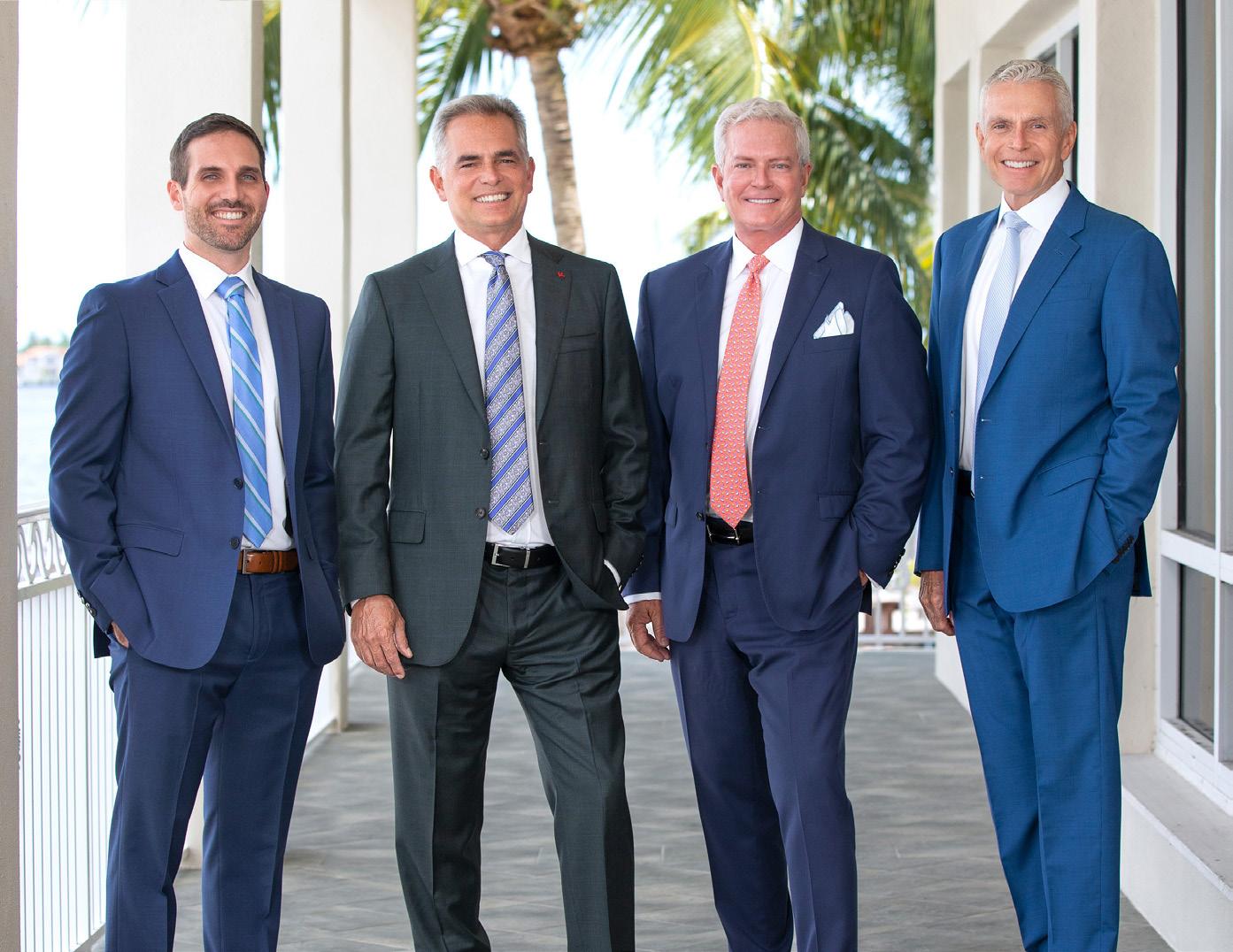


in a moment that would transform her life and change the face of Naples forever.
Judy had big ambitions for her property. She’d come from two generations of developers, and gated golf communities were spreading like wildfire in Southwest Florida. So, Judy decided to build her own and make it the finest in the region.“I didn’t want to do just another country club,” she says. “This was land that had been in my family for years and years and years. I wanted to build something my daughters and I could be proud of.”
Though Judy had no construction or business experience or even a college
degree, she had fierce inner fortitude and an unshakable belief in herself. Still, her advisors weren’t convinced. “You’ve got enough already,” they told her. “You don’t need to take on this project.” She rolls her eyes as if to say, ‘Can you believe those guys?’ “They basically patted me on the head and said, ‘Go play,’” Judy tells me.
Thankfully for Naples, Judy ignored them. “My father had believed women had no place in business,” she says. “But I’m a bit stubborn.” She surrounded herself with a strong team and set out to build Grey Oaks Country Club, transforming her parcel into a cornerstone in Naples. She


was intimately involved in the process, down to choosing the silverware in the clubhouse. Since its inception, Grey Oaks set the standard for gated-community living, adding features like outdoor dining to the clubhouse, which was unheard of at the time. “We referred to Grey Oaks as mom’s fourth child,” Katie says. Judy just shrugs: “I had a hand in everything.”
In the process, Judy had to combine the two trusts she’d inherited—one with the land and one with the capital—and her new
endeavor needed a name. For a long time, she was stumped on what to call it. Then, someone suggested she name it after a fond memory. The answer came to her immediately: Halstatt, for the picture-perfect town with the beautiful lake where she’d once rowed with her daughters.
Sitting with this pioneering Naples family inside the contemporary Halstatt offices, with picture windows that overlook graceful oaks, I’m struck by their energy. These women are captains of industry, and
Mom is the major. “We aspire to be like her in many ways,” Katie says. To which Judy adds: “And to be your own individual.”
In addition to developing Grey Oaks and LaPlaya Beach & Golf Resort, Judy was instrumental in founding the Community School of Naples and Naples Botanical Garden. She was named a Junior Achievement Business Hall of Fame Laureate in 2004, a Naples Daily News Outstanding Citizen of the Year in 2003 and the Life Achievement Award



recipient from Edison College in 2006. The trio of Judy, Katie and Jennifer were named Hodges University’s Humanitarians of the Year in 2010 and Women of Initiative by the Women’s Foundation of Collier County in 2022.
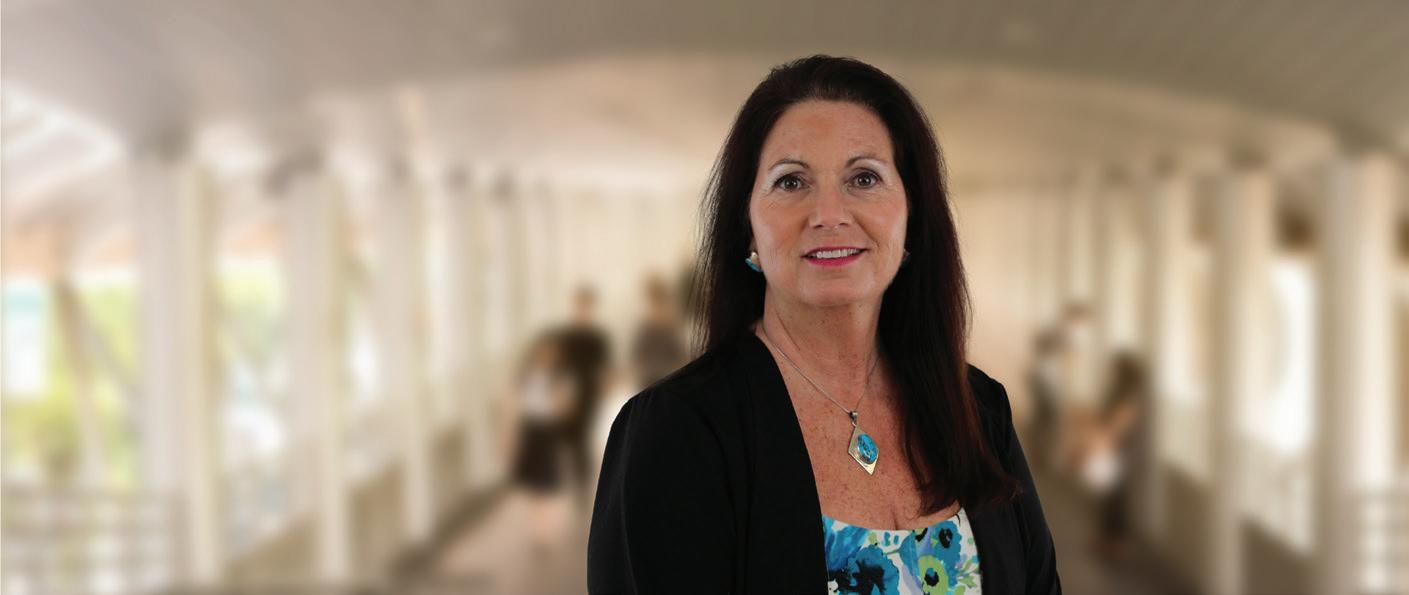
Though warm and gracious, Judy’s clearly used to speaking her mind. “There’s a saying about me,” she says. “If you ever want to know how it is, just ask Judy.” At 83, she still wants to be kept apprised of all the goings-on at Halstatt, but she knows she has an ace team in charge. “I’ve got three people here who
are really competent,” she says, pointing to her daughters.
Katie, Halstatt’s CEO, sits across the table from Judy, steady and confident as if conducting a board room. As she got more involved in the company’s financials, Katie decided to pursue an MBA from the Yale School of Management (“Thank goodness,” Judy notes). Jennifer Sullivan, the youngest, sits to Judy’s right. She’s the executive director of the Halstatt Charitable Foundation. In true Naples fashion, philanthropy is a big part of what they do (in the wake of
LMCU congratulates Kristy Kemnic-Nicol, four-time winner of the Five Star Wealth Manager Award, for her knowledge, dedication, service, and experience as a wealth advisor. Contact her today for a free consultation.
Kristy Kemnic-Nicol, CRPC®
Vice President, LPL Wealth Advisor
MaxWealth Management at LMCU (239) 908-5894
Kristy.Kemnic@lpl.com
Award based on 10 objective criteria associated with providing quality services to clients such as credentials, experience, and assets under management among other factors. Wealth managers do not pay a fee to be considered or placed on the final list of 2020, 2021, 2022, and 2023 Five Star Wealth Managers.
Securities and advisory services are offered through LPL Financial (LPL), a registered investment advisor and broker-dealer (member FINRA/SIPC). Insurance products are offered through LPL or its licensed affiliates. Lake Michigan Credit Union and MaxWealth Management are not registered as a broker-dealer or investment advisor. Registered representatives of LPL offer products and services using MaxWealth Management, and may also be employees of Lake Michigan Credit Union. These products and services are being offered through LPL or its affiliates, which are separate entities from, and not affiliates of, Lake Michigan Credit Union or MaxWealth Management. Securities and insurance offered through LPL or its affiliates are:
Hurricane Ian, the foundation donated $75,000 to relief efforts). Beside her, at the end of the table, sits Julie, a board member of Halstatt and chair of the Family Board. She’s focused and organized, leaning in with her laptop open on the table. “Julie is trying to keep us all in line,” Judy says. She looks at her daughter and smiles wryly, “Which is not an easy job.”
Today, all four look toward the future. “Until now, Mom has been the glue and driving force behind everything,” Julie tells me. “We’re starting
NCUA
Any Other Government Agency.
Not Lake Michigan Credit Union Guaranteed.
Not Lake Michigan Credit Union Deposits or Obligations.
to ask how the next generation can develop their own glue.”





The answer? Several years ago, three generations of Sprouls set off on an African safari to cement lifetime memories. There was a moment during sunset on the Okavango Delta, when their phones had stopped working and the day-to-day distractions fell away. From the youngest to the oldest, they gazed at the setting sun, held together in awe. “Family comes
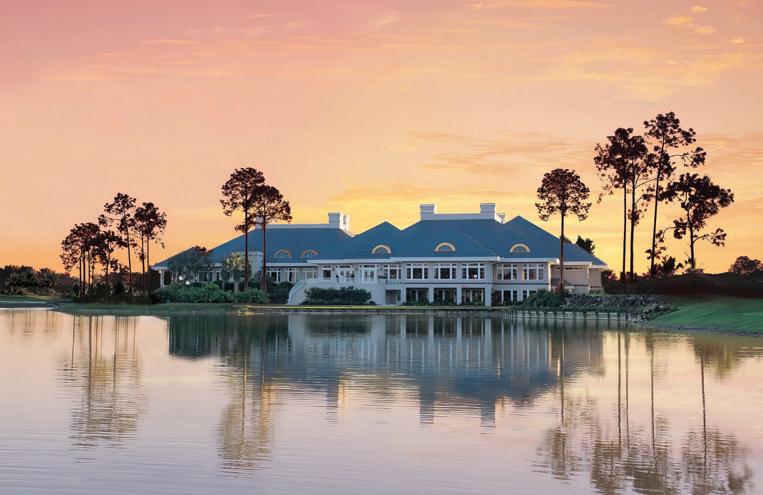
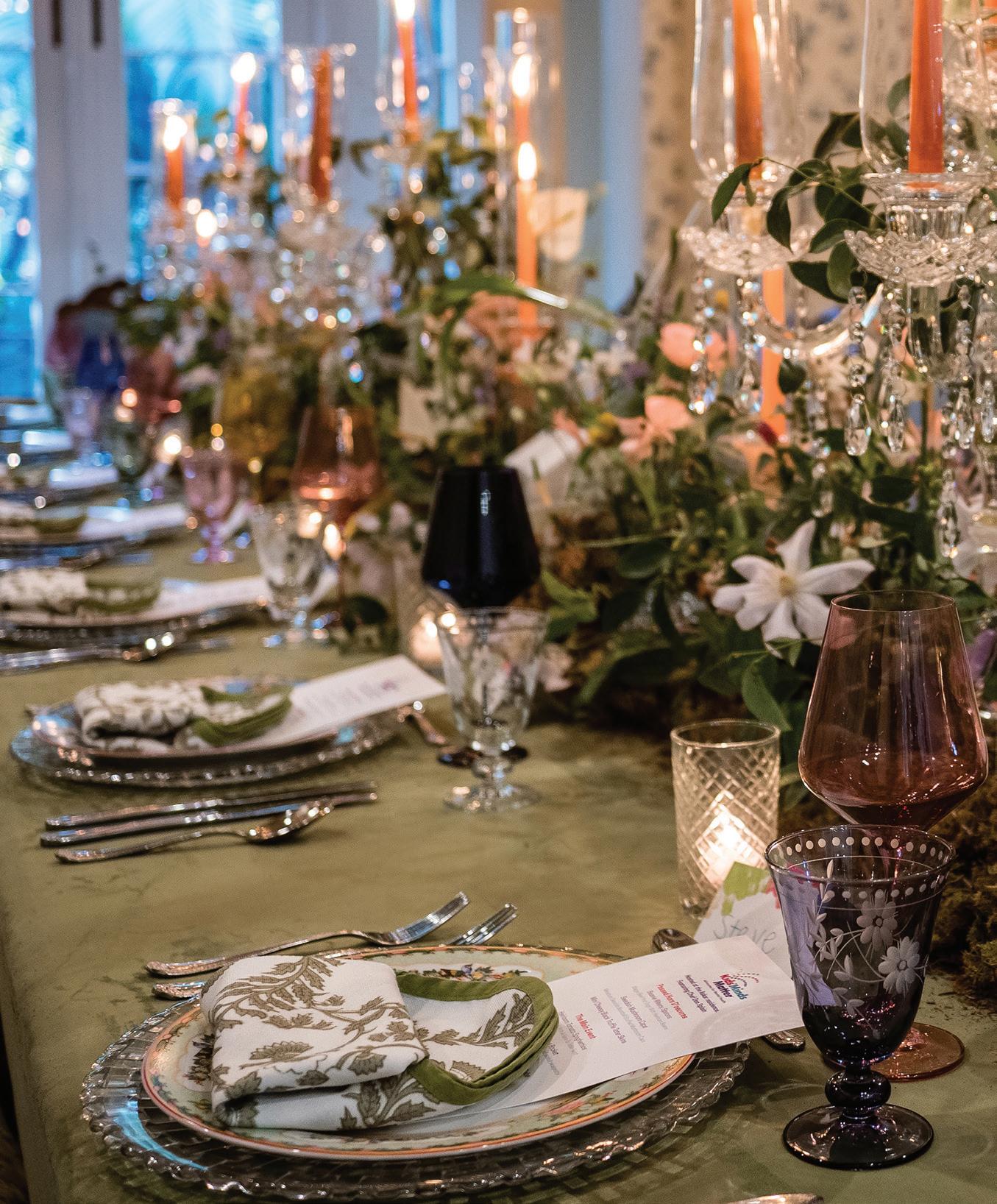 Voices + Icons — The Future — By Stephanie Granada — Photography by Anna Nguyen
Voices + Icons — The Future — By Stephanie Granada — Photography by Anna Nguyen
Collier County was built on philanthropy, and the giving continues with the next generation, as exemplified by Julia Hall Liegeois and Frank McMackin’s private fundraising dinner for mental health nonprofit Kids’ Minds Matter.
Julia Hall Liegeois shares her story to a teary room. It’s the first time she’s publicly opened up about the trauma she faced as a child, the ensuing struggle and out-of-state uprooting to get care, and the wounds she carried into adulthood after bottling it all up for years. The Naples interior designer pauses to compose herself before delivering her final message: “Sharing my story isn’t going to stop bad things from happening to other kids. But I can tell you that when you suffer trauma—and life delivers more trauma—if you haven’t been able to heal, it becomes harder to recover each time. Kids’ Minds Matter offers hope of breaking that cycle. I hope it helps you see how much your support could help someone else. Kids should not have to be sent away to get care.”
The event, hosted in the spring at Casey and Shera Askar’s Port Royal home, is one of about 12 fundraising cocktail parties and dinners Kids’ Minds Matter, a Lee Health

Foundation organization, has hosted since launching in 2016. The dinners are intimate, hosted by one or a few individuals with a strong calling to the cause. The hosts are intentional with the guest list. With fewer than 50 people, the setting allows for open conversation, interactions with the organization’s leaders and, for many, a deeper connection to the issue.
After Julia shares her story, Lee Health’s director of development, Anne Frazier, calls out for support. In quick succession, the donations pour in. “Put us down for $20,000,” one woman says. “I’ll match it,” chimes another. By the end of the evening, $103,000 has been committed.
Philanthropy has always been a cornerstone of Naples. The city came together as a sort of grassroots project, with hardy individuals who stumbled across Southwest Florida and couldn’t envision a better place to live. In the 1940s, they created The Naples Plan, a fund for civic improvements that functioned like a nonprofit, allowing residents to deduct up to 90 percent of donations to the city. The plan was also called Make Naples a Better Place to Live, and locals have been operating with the same idea since: recognize a need and rise up to fill it.
Among the guests at the dinner are several Naples natives and longtime residents
whose family names are instrumental in local philanthropy—Van Arsdale, McCurry, Homan. The next generation is coming up with the same ideals that drove their parents to fill the gaps.
Astutely, Julia also stocks the guest list with newer transplants who have yet to commit the majority of their giving to a well-established cause like Naples Winter Wine Festival or Conservancy of Southwest Florida. “A lot of the same people get invited to these events—people I grew up with, who are wonderful. But, I recognized there are also people moving here that don’t really know the area yet, and we have a great opportu-
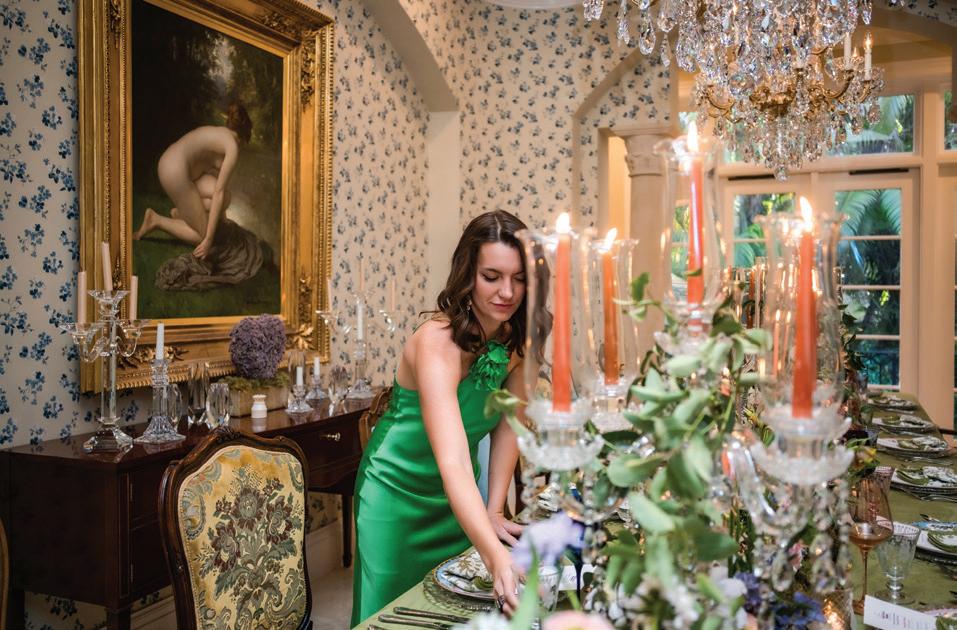
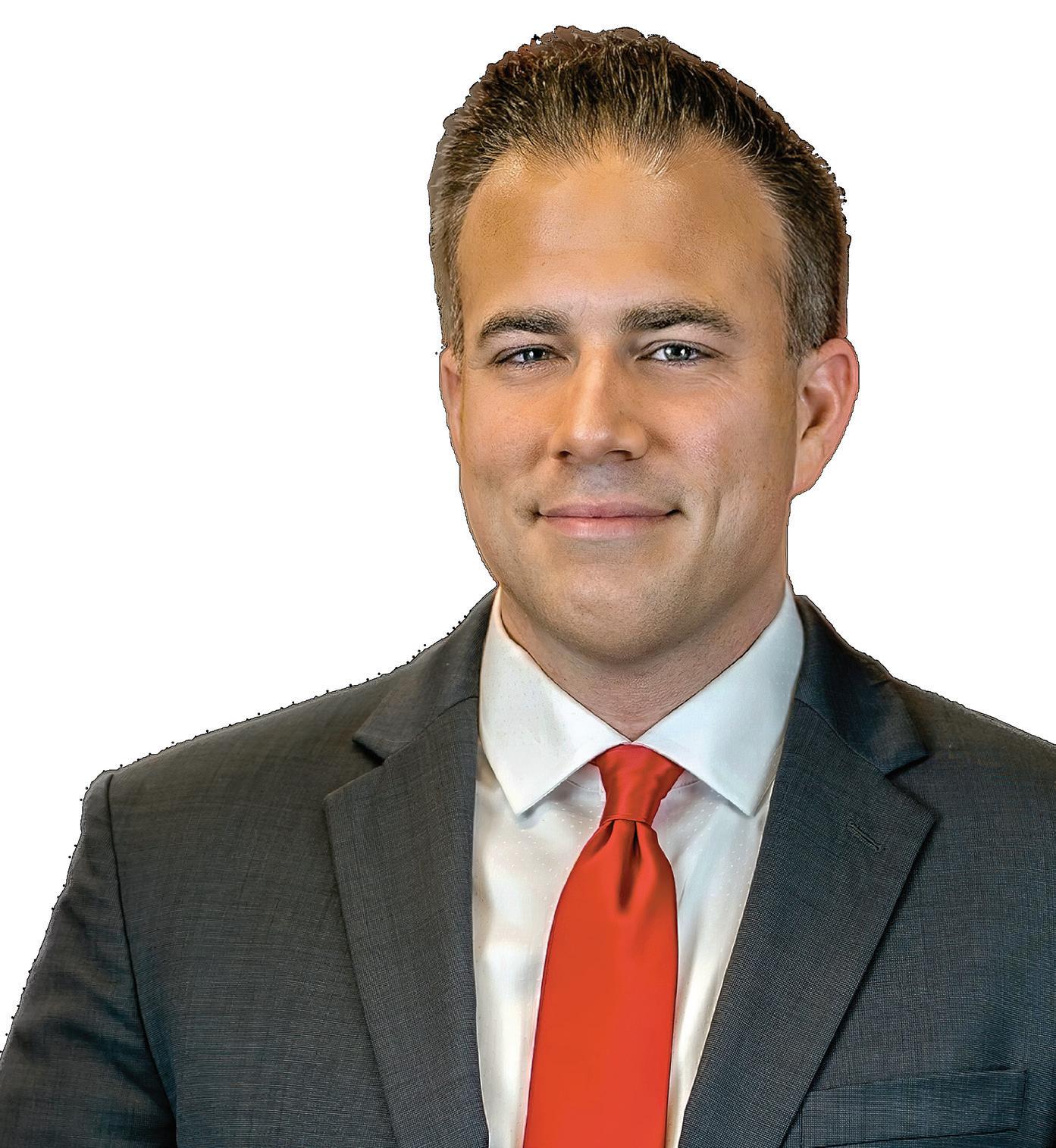
Having struggled to find the appropriate mental health care for herself as a child in Naples, and with four kids of her own, Julia wants to ensure no child has to be sent away from home for treatment. “There should be a well-known spot where parents can go with their kids, and say, ‘We need help,’” she says.


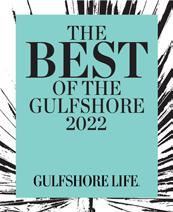

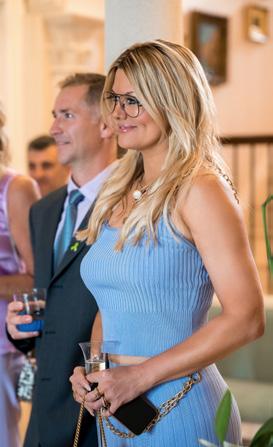













nity to get them connected to a newer organization like Kids’ Minds Matter,” Julia says. All invitees are people who she hopes can help reduce the stigma around mental health and spread awareness of the need for support locally.
Kids’ Minds Matter was created seven years ago by Susan Goldy and Scott Spiezle after having struggled to get the proper care for their daughter when she was a child. Before dinner, Anne and two doctors in attendance share some startling facts: There is a two-year wait for children to get a psychology appointment. Youths wait up to six months to be evaluated for neurodivergent conditions and three weeks for urgent psychiatry appointments. Baker Acts at Golisano Children’s Hospital of Southwest Florida have increased by 235 percent in the last two years.
Statistics like these roused Julia to the cause when she attended a similar dinner Jennifer McCurry hosted in early 2022. “I was devastated, shocked, knowing the number of philanthropic events my mom is, and that my stepmother was, a part of and all that goes on with giving, realizing there’s still no place for a child that’s been traumatized to turn,” she says. “We have a lot of support for hunger and cancer—as we should—but we still don’t have anywhere for children to turn when they are struggling. I couldn’t believe a kid today would be having the same experience I did as a child.”
After being sexually assaulted by someone who was close to her family at the time, Julia’s family didn’t know where to turn for proper care to process



Everything was intentional—the stylish French garden-inspired theme, the guests’ monochromatic dress code that reflected a rainbow of pieces coming together, and the flow of the evening, which began and ended with open dialogue and insights from Kids’ Minds Matter-allied doctors in a comfortable sitting room. "We wanted the conversation to stay on children’s mental health," Julia says.
the trauma. Mental health wasn’t talked about much during those days. Eventually, Julia started acting out in school and was sent to a facility in Utah—her biggest fear realized. “When you’re a kid and go through something traumatic, you need your parents more than ever,” she says. After nine months, her dad took her out of the program in Utah. By then, she was on so many medications, she could barely function, she tells the group. Julia met with providers in Naples, who kept trying different medications, but she didn’t receive therapy. “We didn’t find the right counselors,” she says. It’s just in the past few years that the 35-year-old mother of four feels she’s been able to start processing her trauma and get the treatment she needs: “I can’t help but wonder: If Kids’ Minds Matter had been around when I was a child, would I still be struggling the same way?”
Julia and her husband, Frank McMackin, started planning to host a dinner soon after attending Jennifer’s event. With a strong network of friends with children in Collier County, Julia and Frank quickly built an arsenal of support. The crew involved reads like a who’s who of Naples’ top makers: 50Fifty Creative Services on florals (“Matthew Huddleston is a genius,” she says.), Don Splain on food (the chef cleverly riffs on childhood favorites, like a spin on SpaghettiOs done with heirloom tomatoes and “Beanie Weeny” Wagyu hot dogs). Fellow interior designer Dani Marie Glicks conceptualized the monochromatic dress code, with each

The Collier County Sheriff’s Office has been serving our community with pride since 1923. We will continue to use innovation, technology and professionalism to keep Collier County a great place and a safe place.
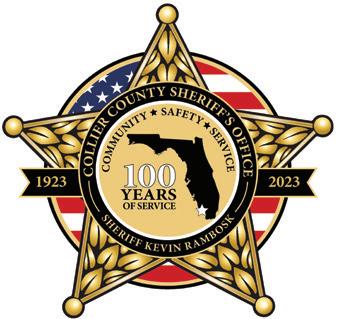


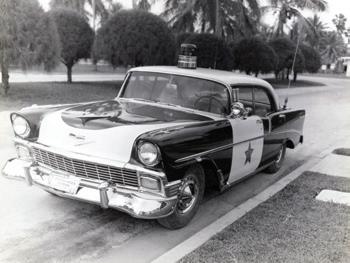
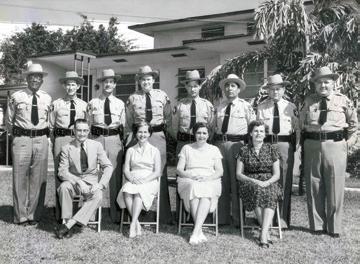

Please be our partner in keeping Collier County safe. To learn more visit colliersheriff.org.

 Collier County Sheriff’s Office | SHERIFF KEVIN RAMBOSK | Emergency 911 | Non Emergency 239-252-9300 | colliersheriff.org
Collier County Sheriff’s Office | SHERIFF KEVIN RAMBOSK | Emergency 911 | Non Emergency 239-252-9300 | colliersheriff.org
The hosts raised $103,000 for the cause. “The goal was to really speak to those dollars. It’s great knowing that $2.4 million will open a new facility here in Collier County,” Julia says, referring to the Pediatric Behavioral Health clinic Kids’ Minds Matter aims to create.

guest donning their favorite color from head to toe. “Kids’ Minds Matter’s idea of a kaleidoscope is that we all have broken pieces, but together we can make a really beautiful picture,” Julia says.
The Askars, who between them have nine children, quickly offered up their home. Julia had just finished redesigning the couple’s French garden-themed dining room, with its floral wallpaper, blue velvet curtains and antique furnishings. They knew it’d provide the ideal backdrop

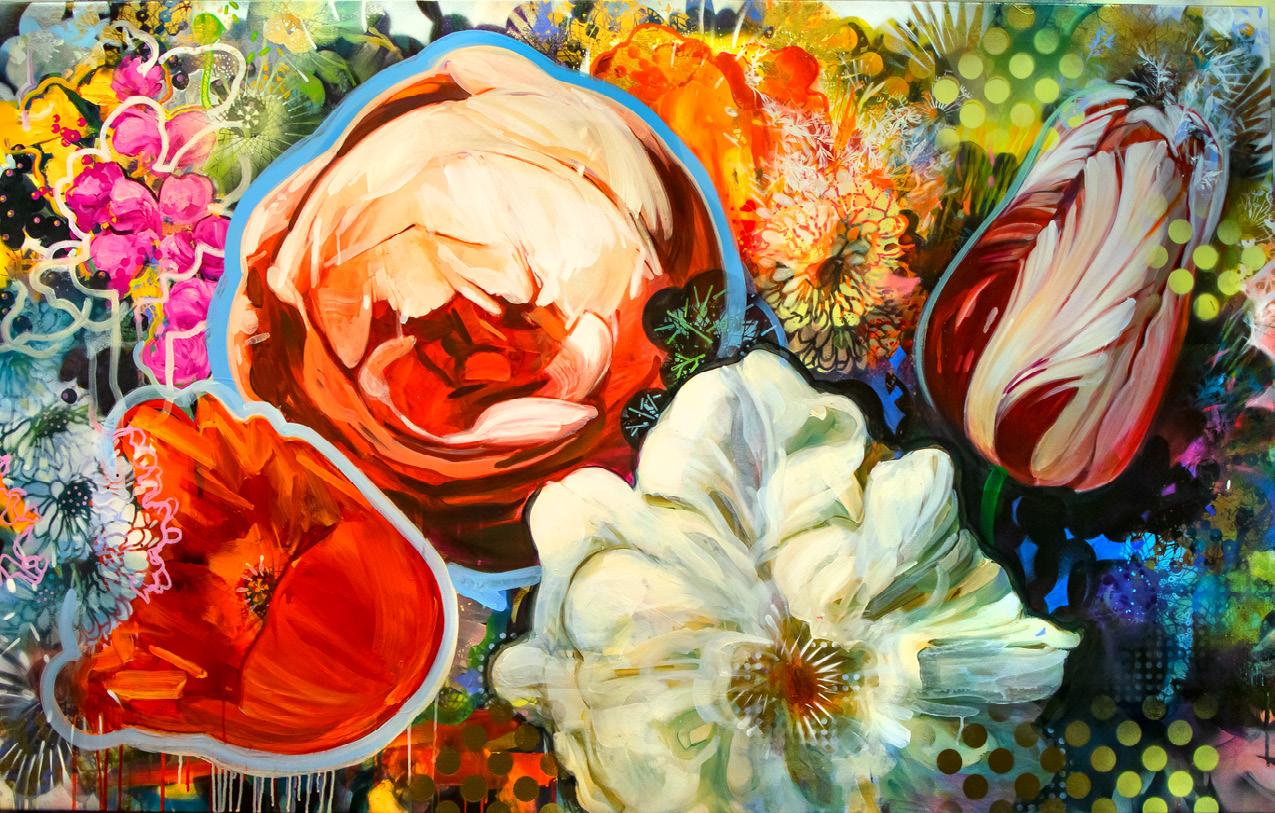


for intimate conversation. “When you go to these bigger galas, it’s a fun time and you’re at a table with friends, you listen to stories ... But the conversation then turns back away from the cause,” she says. “With intimate dinner parties, you can truly focus on the issue, the conversation stays on it. And that’s where change is going to happen.”

Transparency is key to a nonprofit’s success. Groups like Golisano Children’s Museum of Naples (C’MON) and The Immokalee Foundation are successful in part for their ability to bring the figures to life ($500 will get memberships for five families, C’MON tells patrons; $10,000 gets five elementary kids a year



of tutoring through The Immokalee Foundation). This is perhaps even more important among the younger generation of donors who grew up with Millennial ideals around accountability and open communication. “We want to know where our dollars will go,” Julia says. “It’s good to know that with $2.5 million, we can get a new facility built in Collier County.” (Kids’ Minds Matter is looking for space and funds to open a Pediatric Behavioral Health clinic in Collier.)
Julia believes that showing concrete examples becomes even more poignant when discussing mental health philanthropy. “Mental health is intangible—it’s often a problem you don’t see,” she says.
“It’s not a broken leg you can fix; there’s not one treatment, so putting something tangible for people to see what they can help accomplish is super helpful.”
Julia notes that supporting children’s mental health has broad community benefits. Kids who receive the necessary support are more likely to grow into resilient, productive adults. This, in turn, reduces the strain on healthcare systems, social services and the criminal justice system. After dinner, everyone lingers and talks, discussing the needs with Anne, offering their help and thanking Julia for sharing her story. The evening leaves a lasting impression as Naples’ next generation of philanthropists steps up to the plate.
Revs Institute honors 100 years of automobile history, with a focus on cars that shape the human experience.
 By Michael Korb
By Michael Korb
The 1930s were a pivotal moment for cars in America and for us in Collier County, as Barron G. Collier’s completed Tamiami Trail linked Southwest Florida to the east coast—allowing automobiles to flow freely into the region for the first time. “His efforts to develop an area that he fell in love with were incredible,” says Scott George, the curator of collections at Revs Institute, founded by Barron’s grandson, Miles C. Collier. “The connection from Tampa to Miami—and to connect that route to this area and what it meant is unbelievable.” Also around this time, Thomas Edison cut the ribbon for the Edison Bridge over
As motorists made their way down Tamiami Trail to the palm-lined streets of Naples, so did the refined fashion of the 1930s. Today, we channel the hyper femme aesthetic with tucked button-up blouses and textured mini dresses. Model Alena poses in the Revs Institute’s storied 1937 Delahaye Type 135MS Special Roadster, known as one of the most glamorous rides in the ‘30s. The Theory top and Zimmermann dress are both from Saks Fifth Avenue; jewelry from Yamron Jewelers.




the Caloosahatchee River, drawing more folks from Fort Myers to Naples. Marco Island swapped its ferry for a bridge to easily welcome motorists. Fifth Avenue South was shaping up to be a destination for the thousands of visitors that flocked to the fledgling town each winter, and Naples opened its first 9-hole golf course near Naples Pier.
The next generation of Colliers, Barron’s sons, recognized a national trend that fit perfectly in Naples: the European automobile and sportscar racing craze. Barron Jr., Samuel and Cowles “Miles” Collier were instrumental in bringing racing to the U.S. with the formation of the Automobile Racing Club of America in 1933 and the Sports Cars Club of America (SCCA) in 1944.
Fast-forward to the early 2000s. Miles C. Collier opened the doors to the Revs Institute in Naples. With 115 cars in the collection spanning from 1896 to 1995, Revs celebrates 100 years of automotive excellence. As we celebrate Collier County’s centennial, it’s a fitting time to recognize this car-centric family’s connection. The three-story museum houses, restores and preserves cars (including keeping them all running), and allows visitors to experience the moments our cultural relationship with automobiles shifted. From its curated collection of some of the most historically significant cars made to an ever-expanding library with more than 1.5 million images, prints, manuals, books and periodicals (much of which is digitally archived and
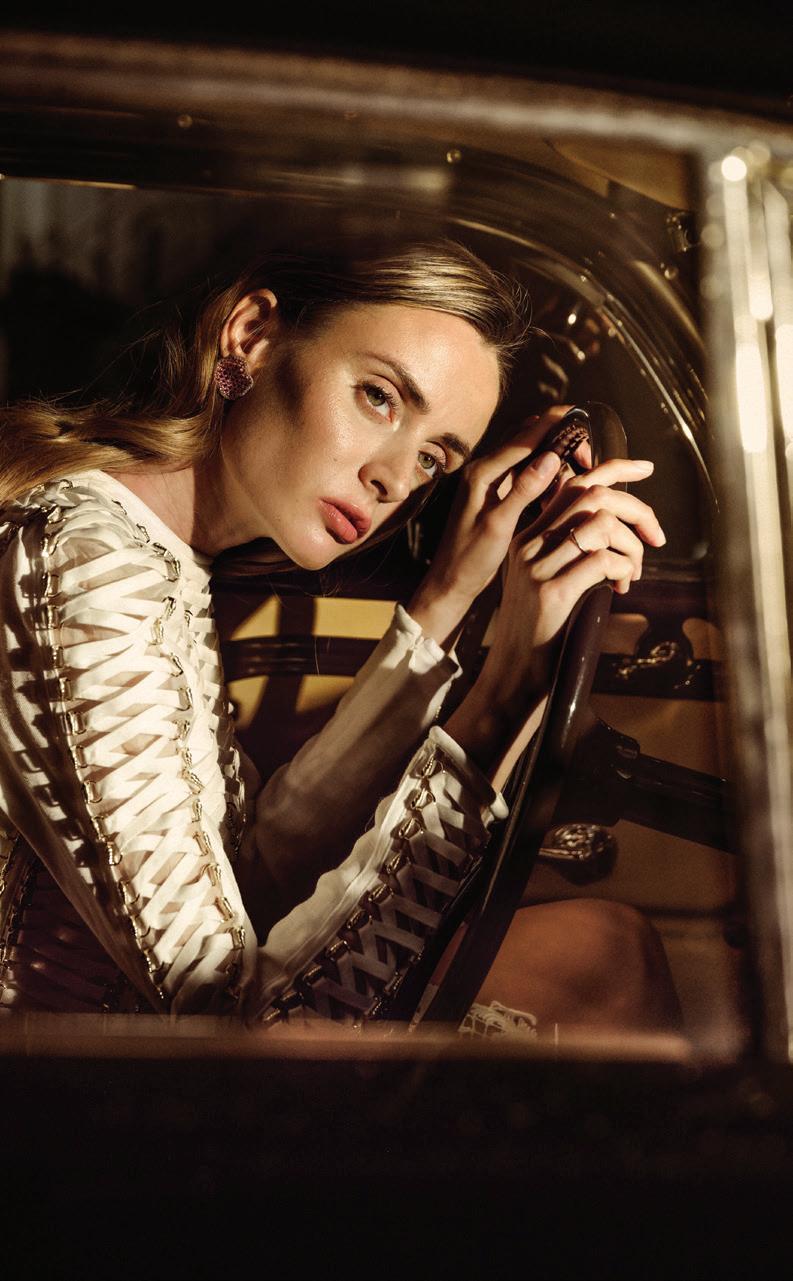
Inspired by the Art Deco movement, curves were huge in 1930s design. Car makers tapped into aerodynamics to create sloping designs like the 1934 Chrysler Airflow Imperial CV-8 Coupe, while fashion houses used dramatic peplum silhouettes to accentuate the female body, as seen in this ruffled Aje dress (left), perfectly paired with Jimmy Choo heels. A laced-up Aje dress (below) recalls the shoes racers wear to keep their toes snug when they’re putting pedal to the metal. Dresses from Saks Fifth Avenue, jewelry from Yamron Jewelers.
Some trends last for decades. As is the case with this 1950 Cisitalia 202 SC Coupe, which dates to before Cistalia founder Piero Dusio made the jump from clothing manufacturing to automotive design. For a modern twist on vintageinspired fashion, look for light-reflecting stones, like seen in this chic Self-Portrait blouse, paired with pinstraight pants from Alice + Olivia and timeless Christian Louboutin pumps. Clothing from Saks Fifth Avenue; jewelry from Yamron Jewelers.
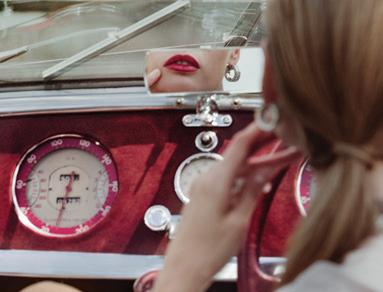


available online), Revs is a must-see for history and auto-lovers. “Even though it doesn’t get the attention it deserves, the library is a key component to the museum,” Scott says. “We have researchers coming in from around the world.”
Not surprisingly, Miles grew up appreciating automobiles. Coming from a family with such historical significance in his hometown, it’s fitting that Miles would fixate not only on automobiles’ aesthetics but also on their historical context.

The collection clearly shows the turning point in the ’30s, when automobiles started being seen as more than just practical tools of transport. Designers began crafting rolling works of art, like the museum’s 1937 Delahaye Roadster and 1938 Alfa Romeo Tipo 8C, that helped fuel the automotive love affair that burns strong today. These 1930s beauties were a far cry from the collection’s oldest car, the carriage-like 1896 Panhard et Levassor Wagonette, or the boxy 1914 Simplex that Miles’ grandfather and Collier County founder Barron Collier drove. As the decade progressed, cars got rounder, sleeker, more aerodynamic—just as Collier County was coming in its own.
Miles built the museum on Horseshoe Drive, then expanded into Revs Institute in 2009, with a focus on automobile conservation, antique car maintenance skills and deepening the appreciation of automobiles’ legacy in America. Through Revs, Miles preserves his forefathers’ legacy while cementing the importance of automobiles in the human experience. “And allowing them to live beyond our time,” George adds.
While buttoned-up looks were big in the era, modern interpretations put a cheeky spin on the classic silhouettes. It’s business in the front and party in the back with Cami NYC’s suit (above), with a heart carved out of the blazer. Speaking of cutouts, peek-a-boo details on this sky-blue Jonathan Simkhai dress (right) pack a punch. The cheery shade is a perfect complement to the pea-green 1950 Cisitalia 202 SC Coupe. Clothing from Saks Fifth Avenue, jewelry from Yamron Jewelers.

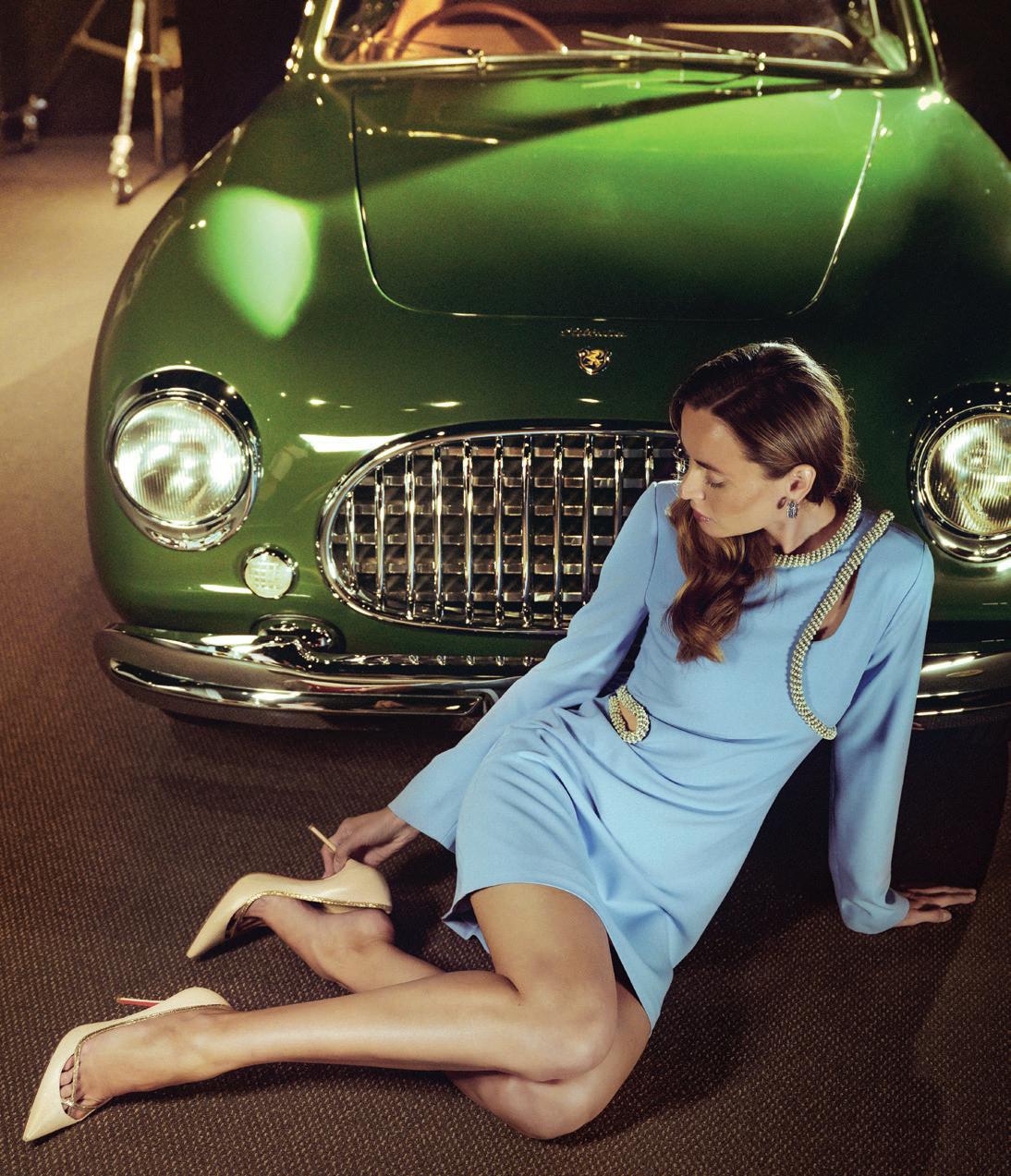
 Model: Alena Gorbacheva
HMUA: Dani Taverna and Kayla Rasmussen, Duality Artistry
Model: Alena Gorbacheva
HMUA: Dani Taverna and Kayla Rasmussen, Duality Artistry


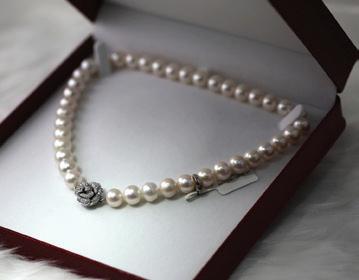




Richard Tooke and Charles Marshall’s apartment at The Arlington contains three decades of local art history.
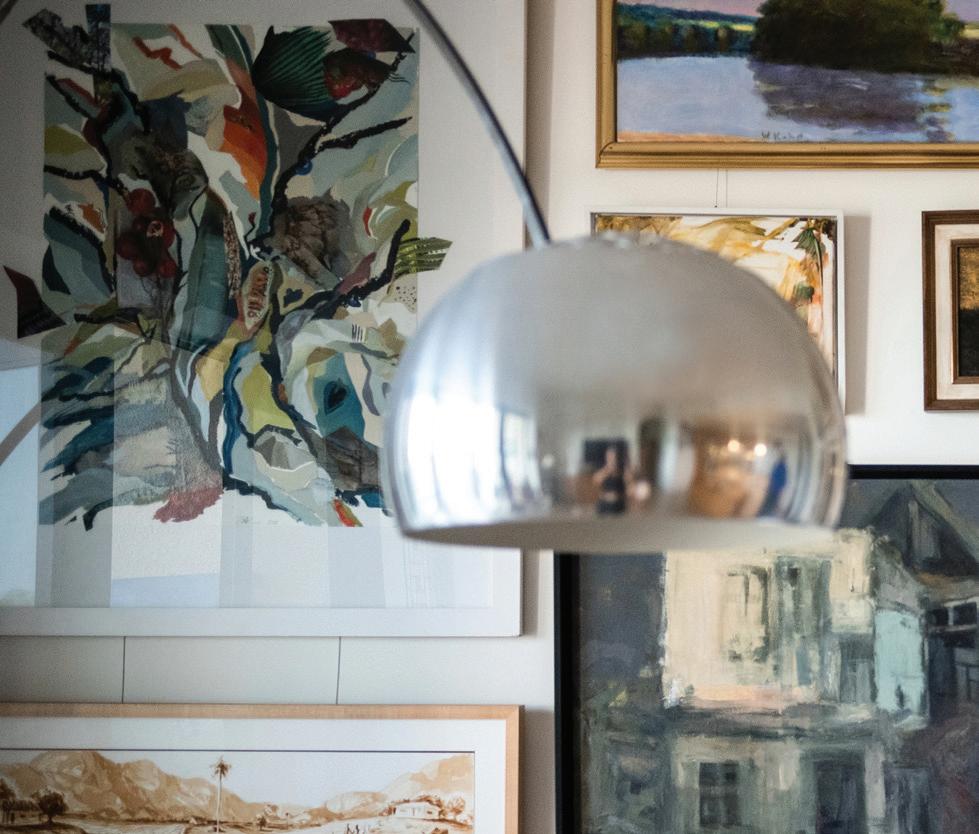
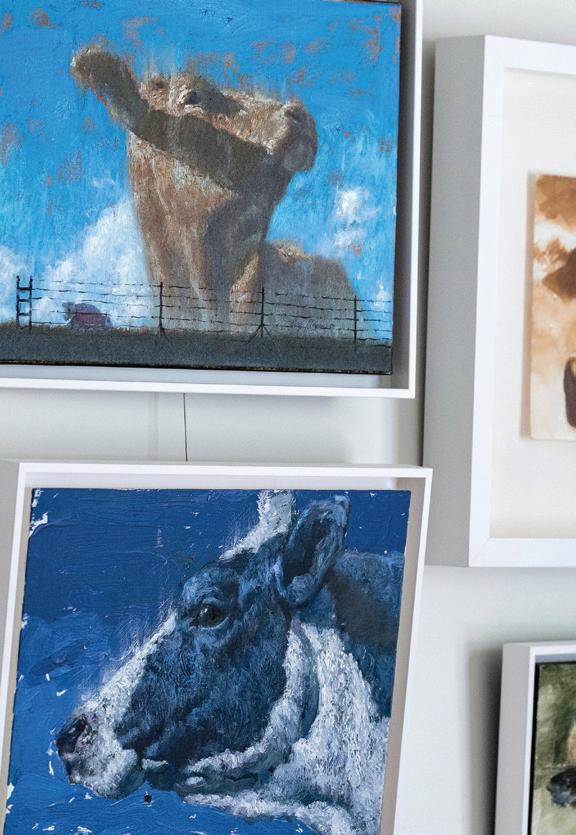
Go to Artis—Naples, The Baker Museum’s current show Naples Collects, and you’ll see a pair of names reemerge on the plaques: Charles Marshall and Richard Tooke. The Naples couple’s loaned works for the show include Faith Ringgold’s energetic You Put the Devil in Me and Will Barnet’s study for Woman and White Cat.
The duo downsized some when they moved from their midcentury modern home on Gulf Shore Boulevard North to The Arlington of Naples retirement community. The watercolors painted by Charles’ father went to the Marianna Kistler Beach Museum of Art at Kansas State University, some pieces were gifted to their Arlington community to beautify public spaces, the Steve Tobin White Rainbow Root sculpture that stood in their yard went to Naples Botanical Garden. They almost gifted the Faith Ringgold to a woman who wanted it for her daughter. “We thought, ‘Well, it’s really big. We
don’t have room to take it,’” Charles recalls. “Richard went online and looked it up, and it was shown at $32,000. So, we said, ‘Yeah, we better keep it.’”
Even after the gifts, Richard and Charles’ collection remains robust, and their 1,500-square-foot Arlington apartment contains one of the best assortments of regional art, with works collected since they moved here in 1993.

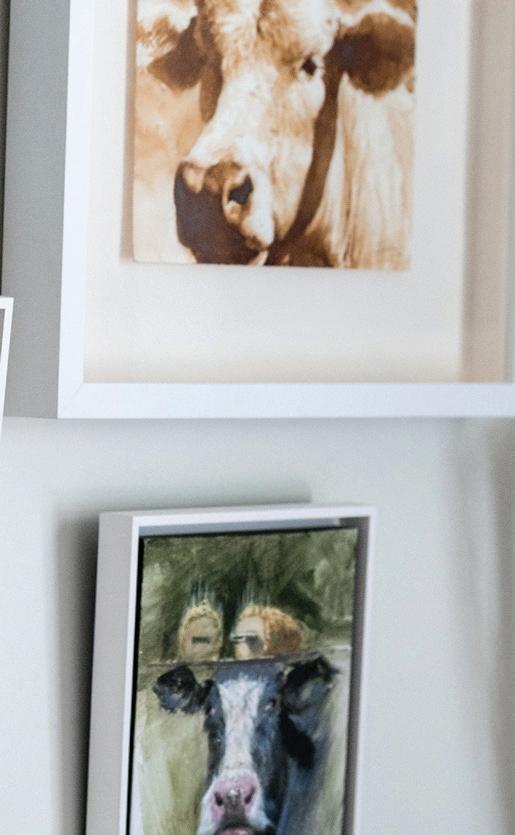
Richard is a descendant of Mamie Tooke; her husband, Clarence, founded the town’s first bank. Mamie took over as president when Clarence passed away in 1955. The pioneer kept her bank doors open to allow in the breeze and friendly conversation. She maintained her desk near the entrance until she was 91. “Everyone in town knew her,” Charles says. “When she would show up at a lounge or somewhere, they would play [the song from the movie ‘Aunt Mame.’]”
The 91-year-old Charles and 89-year-old Richard remain strong supporters of the arts. Their most recent acquisition was Mally Khorasantchi’s The Hidden Secrets of Trees #IV from her show at Harmon-Meek Gallery in December. They admit the 4-foot piece is a little larger than they typically get these days, living in a small space, but they couldn’t resist. This month, the couple cosponsors Naples Art Institute’s Naples Invitational with about 40 Collier artists. “Frank (Verpoorten) was reaching out for sponsors, and we were able to do it, so we did,” Charles says. Nearly every square inch of their apartment’s walls is covered with paintings and photographs. Most surfaces flaunt ceramics and small sculptures, like the abstract carved bronze piece by Melvin Schuler they purchased at a sale from avid collector and Naples resident Olga Hirshhorn’s collection.
Richard and Charles moved to Naples after Richard’s aunt, Mamie Tooke, the president of Naples’ first bank, passed away. They’ve been avid collectors since. The Steve Tobin White Rainbow Root sculpture at Naples Botanical Garden was gifted by the couple when they downsized and moved to The Arlington.
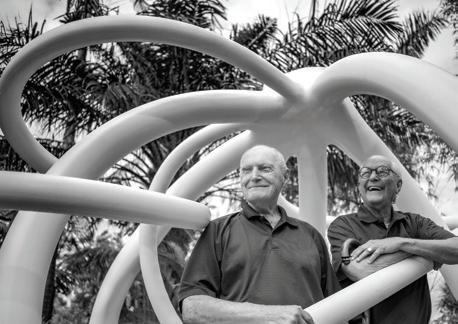
After Mamie had passed and the couple retired in 1993, Richard and Charles bought her home and moved to Naples. Richard had been visiting his Naples aunt and uncle since the 1940s. Before moving to New York City to attend grad school for fine art at Columbia University, he lived with Mamie and worked for historian Doris Reynolds, illustrating her magazines. “He did the first map of Naples,” Charles says, noting that the couple donated the piece to the Naples Historical Society.
The pair got involved with the Naples Philharmonic (now Artis—Naples) right away. Richard eventually took on the role of president of the Naples Museum of Art (now The Baker Museum) Friends of Art group. During his tenure, he started the Incognito fundraiser, with about 300 artists painting chairs for the auction. The chair with a nude painting by Roger Sherman came from the auction. A friend had won it but was coy about displaying it and would stash it when company came over, so Richard and Charles traded with him, unabashed to let the art sit openly.
Their apartment is outfitted almost exclusively with midcentury modern furnishings. Renowned Naples interior designer and midcentury savant Richard Geary refinished the couple’s cerulean Bertoia Diamond chair. He also made the cabinet that sits outside their living room. “And that’s a Gail Geary,” Charles says, pointing to an earthy ceramic by the designer’s wife. Works from Robert Raus-

chenberg, Marcus Jansen and Jonathan Green hang around Knoll lighting and the Eames lounge and ottoman New York’s Museum of Modern Art (MoMA) gifted Richard (Tooke) after he retired from a 30-year career with the museum. Charles was the lead architect for the Presbyterian Church nationwide. The two met in 1960 when Richard played piano for the group’s prayer service. “When I saw Richard, I thought, ‘Well, I better start coming to prayer more,’” Charles says smiling. They spent three decades living in New York, attending exhibitions at MoMA, The Met and The Frick Collection. When they moved to Naples, the recently retired couple had more time on their hands and started collecting in earnest.
Going through their home is like getting a history lesson on Southwest Florida art. In the living room hangs a Stephen Knapp Lightpainting, which casts prismatic neon rays across the room at night. “Myra [Janco Daniels] had the Collectors’ Corner that sold artwork, and we bought it there,” Charles says, referring to the art gallery the Naples art pioneer maintained in Hayes Hall for about a decade.
Everywhere you look hangs a story. Their bedroom alone contains about 40 artworks. “Here’s a Richard Segalman of a landscape in Central Park—landscapes are not something he usually did, so that’s why we liked it,” Charles says, referring to the artist who notably documented Naples beach scenes. “This is an early
A rare opportunity in Bonita Bay
26110 Woodlyn Drive, Bonita Springs



BEDS 4+DEN | BATHS 4-2 HALF BATHS | 4,555 SQ.FT.
An exceptional opportunity to own this Savannah model home with many premium upgrades in the coveted Baywoods II neighborhood in Bonita Bay. Designed by award-winning R. G. Designs, with interior by SOCO Interiors. Winner of the coveted Sand Dollar Awards when built--Product Design of the Year and Interior Design of the Year. State-of-theart kitchen, featuring premium appliances, Sub Zero refrigerator, Wolf appliances and two large islands. You and your family and guests will enjoy the open floor plan with very generous Great Room, Kitchen and Dining areas that flow seamlessly to a magnificent outdoor pool and entertaining area. Large heated pool/spa and outdoor dining, and gas BBQ grill. Each guest bedroom has a full bath en suite. Oversized 3-car garage. Offered FULLY FURNISHED with designer interior and furnishings. Move-in ready. Call us today to schedule your private showing.


837 5th Avenue South, Naples, FL 34102 239-595-7009
| aquiceno@dnaflorida.net
837 5th Avenue South, Naples, FL 34102 239-449-0255
| dhumbert@dnaflorida.net
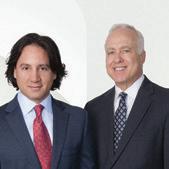


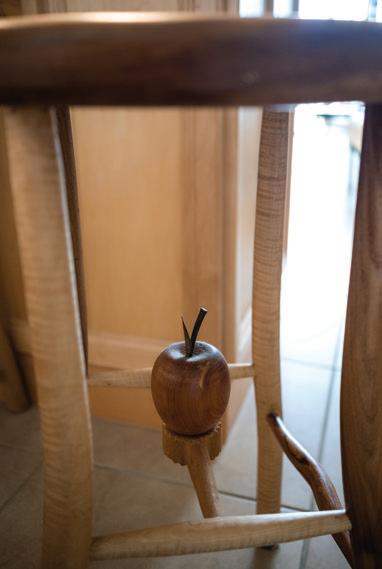



Richard and Charles met in 1960 when Richard played piano for a Presbyterian prayer service in New York. The couple donated the Samick piano they acquired at an auction at Sidney & Berne Davis Art Center to The Arlington for residents to enjoy.

Paul Arsenault, somewhere in Cuba—and the other one he did is over the doorway there, that was Grenada … That’s Mary Voytech, you know, she’s at [Florida Gulf Coast University].” The primary bathroom holds a plaster bust Charles has toted around since taking art lessons in New York in the ’60s and works by their friend and Fort Myers artist Michael St. Amand, who created a bright collage with the number ‘50’ for the couple’s golden anniversary. At their anniversary party in 2010, the 80 guests included Myra Janco Daniels, Juan Diaz, Richard Rosen, Mally Khorasantchi, and Dr. John and Fran Fenning.
In a hallway leading to the spare bedroom, Richard and Charles keep a gallery of small works, including what they believe is a Matisse they acquired at the Collectors’ Corner (since it’s not dated, they couldn’t get it authenticated), and several works by Reynier Llanes, the Cuban-born artist, who’s known for painting with coffee and whose pieces now sell prominently at Harmon-Meek. “This is one of his first oil paintings from when he was apprenticing with Jonathan Green,” Charles says, then gestures to a coffee painting of a sepia-toned, Afro-haired woman. “He told us that he made his coffee the way his mother always said, with cream and sugar. Turns out, the sugar tends not to dry; it stays runny and sticky. We have one piece from when he first started doing it that way and the sugar dripped onto the mat, so we just left it—you know, it’s part of it.” (Of course, Reynier no longer uses sugar in his coffee paintings, Charles assures.)
In his earlier days in Naples, Charles used to drive around town in his mother’s 1968 Plymouth Valient. He now drives a Tesla but remains a lifelong Antique Automobile Club of America member. The spare bedroom displays some of his antique and vintage model cars, including replicas of buses they rode on travels to Cuba. There’s also art from when Richard curated a show in Tbilisi, Georgia, and a wall of the late Sanibel artist Hollis Jeffcoat’s works. “She studied with Joan Mitchell in Paris,” Charles says, pointing out the finesse in Hollis’ abstract print titled Charley after the hurricane that ripped through the region in 2004.
Their collecting philosophy has been simple: If they like a piece or can find some meaning in it, they get it. Many of the works were acquired through local fundraisers. “If there was art that we liked and we knew it would benefit a purpose, we were always willing to purchase it,” Charles says.
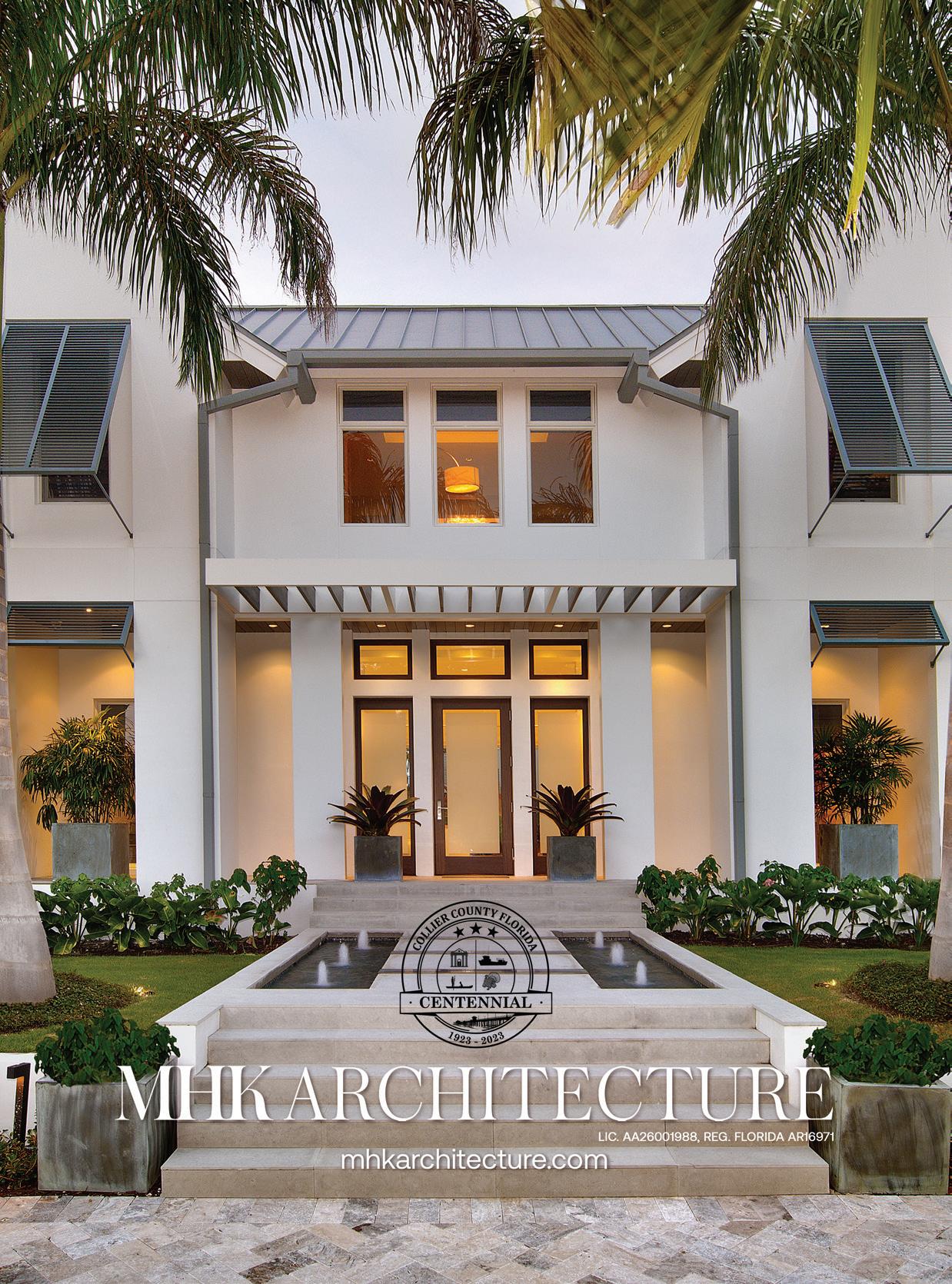
Several international heavy-hitters show up in the collection: Keith Haring, Hunt Slonem, Wolf Kahn, Eliot O’Hara (Richard gifted Charles an O’Hara Paris scene as a tribute to their travels to the City of Love). Still, about 40 percent of the collection is made up of local artists, and at least 90 percent was acquired through local art galleries (Harmon-Meek, Sweet Art, Gardner Colby, the defunct Eckert Fine Art) and fundraisers (Sidney & Berne Davis Art Center and United Arts Collier come up frequently in conversation). The couple has also introduced artist friends from New York and Pennsylvania to Naples. Steve Tobin, whose Nature Underground exhibit was at Naples Botanical Garden from 2020 through 2021, is a friend of theirs from Pennsylvania. “One of the reasons he got involved in Naples was because we introduced him to Myra Daniels, and she had a show for him at the museum,” Charles says of his first show here in 2012.
In the spare room’s closet, a stack of filing cabinets contains manilla folders with records for each artwork. Sometimes, a file has pamphlets for the exhibit or a note from the artist. Charles and Richard always document when the piece was purchased, where and for how much. Charles pulls out a folder. “Rainer Lagemann— let’s see what we say about him …” The German sculptor’s wire figures climb the walls of Sidney & Berne Davis Art Center in Fort Myers. A set of flying divers used to float from the glass-domed
While some pottery and objects have come from travels, 90 percent of the collection was sourced at local galleries or fundraisers. “If there was art that we liked and we knew it would benefit a purpose, we were always willing to purchase it,” Charles says.
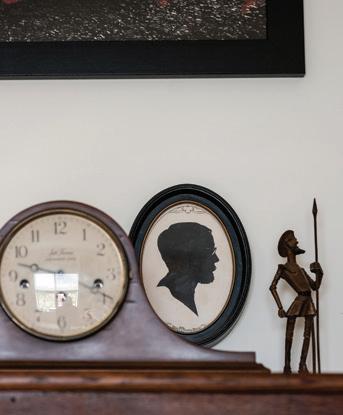

ceiling at The Baker Museum before it was remodeled. “He’s the one that did the wire bottom,” Charles says, referring to the metal form in the shape of a pair of glutes that rests atop a shelf in the guest room. He pulls out files outlining the artist’s process. “See, he made a form and then he would lay them all in there and weld them together to get these shapes. We learned about him because Frank Verpoorten had him hanging in the [Baker].”
And it’s not all visual art, Charles points out. “Here is Keith Lockhart; he was a conductor with the Naples Philharmonic and left to be the conductor of the Boston Pops. He came back for a show, and we had our picture taken with him.”
Behind the filing cabinets are stacked dozens more canvases they don’t have room to display, including Charles’ watercolors and Richard’s oil paintings. “He’s a beautiful painter,” Charles says of his partner of 62 years.
Though their collecting has slowed (“We don’t have any space left,” Charles says with a laugh), the duo won’t hesitate to get a work of art if it speaks to them, and they’re always eager to appreciate local art. Sometimes, that means going to the lobby to listen to musicians like Juilliard-trained Milana Strezeva play on the Samick grand piano they acquired from an auction at Sidney & Berne Davis Center and gifted to The Arlington. “I never thought I’d end up living in Naples,” Charles says. “But now I sure am glad we did.”
A MAXIMUM OF 490 TO 750 GUESTS , from the beloved Seven Seas Navigator® to the new Seven Seas Splendor™, delivers an enviable staff-to-guest ratio average of 1:1.5, providing the pinnacle of service.


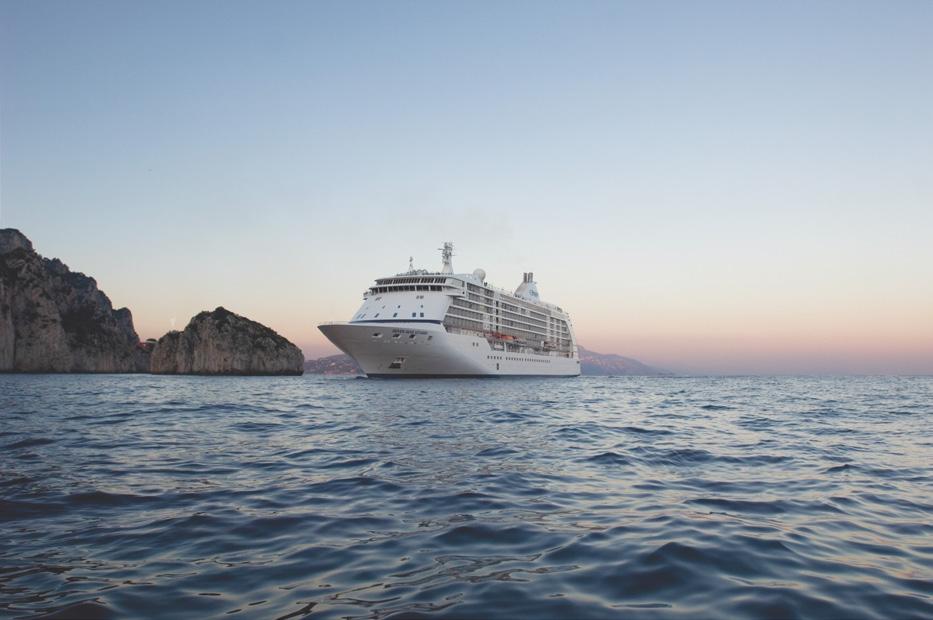

LARGE POOL DECK AREA where you can always find a private space or sun lounger.
MULTIPLE, FREE SPECIALTY DINING VENUES so there is never a crowd or a queue.


and activities.
TRULY CAREFREE TRAVEL where every detail is taken care of and every luxury is included, from FREE business class air to FREE drinks to FREE shore excursions and more.

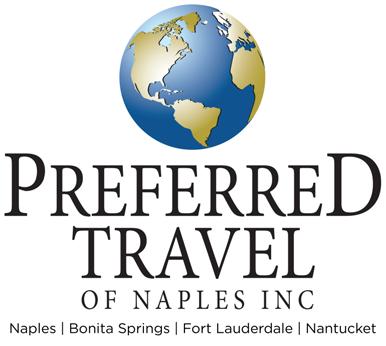
DYNAMIC EVENING ENTERTAINMENT with spacious seating and cabaret style tables for two. 5801 Pelican Bay Blvd #205 Naples, FL 3960

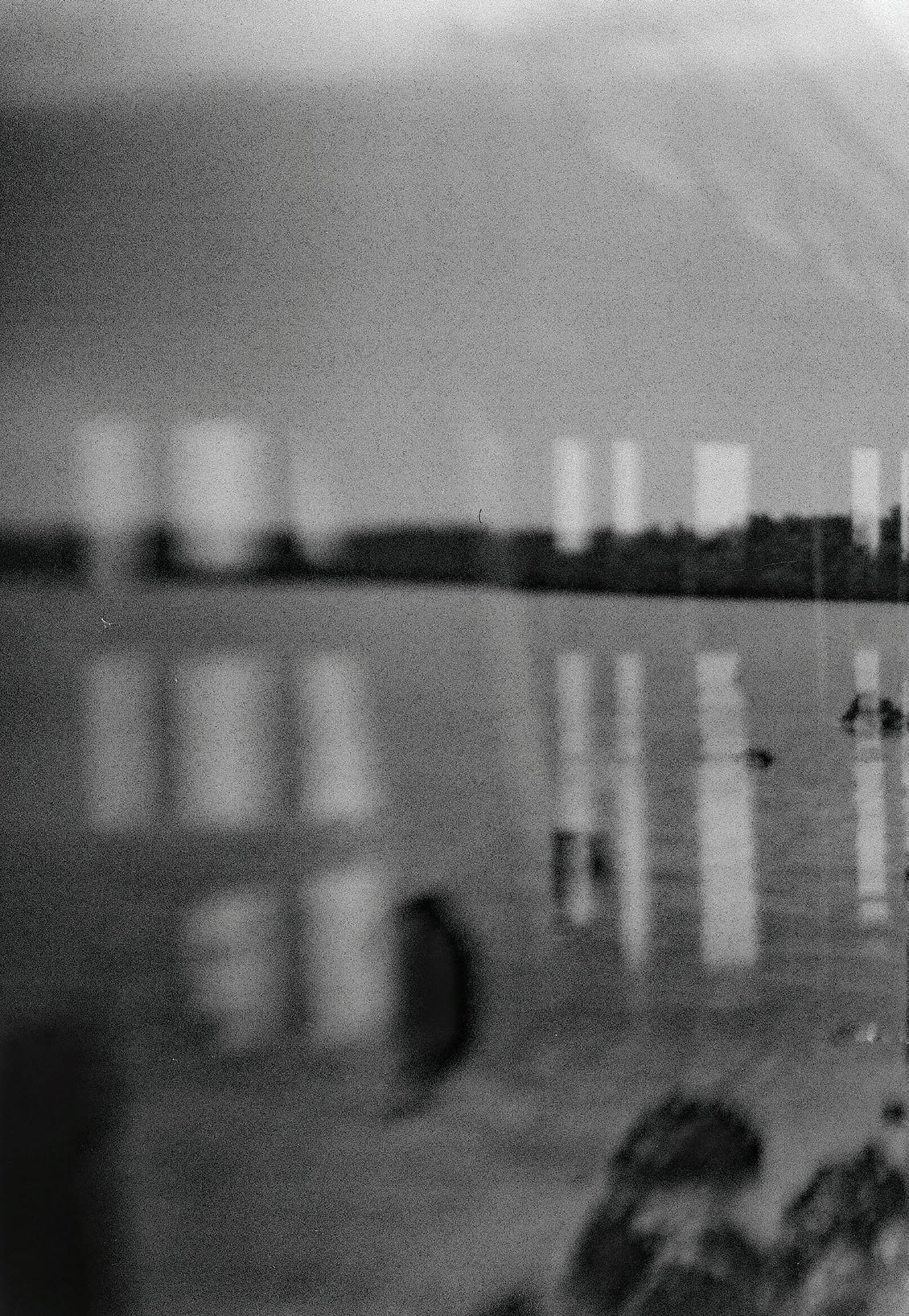
Photographer and museum curator Austin Bell captures historic Marco Island landmarks with a fresh vantage point.
Austin Bell adjusts his footing in the damp sand, carefully lifting his vintage Kodak Brownie Target Six-20 camera from a canvas bag. He’s about to photograph Old Marco Inn. Once one of the only buildings you could see when entering Marco Island, its waterfront views have long been shrouded by residences. “I’ve had to learn how to use these because they’re older than I am by far,” the 30-year-old says. “This camera has no settings; you pull a lever to take a photo. It’s actually very dif-

ficult to create a beautiful photograph, to compose and get the lighting right.”
You might know Austin as the curator of collections at Marco Island Historical Society’s museum, which he’s run for 10 years. Or maybe you’ve heard of his award-winning book, The Nine Lives of Florida’s Famous Key Marco Cat, detailing the famous Calusa artifact. (He also wrote a kids’ book on the subject and has produced a few historical Marco photography books.) Austin—who graduated from the University of Florida with a master’s in museum studies—wears many
hats, including director-at-large for the Florida Anthropological Society’s board of directors and chairman of the Collier County Historical Archaeological Preservation Board. His brainy extracurriculars sharpen his photography skills, developing his prowess in researching subjects. This September, his artistic momentum surges with a solo photography show, Re:Location, at Marco Island Center for the Arts.
Austin discovered photography in high school and has long favored dramatic stills of his home state. For the new series,
The photographs show historic structures superimposed against remnants from their past, like the Old Marco Inn seen atop Collier Bay inlet to represent the inn’s long-lost waterfront views, now obstructed by development.
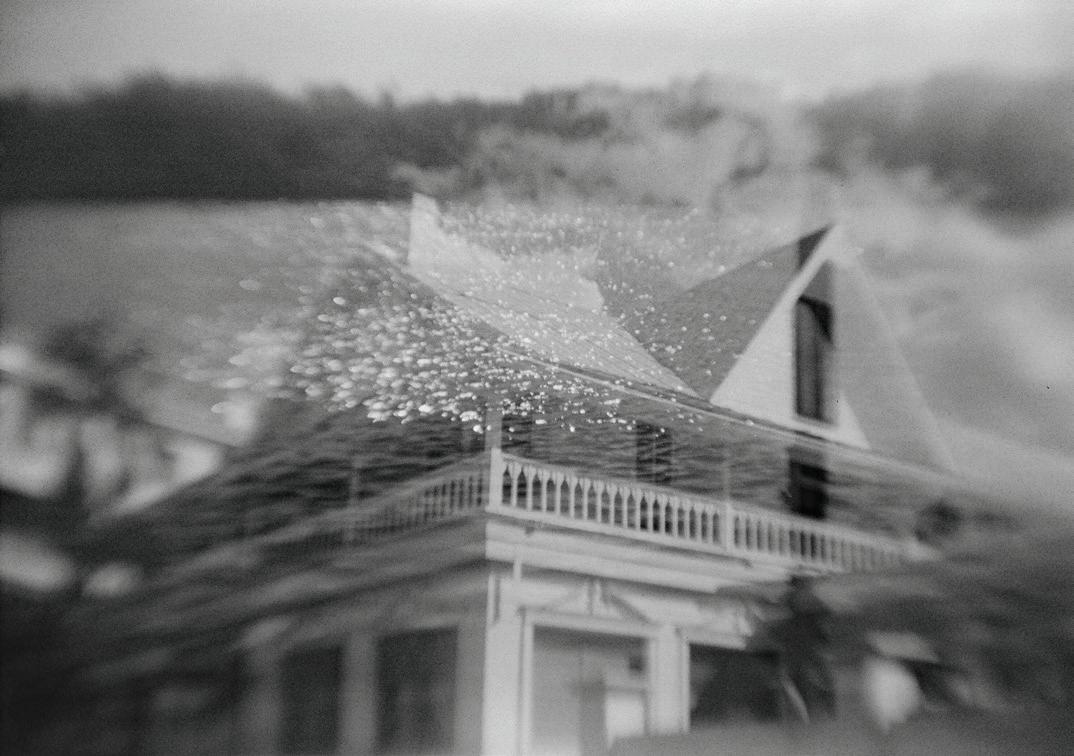
The new DBX707 is an SUV like no other. With blistering performance, supreme dynamics, unmistakable style and absolute luxury, it’s a car that dominates in every sense. But leadership is just the beginning. DBX707 showcases true engineering mastery to unleash new levels of dynamic performance. Try it for yourself at Aston Martin Naples.


he double-exposes images—shooting two photos on one frame—to superimpose historic structures against their former location or remnants of their past. The Old Marco Inn, for instance, is shown atop a capture of the Collier Bay inlet to represent the hotel’s former watery views that have since been obstructed by residential development. “The film
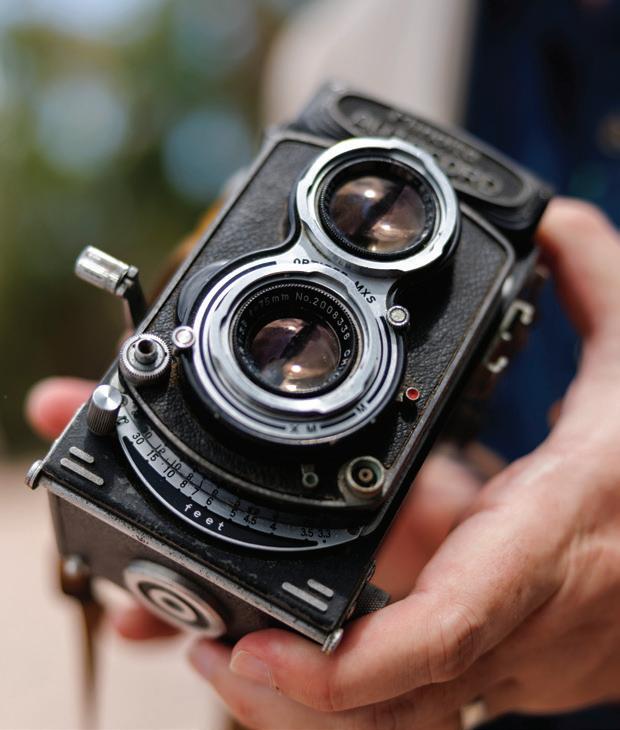

doesn’t actually move,” he explains. “If you lock the reel or forget to wind it, it keeps the same film frame in your viewfinder to get the double exposure.” In one photo, the current Goodland Bridge’s pale silhouette overlays the remnants of the former wooden swing bridge; in another, he places a 1920s cottage that was moved from the long-gone Caxambas village to
Margood Harbor Park in Goodland in the ’50s over a photo from the edge of a rare vacant lot in southern Marco, where the village stood. The photos preserve his subjects in a different light from the island’s Kodachrome palette. They’re bare and ghostly in their unretouched state, too heartfelt and solemn to be cheerfully, tackily nostalgic.

Austin captures the first and second images on the same frame. The superimposed photo speaks to the subject's history. Here, the Goodland Bridge is seen against the original wooden swing bridge that connected Marco to the mainland from about 1938 to 1975. The photos will be part of Austin’s first solo show, Re:Location , at Marco Island Center for the Arts in September.
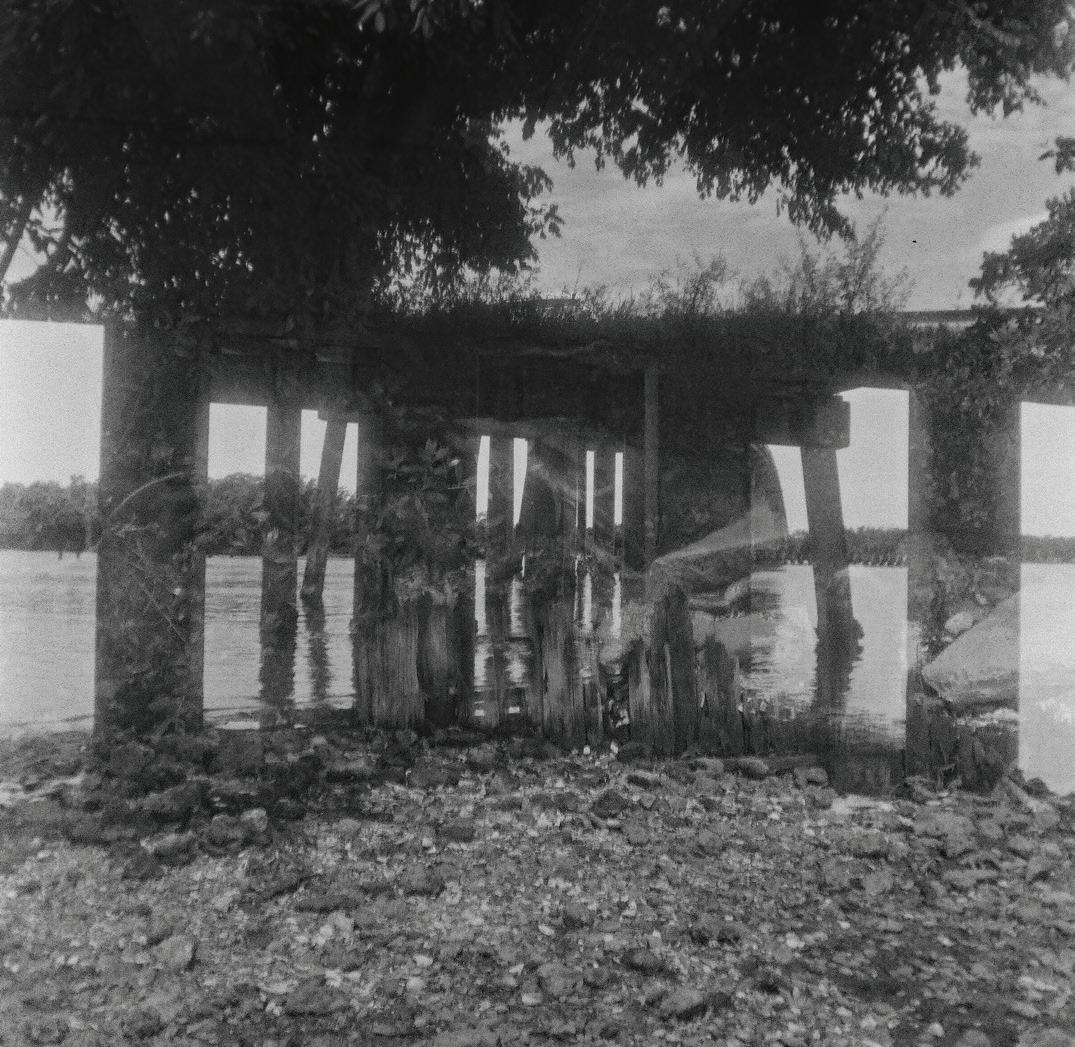
A SEASONED PROFESSIONAL. Amy’s focus is providing elevated service for her customers by listening to their needs, paying sharp attention to detail and providing solutions to navigate the ever-changing real estate market. With over 30 years of experience in the real estate industry, Amy spent 16 years specializing in the custom home market in the award-winning community of Mediterra before bringing her broad skill set to customers throughout the Naples luxury market.








“Top Notch! Professional, pays great attention to detail, her marketing strategy is impeccable.”
— Kimberly M.
RANKED IN THE TOP 1.5% OF REALTORS ® IN THE USA



Austin’s day job finds him enmeshed in Marco Island history, but Re:Location’s ethos could be applied to any Floridian town prone to rapid growth. The series breathes new life into regional lore. “Old Florida is increasingly rare,” he says. “These buildings are moving, but that might not be the last stop in their journey. It’s a way of documenting them, but with a little bit more meaning behind it.” It’s not unusual for historic buildings on our barrier islands to be uprooted and relocated for development. “I feel like it’s all endangered,” he continues. “Bringing these two spaces together—the old and new location—is a way to tell a story about that particular building.”
Austin began experimenting with film after his wife, Naples Botanical Garden exhibitions director Erin Wolfe Bell, bought him the 1940s Brownie Target. He now has a small fleet of 12 cameras. “They bring an authenticity to the image,” he says. Austin appreciates that his cameras date from around the same Postwar era.
He also likes the tactility of film. You can’t automatically manipulate your settings or check your progress as with a digital camera. Austin shoots the first subject, then the next one on one frame, often traveling to a second location in between. Since he can’t check the original
Coming soon from the developers of La Perle, comes Downtown Naples newest luxury condominiums, Inlet Quay. This exclusive 37-unit private waterfront retreat is located on the Gordon River. With 19 boat slips, boaters can enjoy a scenic ride straight to the Gulf. Centrally located in Downtown Naples, the shopping & dining districts of 5th Ave. S. & historic 3rd St. S. and Naples Airport are all nearby. For additional recreation enjoy one of the 24 neighboring Naples golf clubs.



Looking to soak up the sun at home? Each three and four-bedroom residence includes an expansive terrace. The onsite private amenities feature a stunning rainbow shaped pool, sunset viewing firepits, outdoor grilling spaces, a fitness center, social bar and perfectly appointed lobby. Inlet Quay is naturally enclosed by a border of protected mangroves.

It’s not just your life, it’s a style.
shot or skip forward to the next frame, he has to memorize the original framing and get the parallel alignment by sight and feel. He may make up to 24 stops with one roll of film in pursuit of the ideal image.
Austin’s setup is fairly minimal: he brings a few vintage cameras, a tripod and a journal. “I keep a journal to annotate which image is currently in the viewfinder to remember what I’ve shot, and in case I need to take the second image on another day.” As a Marco Island resident and through his work at the Historical Society, Austin knows his town well, but he’ll also scour maps to research routes between sites. “I revisit the places until I get the perfect shot,” he says.
He’s content if just one negative in a whole roll turns out well enough for him to include in Re:Location. He ships his film to a longtime photo lab in New Hampshire to be developed in their darkroom and printed. “One advantage of making these on film is that, in 20 years, the film will still be there, and you can bring it into a darkroom and change and alter it then,” Austin says. His goal, as he rediscovers long-forgotten island sites, is to revisit the film years from now in a darkroom of his own.
He looks down fondly at the Brownie Target in his hands. It’s an understatement when the curator-cum-photographer says, “I like to bring life to old things.”









Naples is already blessed with a bounty of world-class live entertainment. And, with a slate of remodels, new state-of-theart venues, expansions and fresh faces, things are looking even brighter in Collier County’s performing arts world.
Perhaps the most anticipated, Gulfshore Playhouse is well underway on constructing their Baker Theatre and Education Center, slated for completion in spring 2024. Nestled on Goodlette-Frank Road, walking distance from Naples Design District, the H3/Arquitectonica- and Lisa Kahn-designed marvel will house a 350-seat theater, a 125-seat studio, and spaces for events and educational programming. CEO and producing artistic director Kristen Coury—recently appointed to the Florida Council on Arts and Culture by Florida Senate President Kathleen Passidomo—imagines the space as a cultural hub. “The arts are a magnet and a driver of growth,” Kristen says. She’s also working with Barron Collier Companies to build a production studio and doubling her staff to ensure Broadway-quality costumes, sets and props for their shows in the new space, expected to open for the troupe’s 20th anniversary season in fall 2024. Kristen fittingly coins their last performing season at The Norris Center “A Toast to the Future.”
Downtown, at 70-year-old The Naples Players, the sound of patrons swinging hammers followed The Sound of Music at a groundbreaking for the theater in April. Architect David Corban designed the modern, wood-clad space, adding a balcony to the main theater his former boss, the late celebrated architect
Andrea Clark Brown, initially created in the ’90s. The Players also plan to add an open second-story atrium view and a small theater above the first-floor studio. Until the $17 million expan-

With new theaters and conductors, buzzy Broadway shows and rising talent, we see big things on the horizon for Collier County’s performing arts scene.

sion is completed next March, the troupe performs at venues around the city, including an outdoor performance of It’s a Wonderful Life (Live Radio Play) in downtown Naples in December.
Across the Jolley Bridge, Marco Island Center for the Arts (MICA) launched the Arts Center Theatre last season. After the island’s longtime company, The Marco Players, closed its doors to the Town Center theater, executive director Hyla Crane recognized the void and moved in. The theater adds to MICA’s robust season of exhibitions, musical interludes and comedy nights. Last season set the stage with thought-provoking shows like their gender-bending version of Neil Simon’s The Odd Couple. Next, Hyla starts the second season at Arts Center Theatre with The 39 Steps, a can’t-miss comedy merging Hitchcock’s thrill with Monty Python’s absurd humor.
But, it’s not all thespians making waves in Naples’ performing arts. Opera Naples makes a splash in the spring with their increasingly popular Opera Under the Stars festival, bringing talent from across the globe to fill Cambier Park with soaring sopranos and bellowing baritones. “This is something you typically only see in cool, European cities,” gushes Gulfshore Playhouse’s Kristen, who sees Naples as a flourishing arts destination. In other music news, Nash to Naples returned for the
second year in 2022 to Cambier Park to feed the city’s love for country music. The festival brings songwriters from Music City, U.S.A., including budding artist Johnny McGuire, who shot to fame for his “Chevys & Fords” hit with Billy Ray Cyrus.
On the classical front, Artis—Naples welcomes two new leaders: British conductor Alexander Shelley leads the Naples Philharmonic Orchestra, and local jazz artist Brandon Robertson steps in as the director of the Youth Jazz Orchestra. As upcoming music and arts director, Alexander plans for an interdisciplinary season. “Now, as much as ever in history, joining the dots between artistic genres and endeavors helps our audiences, and helps us on stage, to be more fulfilled through the storytelling,” Alexander says. We’re beyond excited to see what the young leaders bring to the established arts center.
We look back to the early ’80s when philanthropic arts maven Myra Janco Daniels’ saw her vision for a world-class arts institution come to life with The Naples Philharmonic, now Artis—Naples. At the time, Myra recognized a void of artistic opportunities in a town full of well-traveled art aficionados. We think she would be incredibly proud to see her adopted hometown thriving as an arts community where one can attend a live performance nearly any night of the week.
Major overhauls for longtime Naples institutions, Gulfshore Playhouse and The Naples Players, signal more great things to come for the performing arts.
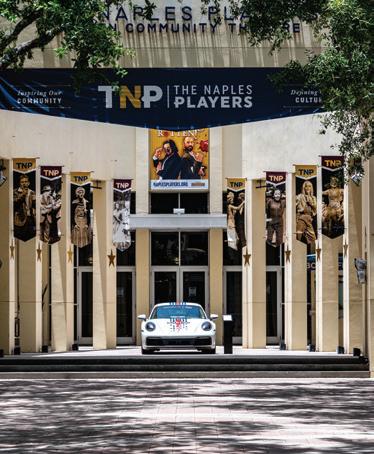






Five Seminole descendants represent the early days of our region, before Collier became Collier, carrying on their tribe’s artisanal and artistic traditions.
 By Lauren Amalia Redding
Photography by Anna Nguyen
By Lauren Amalia Redding
Photography by Anna Nguyen
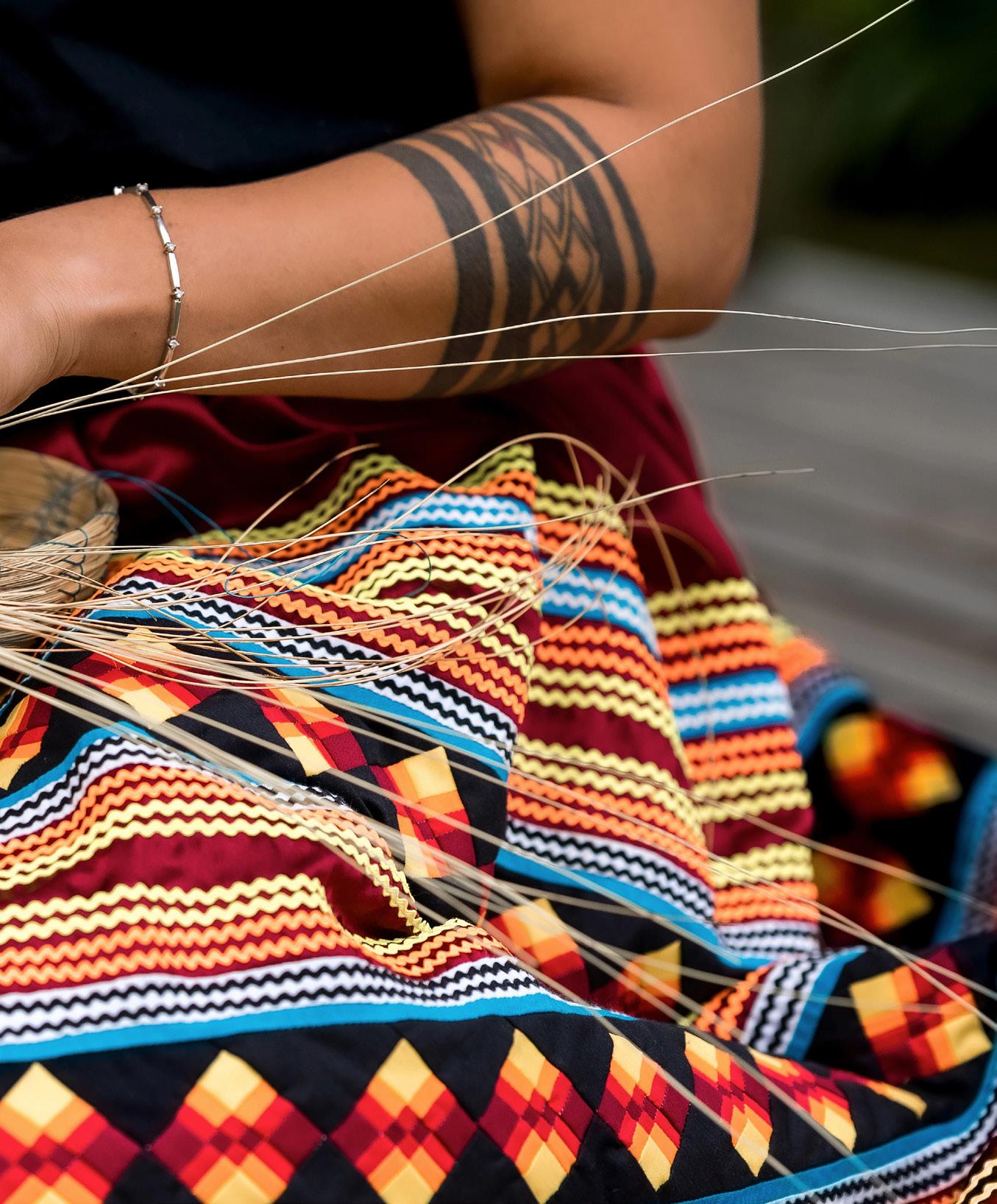
Marissa Osceola is skilled in weaving sweetgrass baskets, which she says is a nearly lost art. Made mainly from strands of native sweetgrass, the fibrous material is coiled and woven to create beautiful vessels. Marissa learned to weave from her sister, Jessica, who used to teach classes at the Juanita Osceola Center.

It’s early morning as the Osceola-Zepeda crew caravans along I-75 to Hollywood, where Florida’s Seminole Tribe hosts an annual powwow and fair. There, they’ll connect with fellow parents and children dressed in colorful patchwork garments, reveling in their storied culture and customs. These are the true Floridians: people who lived on the land long before Barron G. Collier brought Tamiami Trail through the region or established the county in 1923. They worked with nature to thrive as a community of artists, hunters, gatherers and storytellers.
Sisters Marissa, Jessica and Karie Osceola and their cousins—who they consider brothers—Pedro and Brian Zepeda are proud, prominent members of Florida’s largest Indigenous tribe, the Seminole. You may recognize the Osceola name—perhaps from their grandfather-figure (their great-uncle) legendary chickee hut maker O.B. Sr. Their great-grandmother, Juanita, is the namesake for Naples’ Juanita Osceola Center, a hub for Seminole culture and education.
The younger Osceolas fully embrace their ancestors’ artisanal traditions and dedicate much of their professional and personal
lives to preserving them. Jessica, the middle of three sisters, smiles when she reflects on artistic Seminole practices: “It’s a community process and individual sport all in one.”

The Osceola-Zepeda siblings fondly recall growing up in Collier County in the ’80s and ’90s. While they relish memories of their family’s involvement in the community, the region’s rapid growth has overshadowed much of the Indigenous culture’s presence. “The amount of development led to a lack of planning,” Pedro laments. Karie chimes in: “Most individuals I come across are surprised to learn that native people are still present in Collier County. The average citizen needs to be made aware that tribal people still exist and are thriving.”
The elder siblings grew up in the area, learning from their seamstress grandmother Tahama Osceola and watching their elders sew, weave and carve in open-air chickee huts at the now-gone Seminole village on Tamiami Trail and inside the Juanita Osceola Center. (Marissa, the youngest by about a decade, credits her grandmother Susie Jimmie, who made all of Marissa’s childhood clothing—for inspiring her to sew.) Now, as
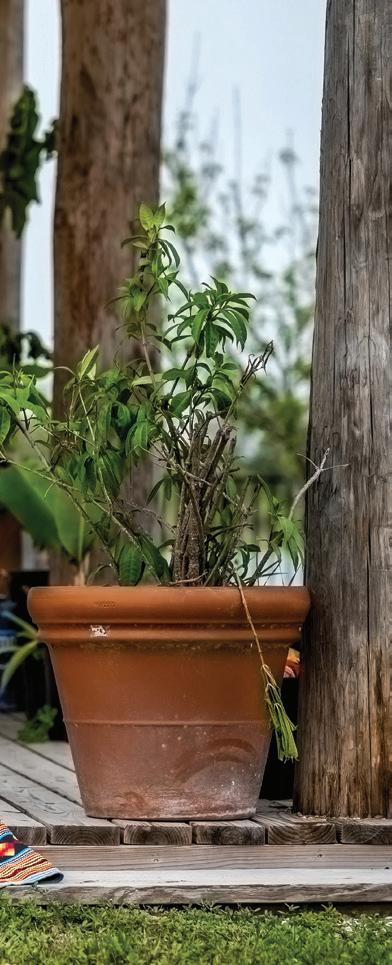
parents, they ardently pass the traditions to their children. “Our culture is made of many little pieces, and we all do our part to carry on what we can and pass that on to the next generations,” Marissa says. Here, we trace each sibling’s craft and how they work to keep their traditions current and appreciated.


you make it for your family because those things are so treasured.”
Marissa, the youngest of the group, tackles many of her culture’s crafts, passing on lessons she gleaned from big sisters and her grandmother, Susie Jimmie. She’s already teaching her 3- and 6-year-old children to bead Seminole necklaces. Sitting around the kitchen table, little hands pick from bowls of leftover “bead soup” to string various colors into single-strand friendship necklaces to gift to their “Granny” or friends. “It keeps them busy,” she says with a laugh. Her daughter started beading when she was 2-years-old, while Marissa worked through online college courses. “If you have a craft,
Marissa recently returned to Naples after living in North Carolina and New Mexico. Back home, you might find her beading, sewing or weaving sweetgrass baskets—a nearly lost art form. Palmetto fibers provide a sturdy base for the baskets, made mainly from strands of native sweetgrass, also known as muhly grass. The fibrous material is coiled and woven to create beautiful vessels, now mostly limited to decorative pieces. Marissa learned to weave from her sister, Jessica, who used to teach classes at the Juanita Osceola Center. Now, other tribe members offer basket-weaving kits and lessons to help keep the art alive.
More recently, Marissa has started to focus on Seminole patchwork textiles (she’s perfecting her grandma Susie’s signature diamond patchwork in her honor), which, to her, epitomize the craftsmanship shared when a tightly-knit community of women comes together: “My first patchwork was made at my sister Karie’s kitchen table when I was a kid.”
The Weaver: Marissa OsceolaAs a ceramics professor at Florida Gulf Coast University, Jessica, the middle sister, is versed in many historic Seminole crafts, from ceramics to patchwork to basket-weaving to sewing tiny dolls with traditional Seminole clothing. Her specialty is bas-relief sculptures that reflect on her culture with emotive self-portraits.

Brian, the eldest of the Osceola-Zepeda clan, portrays his ancestors in reenactments, like the Dade Battle event at the namesake state park—the site for the largest American-Indian war. The eldest sister, Karie (below and on following page), says traditional Seminole patchwork is designed to tell stories; each patterned strip of fabric or colorful ric-rac hem has meaning. She makes most of her pieces for her family and often incorporates their grandmother’s favorite color, red.


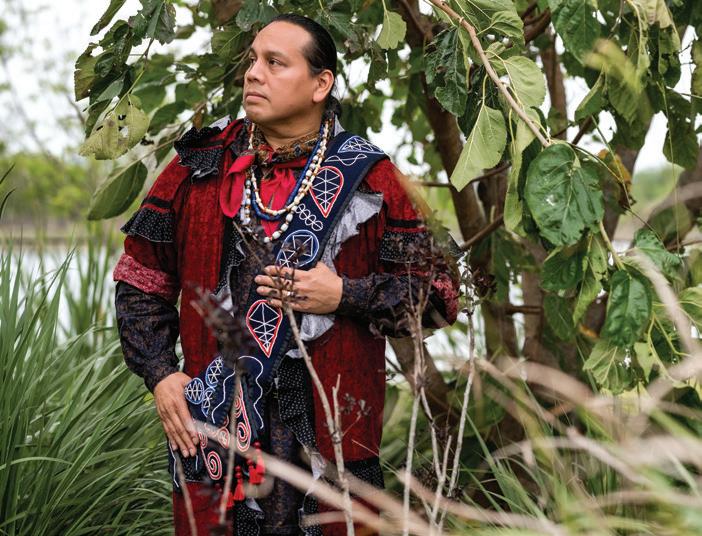
The Seamstress: Karie Osceola Marissa and Jessica describe Karie as their “sewing mentor,” but the eldest sister demurs—probably because she learned textile arts at a later age than her siblings. “As I grew older and started my own family, I gained much more interest in cultural arts and crafts,” Karie says. “After having kids, I figured it was best for me to learn sewing to provide traditional clothing for my family.” While she’ll sometimes sell her patchwork skirts and jackets at farmers markets and Indigenous fairs, most of Karie’s pieces are made for her family. In recent years, she’s enlisted her teen daughter, Angelina Osceola-Lugo, to help. They were both proud to see one of her first skirts sell quickly at a fair.
Traditionally, Karie explains, patchwork is designed to tell stories, with each patterned strip of fabric or colorful ric-rac hem representing an aspect of the narrative. You may find blue vertical stripes to dictate rain or zigzagged lines in black, red and white to signify lightning. Other shapes resemble a man on a horse or the pattern of a rattlesnake’s scales. The order in which the pieces are sewn, she says, reflects the story’s timeline. Karie recently converted a garage to a home studio, where walls of shelves stock various swatches of fabric, ric-rac and thread in vibrant hues. A mannequin anchors the space, donning recent creations to spark inspiration for her next pieces. Many of the garments she makes for her family feature bright red fabrics, to honor their grandmother Tahama’s favorite shade.

The artful patchwork makes up much of the Seminole’s vibrant garments, taking the form of long, loose-fitting jackets and voluminous skirts. Strips of cotton fabric—which the Seminole once acquired from trading posts—are stitched together to create intricate geometric patterns and shapes. Pieces are then sewn into wide swatches to compose the jacket or skirt’s entire textile. “I knew that my grandmas and aunts were not going to be able to sew forever,” Karie says wistfully. “And I believe the shift of responsibility was mine to take on.”
The Artist: Jessica Osceola

Jessica, the middle child of three girls, picked up on more than a few of her family’s artistic customs. She’s a prolific sewer—her textiles were on view during the latest art department staff exhibition at Florida Gulf Coast University (FGCU). The colorful works also filled the Marco Island Historical Museum in an aptly titled 2021 solo exhibition, Creating Home. And, a graduate of San Francisco’s Academy of Art University, Jessica is uniquely skilled with clay and teaches ceramics at FGCU. She’s known for her self-portraits, done in bas-relief sculpture, working with a shallow panel of clay to chisel prominent cheekbones and detailed layers of Seminole beads.
Regardless of the medium, her work is no stranger to museums. Sarasota’s The John and Mable Ringling Museum of Art recently acquired three of her ceramic portraits, which explore her mixed-race heritage (her Midwestern mother is Irish), for their collection. And, together with canoe-carver
Pedro and multihyphenate Brian, Jessica is exhibiting in the Ringling’s seminal group exhibition Reclaiming Home: Contemporary Seminole Art. On view until early September, it’s the museum’s first show highlighting artwork created by Indigenous artists.


Working out of the micro-farm homestead she shares with her husband and their two kids, Jessica takes photos of her face and body, which she uses to create the bas-relief sculptures that emphasize emotion. In the pieces, she reflects on her heritage, her feelings as a mother, the legacy she’s leaving for her children and the world, and the importance of keeping her Seminole family’s traditions alive. “There’s a sense of identity and legacy in the importance of carrying on to my children,” she says.
Brian lives and breathes his Seminole heritage. One can often find him donning handmade garments during authentic reenactments of Seminole history, including the
annual Dade Battlefield Historic State Park— the site for the largest American-Indian war—gathering in January. He’s a respected storyteller and educator, often teaching Seminole arts and crafts as a guest lecturer at universities and museums throughout the state. Far from stuffy, watching Brian lecture is more like a conversation with a friend. He weaves a mix of Seminole legend with modern advocacy to put his heritage at the forefront. At the 2022 Florida Folk Festival in White Springs, Brian spoke about the importance of clean water in Seminoles’ lives and how to work with legislators to ensure they have access to such. He’s a frequent speaker at the 71-year-old event.
He’s also a skilled craftsman: building canoes, silversmithing and constructing chickee huts. One day, he might be trekking through the Everglades, camera in tow; the next, he’s carefully beading a panel belt for his traditional outfits. “I take my role as a teacher and student of my culture very seriously,” Brian, the eldest of the group, says.
Dugout canoes are integral to the Seminole culture. Pedro Zepeda learned to carve the vessels by hand from his brother, Brian, and other relatives. He uses sinker cypress to avoid felling more trees.

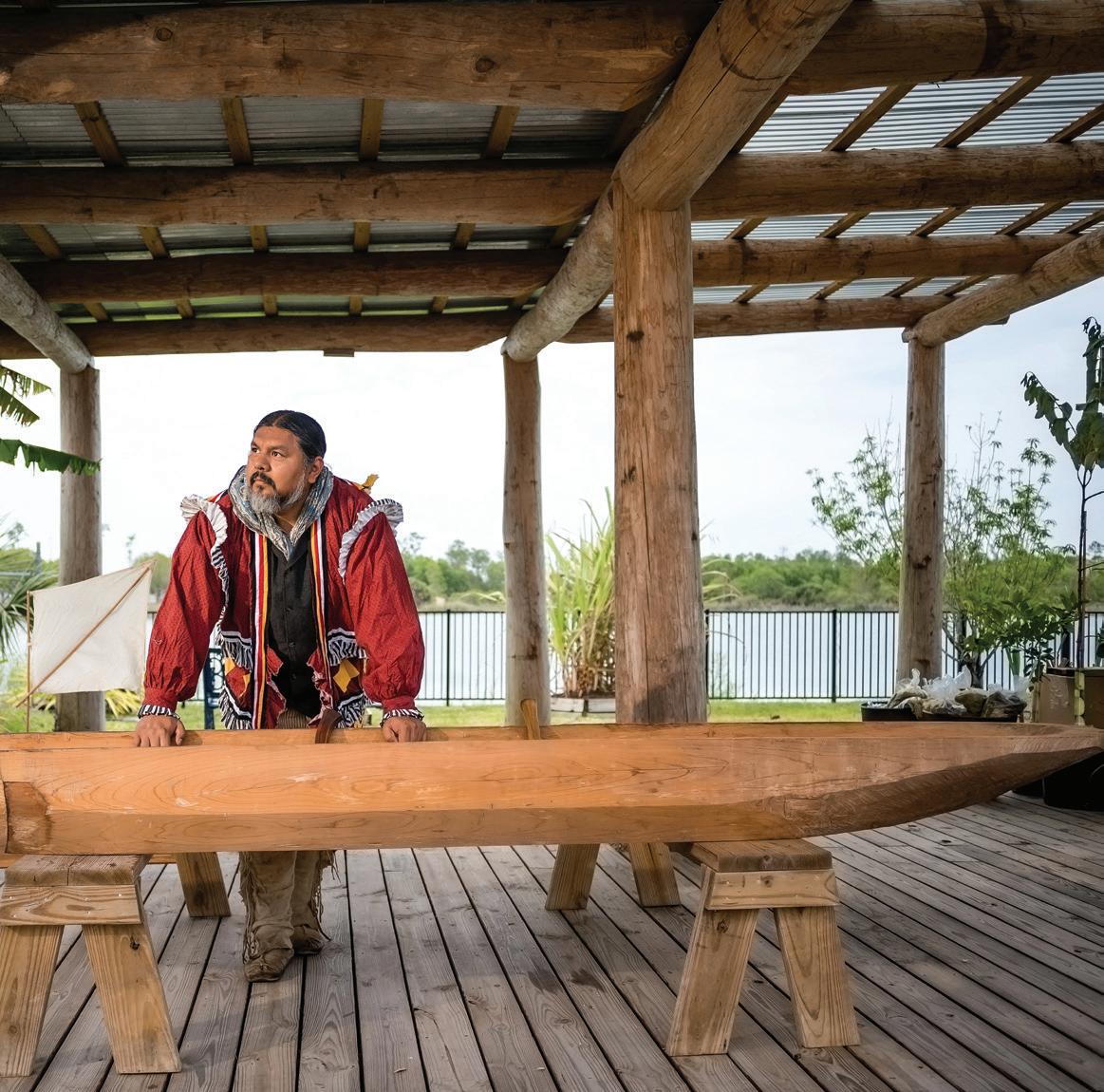
The Osceola-Zepeda cousins consider each other siblings. They’re determined to keep Seminole stories and traditions alive. “Most individuals I come across are surprised to learn that native people are still present in Collier County ... tribal people still exist and are thriving,” says Marissa, the youngest. All clothing and art pieces shown were made by Osceola family members.
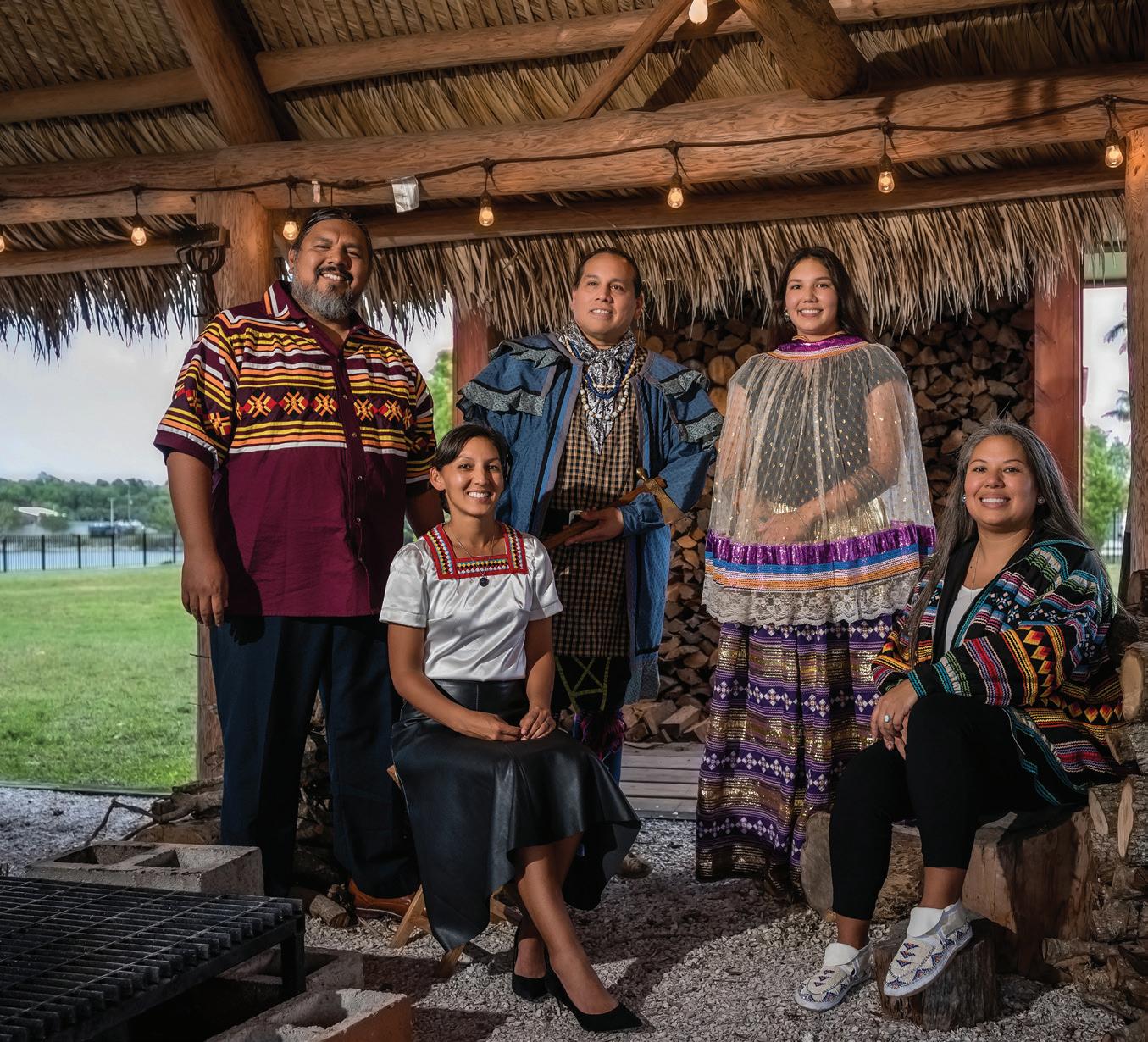
“My grandpa used to tell me, ‘If someone takes the time to teach you something, then you need to take the time to learn.’”
He’s one of about six Indigenous artists in the U.S. who makes beaded bandolier, or shoulder, bags. The tactical wool bags were used to carry supplies, often for sharpening knives or building fires. The entire piece, including the straps, is encrusted with thousands of minuscule seed beads, which Brian painstakingly embroiders into custom designs. The beads–which the Seminole acquired through trade with settlers–are so small that one can hover around the size of a single letter on a penny. “It can take anywhere from four months to two years to complete one [bag],” he says. His intricate bandoliers, alongside his belts and photography, take center stage at the Ringling exhibition. His daughter, Corrine Zepeda, is also showing at the Ringling. Her graphic illustration of a Seminole man (strongly resembling her father) in signature Osceola red garb navigating a traditional dugout canoe is on full display spanning a wall at the exhibit’s entrance.
Much like his siblings, Pedro is keen on preserving Seminole crafts. After studying ceramics at Stetson University, Pedro returned to Southwest Florida to take over as the Seminole Tribe’s traditional arts and outreach coordinator at the Ah-Tah-Thi-Ki Museum
in Big Cypress Seminole Reservation. Leading the programs from 2007-2013, Pedro honed curricula and taught traditional Seminole arts to the public and fellow tribe members. In the role, he mastered a panoply of crafts, including fashioning bows, arrows and leather goods using the same materials and methods from generations before. He credits Brian, along with other tribe members, for teaching him his most prized art form: dugout canoe building. The canoes are integral to the Seminole lifestyle. Carved by hand, the vessels are driven using a long pole to change pace or direction throughout the swamps. Pedro says locating an ideal log (preferably cypress) is the first and most daunting step. He avoids felling new-growth trees, and instead searches for sinker cypress, dropped in rivers as they were on their way to sawmills more than a century ago. “My grandparents would just use a standing cypress, but at that time, there were many more cypress trees than there are now,” he says. Once he’s found the perfect log, he’ll use chainsaws and axes to shape the canoe’s exterior shell and carve the dugout recess inside. Then, Pedro uses traditional carving tools, including adzes, scorps and inshaves, to refine the canoe by hand. The whole process can span weeks. “When we make these items, they’re not just objects. They contain knowledge,” Pedro says. “So if you lose the object, you’re also losing all the cultural knowledge that comes along with it, like stories, cultural etiquette, language.”



Teamwork is integral to Moran Wealth Management ®. The firm's founder, Tom Moran, who serves as the Chairman, CEO, and Chief Investment Officer, has assembled an impressive team of more than 35 professionals. These dedicated individuals prioritize their client’s needs above all else, providing tailored solutions to each client’s objectives. The firm operates in a unique niche in the private wealth management market, with over $4.0 billion in assets under management. The fee-only, 100% employee-owned fiduciary proudly serves Naples and beyond.
Moran Wealth offers the services of any large institution while providing the highest level of personal attention. The firm’s clientele includes successful individuals and their families seeking to build generational wealth, as well as corporations, non-profit organizations, and family offices looking to grow and protect their assets.
The team’s collective financial experience provides objective guidance and advice to help their clients make informed financial decisions. Perhaps it’s time for an independent review of your financial strategy. Consider contacting their team by calling 239-920-4440 or visiting moranwm.com to find out how this extraordinary team of advisors can help you achieve a portfolio strategically designed to care for your family now and in the future.



Since 1990 Tom Moran AIF®, Chairman, CEO and CIO has been helping families in Naples make important investment decisions. Over his 30-plus years in SWFL he’s built a local team of over 35 professionals dedicated to providing focused strategies and world-class service.


“I have had the pleasure of working with Rich Weisberg in both a professional capacity as well as in the context of community advocacy for several years. I have consistently found Rich to be highly knowledgeable, a man of integrity, and committed to excellence in all he endeavors. I also deeply appreciate Rich’s leadership and dedication to serving our community and advocating for compassionate care for those needing of support.” – Scott
Burgess, CEO, David Lawrence Mental Health CenterThe statement is a testimonial from a current client as of 4/21/23 and may no longer be applicable or a client. No compensation was paid in exchange for the testimonial, it was not solicited by the advisor, and client consents to use of this testimonial in the advisor's advertisements. The testimonial is not representative of all client's experience with the advisor, not based on performance, and not a guarantee of future performance or success. Investing involves risk and isn't always profitable.
”I have worked with Richard Weisberg for many years. He is a man of personal integrity and possesses an in-depth and practical knowledge of financial markets. It is without hesitation or reservation that I enthusiastically endorse Weisberg Wealth Management.” –
Edward Morton, Director, Glencoe Diversified HoldingsThe statement is an endorsement from a non-client as of 4/24/23 and may no longer be applicable. No compensation was paid in exchange for the endorsement, it was not solicited by the advisor, and non-client consents to use of this endorsement in the advisor's advertisements. The endorsement is not representative of all client's experience with the advisor, not based on performance, and not a guarantee of future performance or success. Investing involves risk and isn't always profitable.
Having been in the Financial Industry in Naples since the mid 90’s, Rich is dedicated to providing the community sound financial guidance for both individuals as well as Foundations, Endowments, and Corporate and Non-Profit Retirement Plans. Weisberg Wealth Management is located in the heart of downtown Naples on 5th Avenue South.




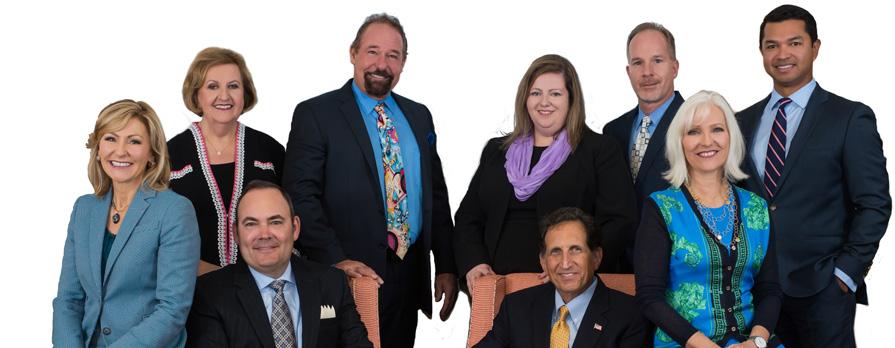
Rob Edwards believes that people deserve to enjoy their money in every stage of life.
Through his firm, The Edwards Group of Wells Fargo Advisors, clients enjoy a truly unified wealth management experience that helps unlock the full potential of their wealth, allowing them to live the best version of their life.

Their slogan: Let your money serve you.
Named by Forbes as a Top Next-Gen Wealth Advisor in 2022, Rob brings a forward-looking approach to wealth management, organized around a new and better client-focused model. One that emphasizes integrity, trust, and transparency above all else. One that helps clients understand their options and make more thoughtful decisions. One that doesn’t outsource money management to distant third parties. And one that attracts empathetic financial professionals, dedicated to meeting clients’ needs.
The hallmarks of his team’s mission include:
• A clients-first philosophy of financial advice and stewardship
• A process designed to keep clients on track to achieve their goals
• Portfolios built to help clients weather most market conditions
To elevate your wealth management experience so that your money can do more for you, visit The Edwards Group at EdwardsGroupNaples.com.
ROB EDWARDS Managing Director – Investments & Senior PIM® Portfolio Manager5801 Pelican Bay Blvd Ste. 200, Naples, FL 34108 l Phone 239.254.2394

The
EdwardsGroupNaples.com
Forbes Top Next-Gen Wealth Advisors (AKA America's Top Next-Gen Wealth Advisors) rating algorithm is based on the previous year’s industry experience, interviews, compliance records, assets under management, revenue and other criteria by SHOOK Research, LLC. Investment performance is not a criterion. Self-completed survey was used for rating. This rating is not related to the quality of the investment advice and based solely on the disclosed criteria. Wells Fargo Advisors is a trade name used by Wells Fargo Clearing Services, LLC, Member SIPC, a registered broker-dealer and non-bank affiliate of Wells Fargo & Company. © Wells Fargo Clearing Services, LLC. All rights reserved. CAR 0523-03131. Investment and Insurance Products are: Not FDIC Insured / No Bank Guarantee / May Lose Value
At Fifth Third Private Bank, we’re here to help you write your story. It starts with a dedicated, local Wealth Management Advisor, backed by a team of financial professionals and digitally enabled solutions.
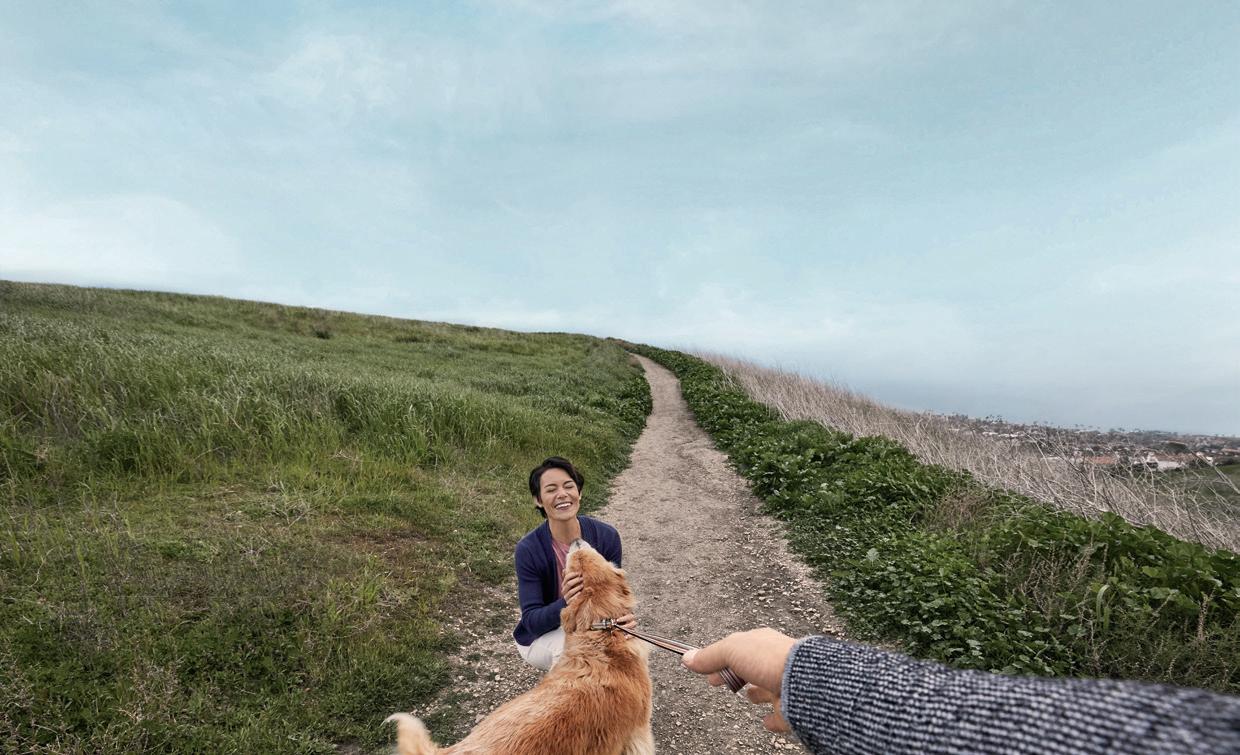
For individuals and families with complex banking needs, Fifth Third Private Bank offers a comprehensive suite of deposit accounts, lending options, and credit cards available exclusively to our Private Bank clients.
We bring more than 160 years of experience as trusted advisors to high net worth and ultrahigh net worth individuals and families. We’ve been named one of the World’s Best Private Banks by Global Finance for four consecutive years.*
Selecting the right wealth management firm is a complicated and personal decision. We’re to answer any questions you may have. To get in touch with a local advisor, call 239-449-7046.

Fifth
53.com/privatebank


If your goal is to enrich your portfolio and protect the wealth you’ve already built, or you want to ensure your family is cared for now and in the future, you can trust FineMark to act in your best interest, every day.
Our seasoned professionals provide comprehensive investment management, retirement planning, and trust services, tailored to your unique circumstances. We are always available to help coordinate the financial aspects of your life in one place, with one team.
Exceptional client service is our hallmark, and we are dedicated to helping you achieve peace of mind.


The Kellam Group of Truist Investment Services, Inc. is a forward-thinking wealth management team comprised of deeply committed professionals, offering tailored advice and guidance and a highly-engaged standard of care to a select group of affluent families, business owners, and corporate executives both locally and around the country. Their mission is to become an essential partner to clients by way of experience, resources, and passion for making a difference while helping clients identify and pursue their vision of financial success at any stage of life. If you are considering a change, The Kellam Group is excited to meet you.
801
Floor, Naples, FL 34108 l Phone 239.249.5080
For over a decade, Shane and Julie, both Naples natives, have dedicated their lives to helping clients reach their financial goals. Families, individuals and businesses rely on them to provide sound, fiduciary advice and to deliver top notch solutions.


Shane Kelley CRPC™, CPFA®, Senior Vice President, Senior Portfolio Advisor, is a graduate of Naples High School. As a football student-athlete at Brown University, he earned All-Ivy and All-New England honors, while earning a Bachelor of Arts in Economics. He also holds a Master's degree from the University of Miami. Shane is involved with various local organizations, including coaching his son’s Little League team, and serves on the board of the Winged Foot Scholarship Foundation.
Julie Mcfalls, Financial Advisor, is a lifelong equestrian and works with a local nonprofit to provide the opportunity to ride horses on a no cost, scholarship basis to children and special needs adults. She has three children, with whom she is active in their local 4H chapter.
MERRILL LYNCH WEALTH MANAGEMENT

9128 Strada Place Suite 301, Naples FL 34108 l Phone 239.649.2941 www.fa.ml.com/kelley_mcfalls
Merrill Lynch, Pierce, Fenner & Smith Incorporated (also referred to as “MLPF&S” or “Merrill”) makes available certain investment products sponsored, managed, distributed or provided by companies that are affiliates of Bank of America Corporation (“BofA Corp.”). MLPF&S is a registered broker-dealer, registered investment adviser, Member SIPC and a wholly owned subsidiary of BofA Corp. Investment products: Are Not FDIC Insured; Are Not Bank Guaranteed; May Lose Value
J.P. Morgan Private Bank provides customized financial advice to help wealthy clients and their families achieve their goals. Clients of the Private Bank work with dedicated teams of specialists who bring their investments and financial assets together into one comprehensive strategy, leveraging the global resources of J.P. Morgan.
Whether you’re focused on building, preserving or transferring your wealth, our team in Naples is here to help you achieve all you envision. The specialists in our Park Shore office work to meet your goals with an elevated private banking experience that’s shaped around you and your family. It’s one way we’re raising the standard in private banking.

*Global Finance Magazine, 2023. Awards or rankings are not indicative of future results.

JP MORGAN PRIVATE BANK IN NAPLES
850 Park Shore Drive, 3rd Floor, Naples, FL 34103 Phone 239.263.1325 | PrivateBank.jpmorgan.com/naples
The Matina Group is a nationally recognized UBS accredited Private Wealth team with offices in Naples, FL, Short Hills, NJ and New York City.
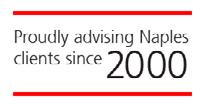
"The Matina Group is a boutique private wealth management team comprised of accomplished professionals, created in the likeness of the multigenerational clients we advise. A boutique team, thoughtful advice, customized solutions and exceptional client experience are the foundation of everything we

Areas of focus:
• Financial planning strategies
• Multigenerational families
THE MATINA GROUP
• Investment management
• Business transition
• Trust and estate planning strategies
• Women and wealth.
The Matina Group
UBS Financial Services Inc.
Private Wealth Management

801 Laurel Oak Drive, Suite 500 Naples, FL 34108 239-249-5011
877-452-4344 toll free
801 Laurel Oak Drive, Suite 500, Naples, FL 34108 | Phone 239.249.5011 Advisors.ubs.com/MatinaGroup advisors.ubs.com/matinagroup
Joseph Matina Managing Director–WealthManagement joseph.matina@ubs.com
Amy West, CTFA Senior Vice President–Wealth Management a.west@ubs.com
As a firm providing wealth management services to clients, UBS Financial Services Inc. offers investment advisory services in its capacity as an SEC-registered investment adviser and brokerage services in its capacity as an SEC-registered broker-dealer. Investment advisory services and brokerage services are separate and distinct, differ in material ways and are governed by different laws and separate arrangements. It is important that you understand the ways in which we conduct business, and that you carefully read the agreements and disclosures that we provide to you about the products or services we offer. For more information, please review the client relationship summary provided at ubs.com/relationshipsummary, or ask your UBS Financial Advisor for a copy. © UBS 2023. All rights reserved. UBS Financial Services Inc. is a subsidiary of UBS AG. Member
do."
— Joe Matina
No matter what comes your way, we reimagine solutions to turn your possibilities into a plan— for you, your family and generations to come.
In 1998, Jason Stephens established The Stephens Group, a team of highly qualified investment professionals and distinguished minds with diverse backgrounds and extensive experience under one roof.
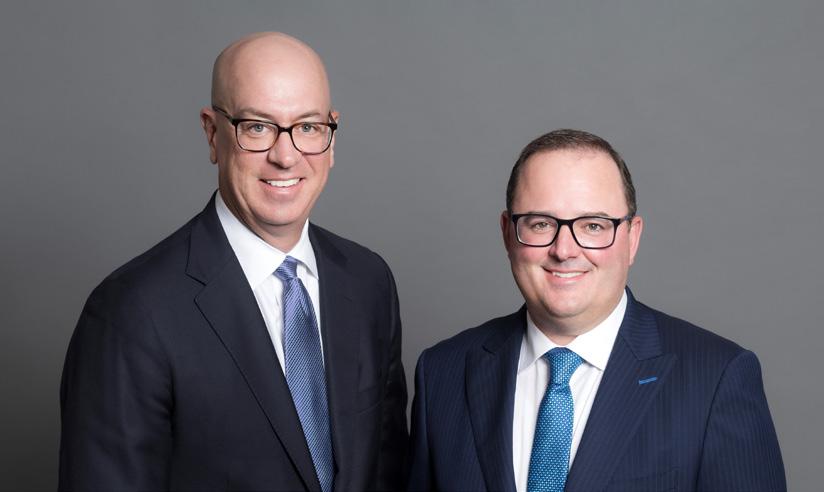
The Stephens Group takes a comprehensive approach to addressing investors’ goals for wealth accumulation, growth, preservation and financial legacy. Led by Jason Stephens and Mic Lundon, the South Florida–based team provides a single point of contact for select affluent individuals and families. The Stephens Group has guided numerous clients through multiple bull and bear markets over the past 25 years and brings a collective 100 years of combined experience backed by the industry-leading resources of UBS. The team has direct experience in tax planning strategies, marketable securities, alternative investments, equities and banking. The Stephens Group works one-on-one with each client to custom tailor financial solutions to fit today’s ever-changing markets with strategies to build a living plan that works for them as their needs change over time.
In addition to coordinating with clients existing advisors, the team also uses the in-house resources of UBS specialist including attorneys, trust officers and lending specialists, to assist with creating a personalized plan. What sets The Stephens Group apart is that they limit themselves to a select clientele, which allows them to take a holistic and disciplined approach tailored to each family allowing them to provide the highest level of attention, adding value by defining what is important to each client with truly customized solutions.
Forbes Best-In-State Wealth Advisors, FL, 2018 – 2023 The Forbes rating is compiled by SHOOK Research and awarded annually in April based on information from a 12-month period ending June of the prior year. Forbes America’s Top Wealth Advisors, 2017 – 2023-The Forbes rating is compiled by SHOOK Research and awarded annually in April based on information from a 12-month period ending June of the prior year. Eligibility is based on quantitative factors and is not necessarily related to the quality of the investment advice.
THE STEPHENS GROUP
Jason E. Stephens, CFP®, Managing Director–Wealth Management, Private Wealth Advisor
Michael J. “Mic” Lundon, CEPA, Executive Director, Private Wealth Advisor
The Stephens Group, UBS Financial Services Inc., Private Wealth Management 801 Laurel Oak Drive, Suite 708, Naples, FL 34108
For more information on third-party rating methodologies, please visit ubs.com/us/en/designation-disclosures . The information contained in this is not a solicitation to purchase or sell investments. Any information presented is general in nature and not intended to provide individually tailored investment advice. The strategies and/or investments referenced may not be suitable for all investors as the appropriateness of a particular investment or strategy will depend on an investor's individual circumstances and objectives. Investing involves risks and there is always the potential of losing money when you invest. Investors should be aware that alternative investments are speculative, subject to substantial risks (including the risks associated with limited liquidity, the use of leverage, short sales and concentrated investments), may involve complex tax structures and strategies, and may not be appropriate to all investors. Alternative investments may be illiquid, they may not be required to provide periodic pricing or valuation information to investors, there may be delays in distributing tax information to investors, they are not subject to the same regulatory requirements as mutual funds, and they may be subject to high fees and expenses, which will reduce profits. Alternative investments are not deposits or obligations of, or guaranteed or endorsed by, any bank or other insured depository institution, and are not federally insured by the Federal Deposit Insurance Corporation, the Federal Reserve Board or any other governmental agency. They should not constitute an entire investment program. Neither UBS Financial Services Inc. nor its employees (including its Financial Advisors) provide tax or legal advice. You should consult with your legal counsel and/or your accountant or tax professional regarding the legal or tax implications of a particular suggestion, strategy or investment, including any estate planning strategies, before you invest or implement. As a firm providing wealth management services to clients, UBS Financial Services Inc. offers investment advisory services in its capacity as an SEC-registered investment adviser and brokerage services in its capacity as an SEC-registered broker-dealer. Investment advisory services and brokerage services are separate and distinct, differ in material ways and are governed by different laws and separate arrangements. It is important that you understand the ways in which we conduct business, and that you carefully read the agreements and disclosures that we provide to you about the products or services we offer. For more information, please review the client relationship summary provided at ubs.com/relationshipsummary, or ask your UBS Financial Advisor for a copy. Certified Financial Planner Board of Standards, Inc. owns the certification marks CFP ® and C ertified f inan C ial P lannerTM in the US. For designation disclosures visit ubs.com/us/en/designation-disclosures. Private Wealth Management is a division within UBS Financial Services Inc. UBS Financial Services Inc. is a subsidiary of UBS AG. Member FINRA. Member SIPC. © UBS 2023. The key symbol and UBS are among the registered and unregistered trademarks of UBS. UBS Financial Advisors are Registered Representatives of UBS Financial Services Inc. CJ-UBS-1961327863 IS2303260 EXP.: 05/31/2024
advisors.ubs.com/stephensgroup
Pictured left to right: Michael J. “Mic” Lundon, Jason E. StephensAnthony J. Leopizzi, a Private Wealth Advisor of Verita Wealth Advisory Group, a private wealth advisory practice of Ameriprise Financial Services, LLC, has been a financial advisor, serving the Florida and NY metropolitan area for over 33 years. Anthony was recently named to the 2023 list of “Best-in-State Wealth Advisors” published by Forbes . The list recognizes financial advisors who have demonstrated high levels of ethical standards, professionalism, and success in the business.
As a Private Wealth Advisor, Leopizzi provides financial advice that is anchored in a solid understanding of client needs and expectations and provided in one-on-one relationships with his clients. For more information, please contact Anthony at 914-997-7526 or visit the office at 12330 Tamiami Trail East, suite 101, Naples, FL, or check out their website at www.ameripriseadvisors.com/anthony.j.leopizzi.


At Ameriprise Financial, we have been helping people feel confident about their financial future for more than 125 years1. With extensive investment advice, wealth management and insurance capabilities and a nationwide network of 10,000 financial advisors 2, we have the strength to serve the full range of individual and institutional investors' financial needs.
VERITA WEALTH ADVISORY GROUP
Anthony J. Leopizzi, CFP®, CLU®, ChFC®, CIMA® 12330 Tamiami Trail East Suite 101-A, Naples, FL 34113 l Phone 914.997.7526
1Source: Company founded June 29, 1894.
2Source: Ameriprise Financial Q4 2022 Earnings Release. Forbes rankings are developed by SHOOK Research and are created using an algorithm that includes both qualitative (in-person, virtual and telephone due diligence meetings; client impact; industry experience; review of best practices and compliance records; and firm nominations) and quantitative (assets under management and revenue generated for their firms) data. Certain awards include a demographic component to qualify. Investment performance is not a criterion because client objectives and risk tolerances vary, and advisors rarely have audited performance reports. These rankings are based on the opinions of SHOOK Research, LLC, are not indicative of future performance or representative of any one client’s experience and are based on data from the previous two calendar years. Forbes magazine and SHOOK Research do not receive compensation in exchange for placement on the ranking. For more information: www.SHOOKresearch.com. SHOOK is a registered trademark of SHOOK Research, LLC
Investment products are not insured by the FDIC, NCUA or any federal agency, are not deposits or obligations of, or guaranteed by any financial institution, and involve investment risks including possible loss of principal and fluctuation in value. Ameriprise Financial Services, LLC. Member FINRA and SIPC. 2023 Ameriprise Financial, Inc. All rights reserved.
AmeripriseAdvisors.com/anthony.j.leopizzi
Most people hire a wealth management advisor because their financial lives have grown complex and they’d like support from industry professionals to make their financial lives more simple. But when you end up hiring an investment manager, an accountant, and an attorney, and none of them are on the same page or coordinating their advice, what you end up getting is more complexity.

Instead, when your financial life is handled by one team in alignment with a coordinated financial plan you’re able to release yourself from the stress that uncertainty creates and get back to playing the roles in life that only you can play – parent, spouse, and friend.
A fee-only firm managing over $1.5 billion of client assets, Wealthquest brings taxes, estate planning, investment management and financial planning all under one roof for one simple fee to create efficiency and clarity in our successful clients’ busy lives.
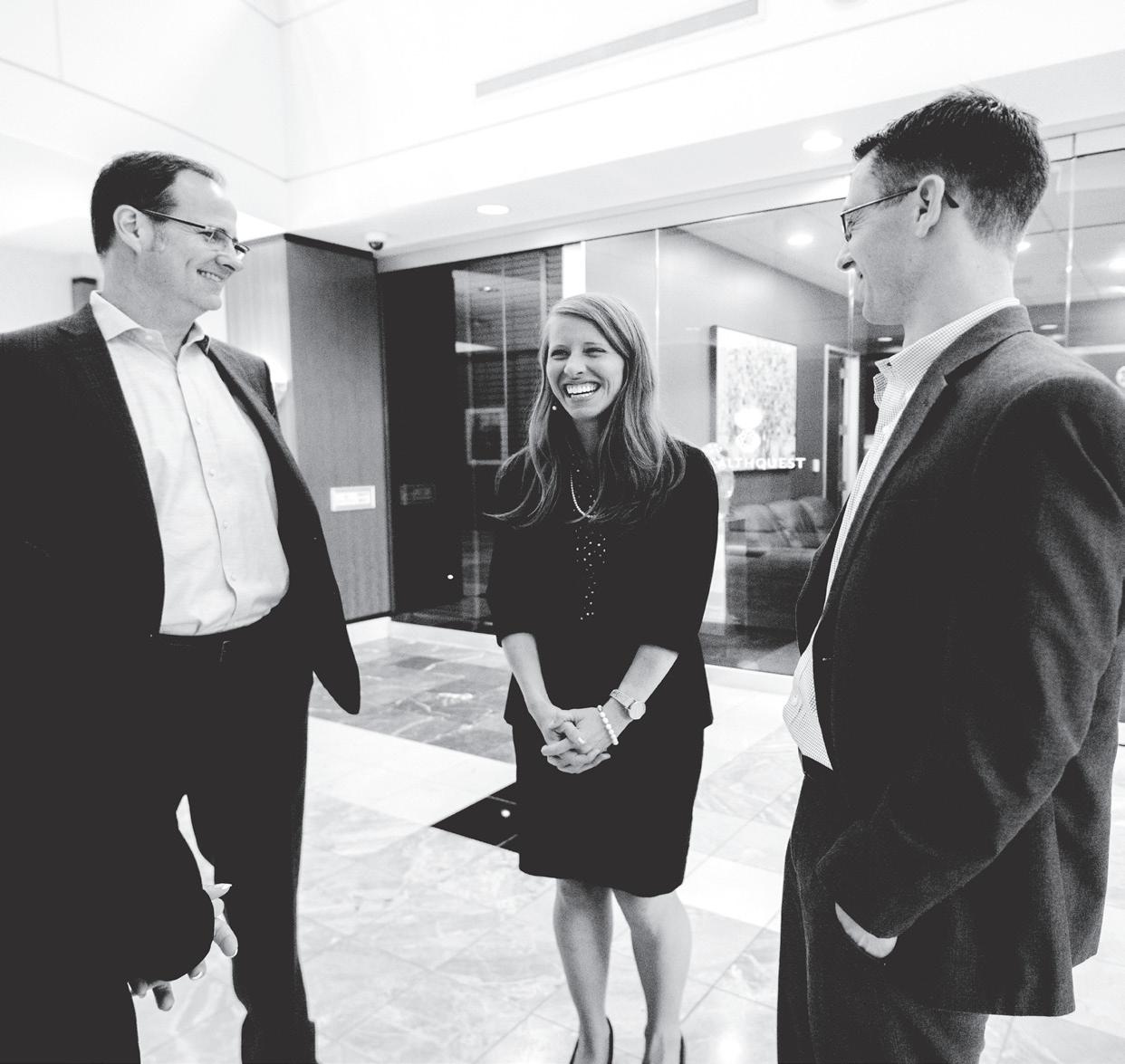
Adam Day is a Certified Financial Planner Professional™ and Certified Financial Therapist. He runs the Wealthquest Naples office, where he and his family reside.



There may never be another St. George and the Dragon—a restaurant of mythic proportions from a legendary era of Naples—but its spirit lives on.
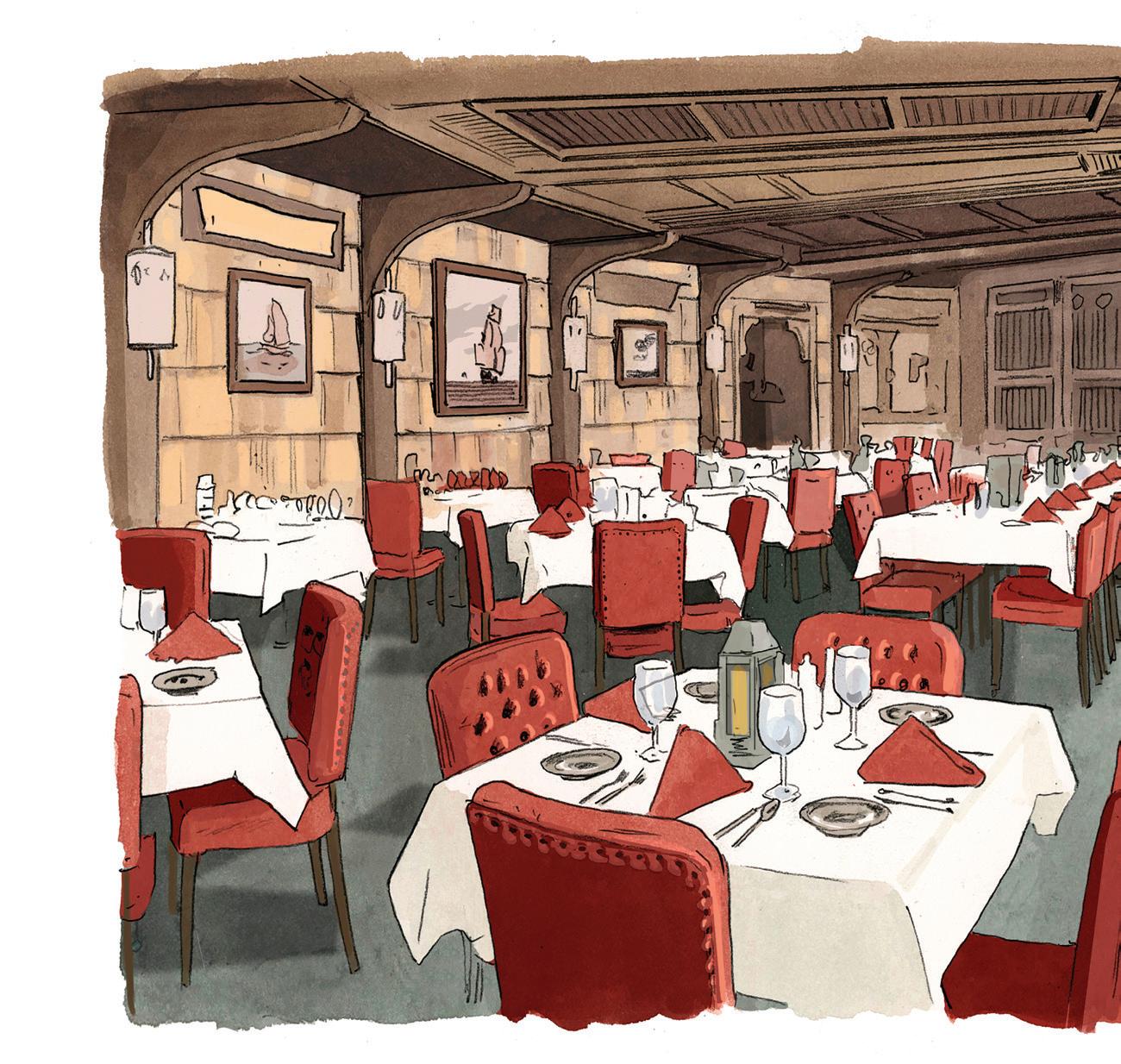
A bright swath of double-decker-bus red catches people’s eyes near the intersection of Seventh Avenue North and U.S. 41. The more-than 8-foot-tall midcentury castiron British telephone booth sits locked and empty in front of Lake Park Diner, one of Naples buzziest contemporary restaurants. At the top of the four rectangular sides is etched, in a distinctly English serif font, ‘St. George and the Dragon.’
To many passersby, it’s a quirky landmark and conversation starter. But to those who lived in or have heard the tale of the sleepy community that used to be Naples, it’s a relic of mythic proportions.
Once upon a time, when Fifth Avenue South’s downtown strip took up little more than a city block, a restaurant existed where sport coats were required for dinner, and no one seemed to mind despite the proximity to the Gulf. Everyone who entered knew your name, and you knew theirs. St. George and the Dragon, inspired by its owners’ love of England and New England, was trimmed inside and out in custom-carved wood beams, with that distinctive vermillion phone booth as its exterior calling card. The dark interiors were also a sight, covered floor to ceiling in timber panels to resemble an old sailboat cabin, with maps, compasses and nautical antiques peppering every square inch of the walls.
The restaurant debuted its polished surf-and-turf menu in November 1969 and remained virtually unchanged until serving the final round of its signature

conch chowder with a shot of sherry on July 23, 2012. “St. George was so good for that time—and even today. People say to me now, ‘Boy, I wish St. George was still there,’” reminisces Bill Barnett, himself a living legend, known affectionately as Mayor Bill after serving a combined total of 16 years as mayor and 12 as a councilman between 1984 and 2020. (He also knows his food inside and out, having written restaurant reviews in secret for the Naples Daily News under the nom de plume of Jacques Gourmand in the ’80s.)
“Their specialty was prime rib … You could get every cut you wanted, but they were known for their King Arthur cut, and, wow, was that a monster slab of beef,” he adds.
The restaurant was a family endeavor with the late founders, George and Marylin Ginos, at the helm and their children, Kevin and Eileen, involved from the start. There was a no-reservations policy, but in its heyday (which lasted pretty much the entire four-decade lifespan), people would cue up and wait two or three hours for a table in season. The circular, hand-carved teak bar was always packed shoulder to shoulder with what Bill recalls was a martini crowd to rival that of Mad Men. “It was the place to be. Everybody who was anybody was there on a Friday or Saturday night. Lawyers, doctors. It’s where everybody got together to see and be seen,” says Kevin, who devoted 35 years to the family business after graduating from the University of Florida.
People sometimes assumed St. George and the Dragon was in reference to George, a Greek-American who ran restaurants in New York and Pennsylvania, and his bride Marylin, who moved together to Florida to manage a few casual places before opening St. George. “It was a private family joke that their roles were reversed—that my dad was actually the dragon, not the saint, because he was super strict. Whenever he spoke to anyone in the kitchen, it was always met with, ‘Yes sir, yes sir,’” Eileen Ginos Merriman says with a laugh.

There were plenty of famous guests, including Secretary of State George Shultz and NFL Hall of Famer Dan Dierdorf. Still, Kevin and Eileen agree the heart of the















After nearly 30 years, the Tony Ridgway-founded Third Street Farmer’s Market remains the heart of Naples.
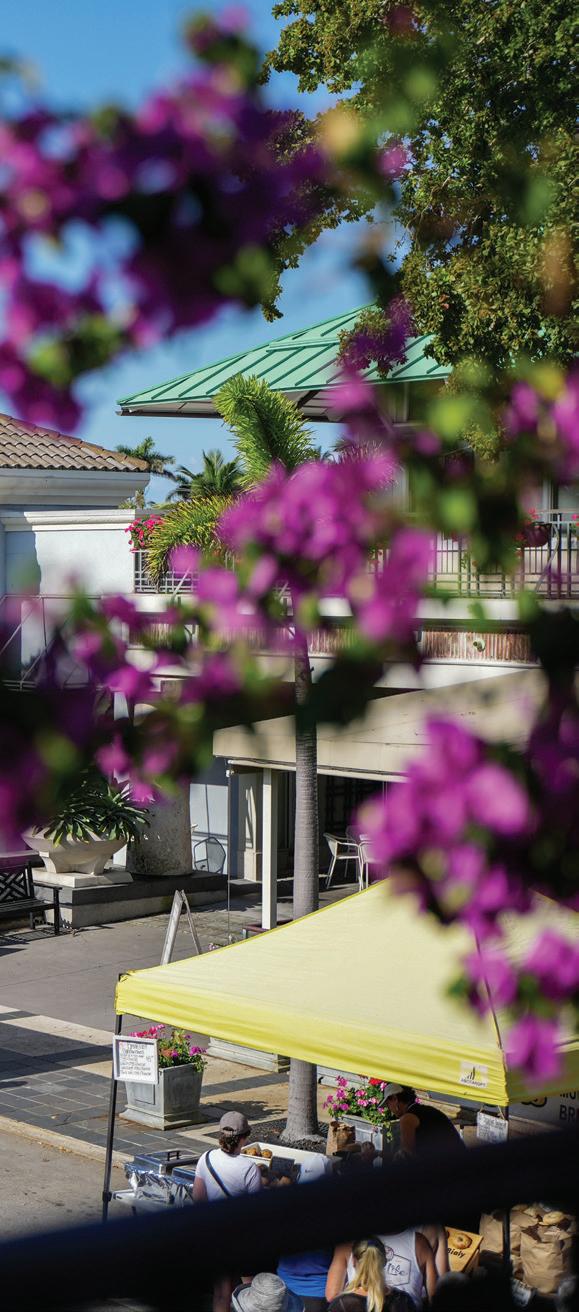
On any Saturday morning in season on Third Street South, girlfriends gather to sample spoonfuls of lemon basil sorbet from Birdie’s Gelato. Determined kiddos challenge themselves to carry piles of produce from Inyoni Organic Farm while their mothers trail behind, bouquets from Dominga’s Flowers nestled into the crooks of their arms. Musicians busk on the street, serenading the market over myriad scents wafting throughout: locally roasted coffee from Jimmy’s Java, fresh-baked butter and almond cookies from Bella’s Cakes, and Fire and Rice’s paella simmered on the spot by chef-owner Paul Schmidgal.
Those are just some of the approximately 60 vendors at the region’s largest—and longest-running, for nearly 30 years—




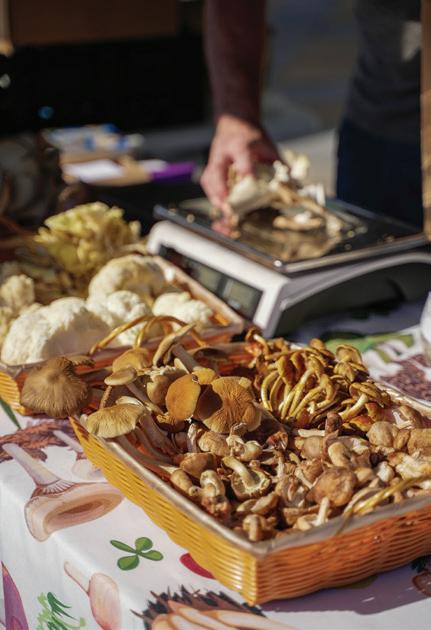
Restaurateur Tony Ridgway started the market in 1994 as a local gathering place, where farmers could sell their bounty. “We need those places where we can congregate as friends,” he says.







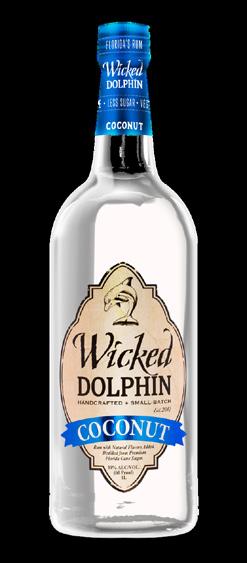





The weekly Third Street Farmer’s Market takes place year-round, moving from the main strip to the Neapolitan Enterprises parking lot from May to November.
farmers markets. We largely have longtime Naples restaurateur Tony Ridgway to thank for this weekly tradition. When he started the market as the Third Street South Merchant’s Association president in 1994, Tony wanted to create a gathering place for the neighborhood where farmers could bring their products to market—literally. While the scale has grown, that core goal has not changed. Tony’s proud to see how the market has evolved. He returned to the helm as the association’s president in 2005 after a years-long hiatus (though he remained involved) and has been president ever since. “The social aspect of it was just as important as anything,” he says. “A farmers market is the place where neighbors who don’t see each other for weeks see each other on a Saturday.”
10.13.23 I 5PM - 9PM The Club at Mediterra



Youth Haven’s 8th Annual Uncorked event is a “resort chic” wine pairing event featuring delicious food and drinks, music, a silent auction, and more. Please join us and help provide Home, Hope, and Healing to abused and neglected children and teens in Southwest Florida.


Uncorked Chairs: Charlie Miller and Jacqui Resop
Held weekly on Third Street South from mid-November to April and the nearby Neapolitan Enterprises parking lot from May to November, the gathering draws hundreds of locals and out-of-towners to peruse colorful tents overflowing with local offerings. “I love it when I see people walking home, when I come down on a Saturday morning, with bags on their arms,” Tony says. Though the market has grown from a once-monthly event to a weekly gathering with about 60 vendors, geographically, it still runs along Third Street’s sidewalks, with the European-inspired buildings and

greenery transporting patrons who can spend hours shopping the booths and communing with neighbors.

The focus has also shifted from crafts and wares to fresh bites, says Justin Collins, director of operations at Neapolitan Enterprises, which manages the market’s permitting, planning and oversight. A panel of office employees and board members weigh in on vendor selection, with a focus on local businesses. They taste samples and review booth setups to determine which would add something new to the lineup. Some vendors wait for years to get on the list, Justin says. That means they get to be the best kind of picky: You can always find something truly special—food, community and connections. “We need those places where we can congregate as friends,” Tony says.





Everglades City mayor, Howie Grimm, and son Quinton reflect on Collier County’s resilient stone crab legacy.
Everglades City’s fishing families are resilient by virtue of necessity. The stone crab industry embodies this, dating back to Chokoloskee native and commercial crabber Ernest Hamilton.
In the 1920s, blue crabs were popular across the East Coast—but the harvest around the Everglades became problematic as stone crabs pushed blue crabs out of the traps. Fishers had long discarded the crustacean, as stone crab, cooked alongside the blues, turned to mush—the claws overcooked. Ernest was first to recognize their fragility—and potential. He halved the traditional cooking time, then blanched the claws in an ice bath, yielding delicate, sweet meat. A few years later, Ernest and others discovered they only needed to harvest the claws—the body remains inedible while the pinchers regrow within a year. Everglades City became the self-proclaimed Stone Crab Capital of the World, with crabbers now harvesting more than 300,000 pounds of the delicacy each year. What was once a nuisance became a $30 million-a-year industry.
On a cloudless April morning, I travel to Grimm’s Stone Crab in Everglades City to meet with the seafood market’s owner, Howie Grimm, and his son, Quinton. Howie also happens to be the town’s mayor, and Quinton is Ernest Hamilton’s great-grandson on his mother’s side. Grimm’s overlooks the Barron River, its docks piled high with stone crab traps and buoys, tangled in bits of barnacle and seagrass. Sunlight reflects off the water and into the market, streaming from stainless steel processing tables to large metal fish tubs, baskets and boxes. Trays of stone crab claws nestle into a blanket of ice, like orange sequins across the market’s lone silver display case.

Quinton’s great-grandfather, Ernest Hamilton, discovered the sweet, succulent potential of stone crab, recognizing they needed a shorter cooking time than the already-popular blue crab. He also found crabbers only needed to harvest the claws, which regenerate.

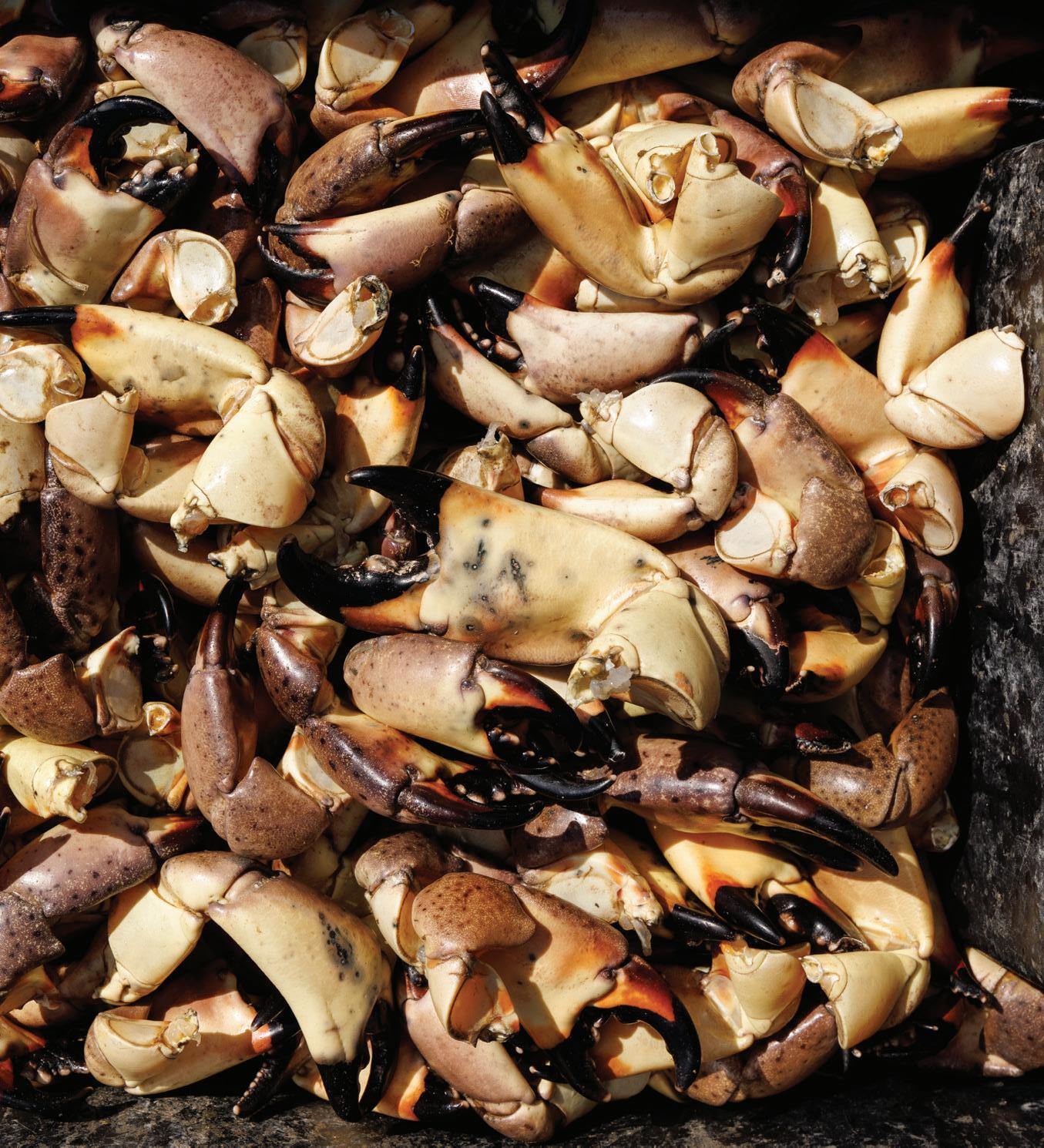
Grimm’s Stone Crab is a family affair, including Howie’s son and Quinton’s brother, Justin (above), who helps run the seafood market.
The Grimms believe the generational nature of stone crabbing offsets any instability in the industry’s future, as each insists on preserving it for the next generation of crabbers. The pair discuss this from the middle of their fish house, framed on either side by walk-in coolers teeming with stonies.
Howie Grimm: People have asked before if we would abandon the town. I said, ‘When a tornado goes through a town in Oklahoma, wipes it out, do they move the town? No.’ So if, say, the water does continue to rise, we’ll figure it out. We’ll get around by boat. You know, we’ll do whatever we have to. This town is stronger than it has been in a long time. And I really feel good about where we’re headed with our younger people. And with doing the right thing, like shortening the season.

Stone crab season, which runs October 15 through May 1, was shortened by two weeks beginning in 2020 to prevent overfishing.
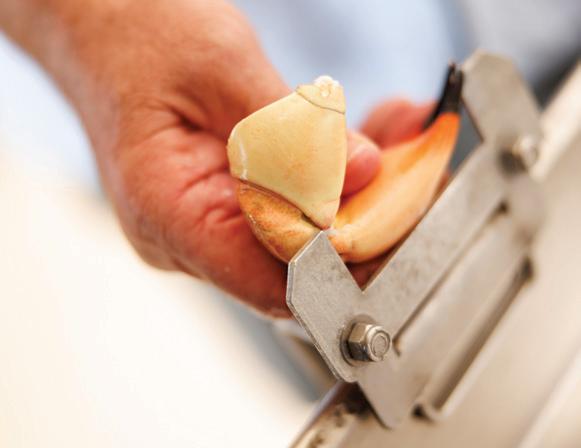
Quinton Grimm: At the end of season, the crabs are full of eggs. The less you interfere with them, the better. And that’s any of the younger guys that crab around here—they’re about preserving the industry. They’re in it for the long haul.
Howie: Dad always said: ‘They can make all the laws they want, but unless you do the right thing when nobody’s looking, it’s not gonna work.’
When I ask if the young stone crabbers they refer to are from fishing families, they stop, look at me and say, in unison: “Every one of them.”
Howie: Stone crabbing just takes a certain kind of people. You have to love it. And that’s the truth. And that’s the way commercial fishing has always been. You really don’t do it for the money.
Quinton: If you don’t love it, you won’t make it. It’s so different from normal life that unless you’ve grown up in it and are already used to it—trying to come into something like this, it’s a big adjustment. I tried something else after high school, considered college, but I just—I was missing that part, you know. I grew up on the water. I was lucky enough [that] my grandfather—he had retired 10 years or so before I got into crabbing—he still had his boat, so when I decided that I wanted to stone crab, he got the boat ready for me and showed me how to do it.







Quinton’s grandfather, Billy Raffield, is known throughout Chokoloskee and Everglades City as the ‘King of the Stone Crabbers,’ reportedly harvesting more than any other crabber in his time. His boat, now Quinton’s, is named Miss Trudy, after Quinton’s grandmother. I ask how long he intends to run his grandfather’s boat. A wide smile cracks his stoicism. A fisher’s pride emerges. Quinton: Until the day I die.

Howie and Quinton’s earliest memories match. Each was 6 or 7 when they first chased stone crabs across the bow of the boat. Quinton: When I was growing up, my dad and grandfather would crab all day, then fish all night. But in the beginning, when stone crabbing first started, my great grandfather, Ernest, would crab all day, get in, cook the crabs—there was no fish house back then—get it ready to take to Miami, go sell in Miami, come back, then do it all again. I mean, they were constantly working, trying to make something. They were building the industry while they were fishing it.
That continues today. Howie’s other son, Justin, who helps run the seafood market, wheels a tub packed full of claws toward the front counter. A musical sound emerges—stone crab shells clicking and clacking, the murmur of metal. When ready, the claws are shipped to Miami or sold through the Grimms’ retail market. Locals and tourists alike frequent the historic fish house for fresh-off-the-boat stone crab. An Everglades City haul can also be found at various Barron River fixtures, such as the local-favorite Camellia Street Grill or Triad Seafood Market and Cafe, where native sons and daughters go to get their claws for baptisms and anniversary parties.
“We’ll do whatever we have to. This town is stronger than it has been in a long time”" — Howie Grimm
Everglades City harvests about 300,000 pounds of pincers every year for a $30 million-per-year industry. The Grimms’ claws are shipped to Miami or sold through the retail market. In season, from October to May, most restaurants in town serve stone crab fresh off the boats.

As our conversation winds down, the sun sweeps across the docks, offering its last bit of afternoon light. Behind Howie and Quinton— the processing tables, the tubs, the baskets and the Barron River—all is silver and gold. I ask Howie and Quinton if stone crab remains the heart of Everglades City.
Howie: Stone crabbing is half the heart of Everglades City, and tourism is the other half. People want to see a real commercial fishing town.
The Grimms help preserve both. A haul of stone crab moves through the town from the dock to the table, one family, then another, bound up in memory and Old Florida dreams, each generation ensuring there’s plenty for the next.

Howie: All that property along the riverfront, from [Ernest] Hamilton Stone Crab down, it all belongs to the city, and there’s a section that we lease only to commercial fishermen. You need a commercial fishing license to even be considered because we want to make sure that those docks stay in fishermen’s names.
Quinton’s great-grandfather opened Ernest Hamilton Stone Crab in the seventies. It’s now owned by Joe’s Stone Crab in Miami. Quinton: That’s some of my earliest memories out [on the riverfront], sitting around those picnic tables with Grandma and Grandpa eating crabs.
The sweet, firm and succulent stone crab is relished on its own, with a drizzle of lime juice and butter, or alongside mustard sauce. Enjoying stone crab at the source, here in Everglades City, is a rite of passage for many, from fishers to native Floridians—and those who wish to be. I ask if they ever tire of the flavor. Howie shakes his head as if he’s baffled.
Howie: We eat it every day.
Quinton and I grin, acknowledging the question didn’t need asking.
Quinton: Every day.
When you join Naples Bay Club, you are joining a lifestyle!




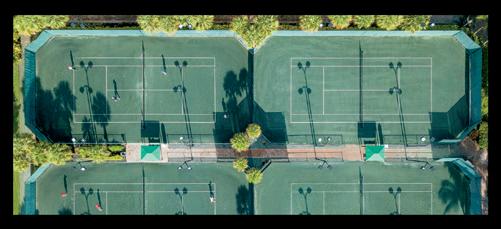

Private club membership in an exclusive yet convenient setting. Members enjoy the best that the Naples lifestyle has to offer, including private tennis, fine to casual dining, a luxurious spa, and state-of-the-art fitness facility. All enjoyed among familiar faces, with an extensive year-round social calendar of member events, creating memories in a private club environment.
For more information visit naplesbayclub.com or call Membership Director, Robert Forrest at (239) 530-5159 to arrange a Club Tour

Naples Bay Club
1800 Tamiami Trail East. Naples FL 34112 naplesbayclub.com | (239) 530-1199


AS NEAPOLITAN CUISINE TURNS 100, WE TURN TO TODAY’S CHEFS FOR A WINDOW INTO YESTERDAY.
BY ANDREW ATKINS PHOTOGRAPHY BY BRIAN TIETZ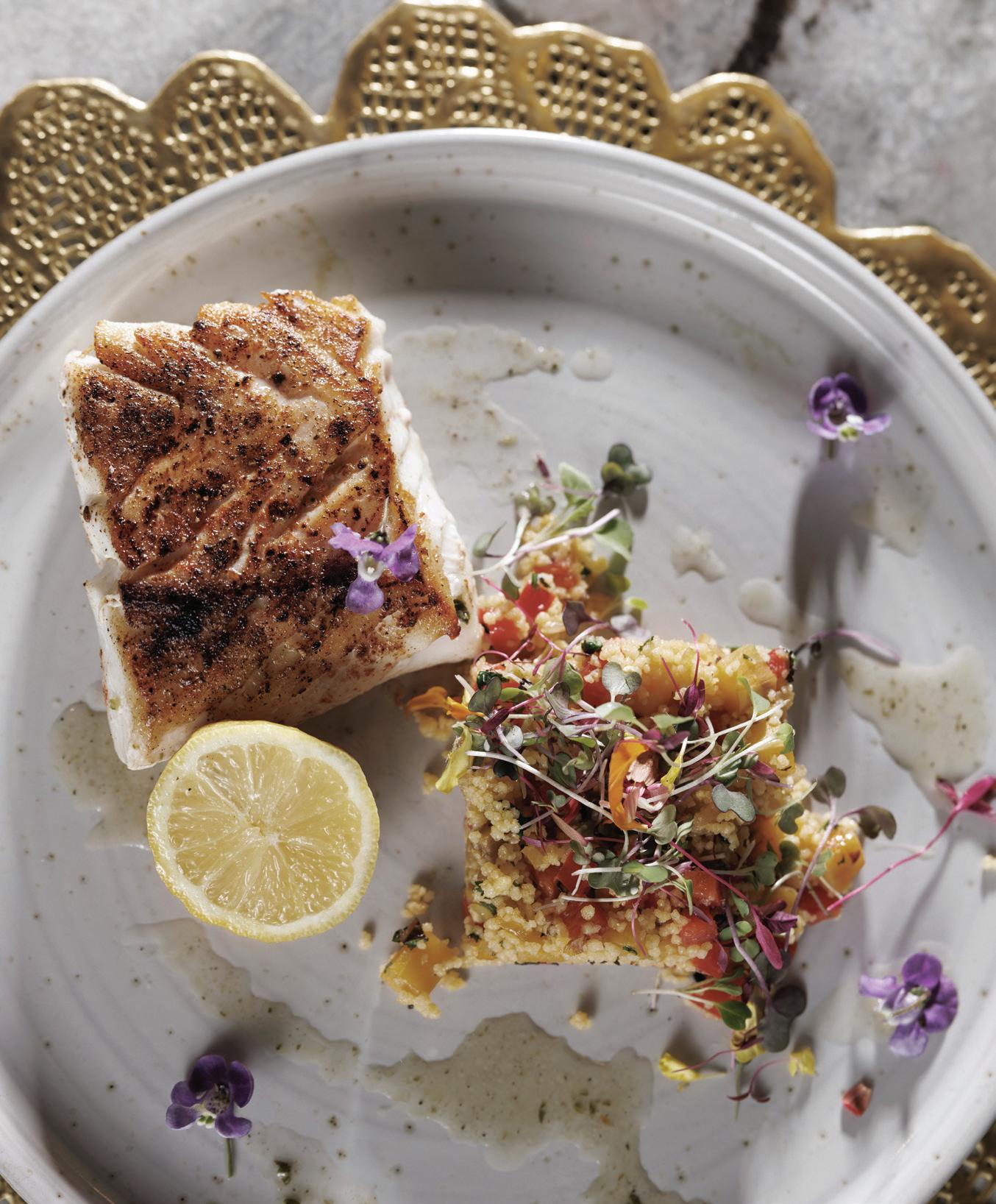

ood is a powerful vessel for memories. And for food columnist and Naples’ first official historian, Doris Reynolds, the city’s past was embossed in her mind as the smell of dishes wafting from her first Thanksgiving in town at the old Gulf Hotel in 1952; dinners at Kelly’s Fish House, Naples’ oldest restaurant; and the impromptu parties with bountiful spreads in her eclectic 13th Avenue South home. Knowing a city’s soul is anchored in its past, and with Naples rapidly growing, in 1993, Doris compiled decades of local food lore into When Peacocks were Roasted and Mullet was Fried. The book tells the story of Collier through early meals at The Rod & Gun Club, lavish parties at the Naples Hotel and legendary Old Naples hosts. In honor of the city and county’s centennials, we ask five forward-thinking chefs to reinterpret dishes from Doris’ book.
When presented with this assignment, chef Don Splain says, “I hope I get the peacock.” It makes sense: Don, a towering culinary presence in Naples for 20 years, is as much an anthropologist as he is a chef. He dives deep into the cultural connections of food and forages for wild mangoes, wild persimmon and any other matter of endemic edibles in our region to fold into his highly imaginative catering kitchen.

Don’s reimagined peacock recipe comes by way of Julius “Junkie” Fleischmann, the man behind Neapolitan Enterprises, which created much of the Third Street South we see today. Junkie also took over botanist Henry Nehrling’s abandoned gardens and turned them into what is now Naples Zoo at Caribbean Gardens, adding showy animals for entertainment. Doris writes of a time when flamin-
gos, swans and peacocks would escape and wander the neighborhood. On the rare occasion when a peacock met an untimely end at the jaws of a gator, Junkie would cook them up. Ancient royal feasts served the birds with their legs wrapped in gold sheets. “So why not at a dinner party hosted by Naples’ ‘Renaissance Man,’” Doris posits.
Peacocks now roam wild in Collier County, and Don puts the bird in the same boat as wild turkey. But as it turns out, they’re difficult to source and exorbitantly priced, so in recreating the recipe, he swaps for pheasant—a suitable substitute in Junkie’s recipe. The erudite Don follows Junkie’s example and starts by rubbing the bird inside and out with salt to dry out excess moisture, then threads it with homemade ibérico pork belly bacon and seasons it with Florida sage and thyme.
As the recipe calls, Don stuffs the double-breasted pheasant cavity with onion, rosemary, sage and bitter oranges. After trussing it, he coats the outside in clarified butter before roasting. Since pheasant is a lean bird, the internal basting process draws all the flavors of the fat and aromatics from the inside out. Most of the ingredients, Don notes, could be found within 5 miles of where he cooked the dish. “I love visiting those old techniques,” he says of the no-fuss dining era, where chefs let ingredients shine simply. “It’s a lost art.”

When Doris described Naples as a “fishing village” in a 1952 New York Times article, early settler Florence Haldeman Price called the writer over and pointedly clarified that Naples had always been, and continued to be, a resort community. Central to that identity was the Naples Hotel, which Florence’s grandfather and a group of Kentuckians opened in 1889. Doris recounts that the first registered guest was the “rambunctious” Rose Cleveland, who “couldn’t have cared less about the highfalutin’ ways of Palm Beach and Miami,” setting a standard for the type of people who convened in Naples.
In 1947, William Schultz, who had worked for Barron Collier in his Useppa Island Inn, joined the Naples Hotel and established Sunday night buffet feasts as a town tradition. Doris chronicled William’s pompano filet—‘Naples style’— which uses the migratory, nearshore fish favored for its sweet flavor and succulent, pearly white meat. Local ingredients were essential in an era with no refrigeration and ice boated in via
Naples Pier. William simmered the fish and roasted it with shallots, mushrooms and celery before making a sauce out of fish broth, lobster, shrimp and sherry— finishing with a Hollandaise.
Jason Goddard, head chef of Aielli Group’s genre-defining restaurants— Barbatella, Dorona, Grappino, Sea Salt—was delighted to see William’s pompano filet. As a 20-year Naples resident, Jason has caught the fish several times. He took his assignment seriously, strolling with his daughters to Crayton Cove for inspiration and reading up on Naples history so he might better pay homage. As he examines the recipe, an image appears in Jason’s mind: a chef in Naples—when, Doris writes, there were so many fish “you could catch them in your shirt”—goes fishing for dinner at Crayton Cove. He picks greens on his way home to round out the meal.
Jason detects Southern and Creole influences in the dish, so he swaps the original sauce for blue crab sofrito (blue crabbing dates back more than a century in Collier County), using the shells to make the braising broth. Alongside a shrimp potato hash, he blisters Everglades tomatoes and tosses dandelions in olive oil and vinegar for a fresh bite.
The experience felt familiar and nostalgic to Jason, who grew up picking dandelion greens on his family’s Iowa farm. To recreate a past recipe, the chef says, is to return to a moment in time: “[It’s about] polishing it and making it refreshed and new and reliving it.”

The vivacious Bertha Lowdermilk was a consummate host rarely seen without hibiscus in her hair. Her husband, Fred, was the first city manager, serving from 1949 to 1961. His ingenuity included unleashing alligators to chomp through overgrowth in the city sewers and ordering a shipment of dragonflies to chow down on a particularly nasty mosquito blight.
Fred was recruited from the Edison and Ford Winter Estates in Fort Myers to oversee The Naples Plan, a fund for city improvements early leaders ingeniously set up in 1948 to function like a nonprofit. “Almost immediately, $380,000 was raised for public works,” Doris writes. And Naples’ strong identity around philanthropy was established. Fred oversaw many of the ensuing civic improvements, including the creation of a nursery at Cambier Park (on land donated by Henry B. Watkins Sr.). Every spring, Fred gifted a flowering tree to each Naples family in his ongoing efforts to beautify the city. (Fred’s also largely credited for the stately mahoganies and banyans along Gordon Drive.) Doris put it this way:
“If you’ve ever admired the gorgeous, flamboyant Royal Poincianas or the spectacular Shower of Gold trees along our streets and avenues, say thank you to Fred Lowdermilk.”
Fred was an avid hunter, and Bertha was a superb cook. She prepared game with finesse, and wild boar was her favorite. When Vincenzo Betulia of The French and Tulia saw Bertha Lowdermilk’s Wild Boar, he latched on. He could imagine the pigs snuffling through our cypress forests and freshwater marshes, just like he could see them trotting through the rolling, olive tree-filled hills of Umbria in his native Italy. “As a chef, I see things … as if I were living it,” he says.
Vincenzo’s recreation pulls a Renaissance-era recipe from central Italy, drawing from one history to interpret another. He sears the boar shoulder, using the caramelized bits as a flavorful base for his rich sauce. Then, he braises the meat in red wine for up to three hours, until fork-tender, and adds bitter dark chocolate to tamp down the boar’s inherent gaminess. He serves the meat with wide tagliatelle.
Vincenzo is fascinated by the fact that the animal was found and cooked prominently in these two places on opposite sides of the world. “It’s so historic in that sense,” he says. “For me, it’s almost a little bit more soulful.”

BERTHA LOWDERMILK’S WILD BOAR
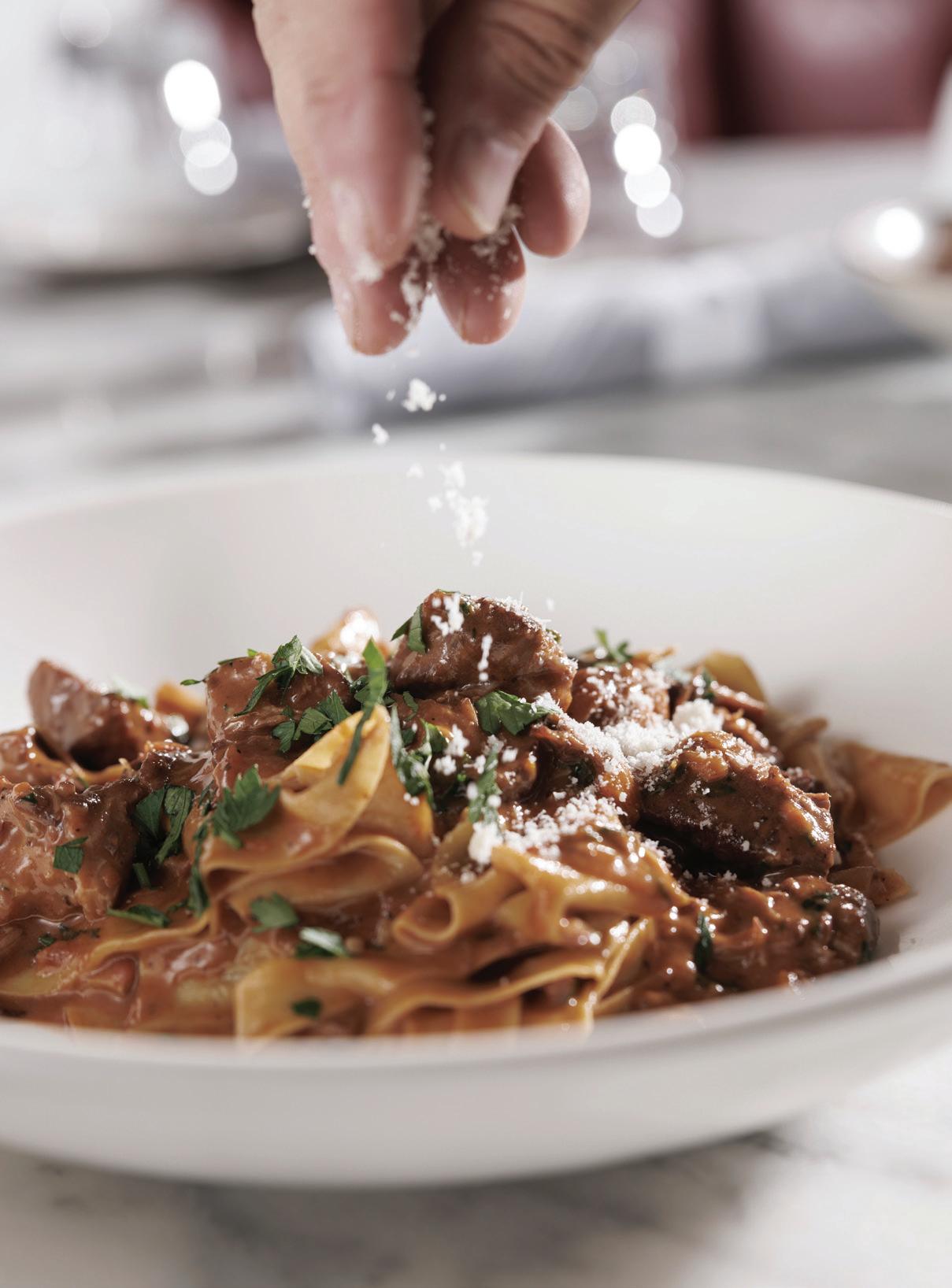

Claus ‘Snooky’ Senghaas arrived in 1923 from Baden-Baden, Germany, to be the chef at The Rod & Gun Club. While staying at a hotel in BadenBaden, Barron Collier fell for Snooky’s culinary prowess and offered him a job to cook in the advertising magnate’s fledgling city. Snooky consented; the rest was actual history: He became beloved for his cooking and largerthan-life personality. (Old photos show him dancing at the local prom.)
As the building of Tamiami Trail ballooned the town’s population, Doris notes that the task of feeding everyone fell largely on Snooky, who would tend to the well-heeled crowd at The Rod & Gun Club and Everglades Inn and travel to nearby worker camps to cook. During World War II, when the Coast Guard set up at The Rod & Gun Club, Snooky would prepare “his special fish and game dishes for the military brass.”

Today’s larger-than-life German transplant chef Andy Hyde is an apt fit to recreate one of Snooky’s iconic dishes. Born in Ghana and raised in Hanover, Germany, Andy runs one of the most inspired kitchens in town at Hyde N Chic restaurant. Andy’s exuberance only heightens dinner at Hyde N Chic—the chef often winds through the intimate dining room with flawless wine recommendations, animated food stories and his trademark laugh.
Regarding the recipe for Snook a la Snooky (which was baked, then served with a thick mushroom sauce), Andy says the original was good for the time, but: “There was no herbaceous love. There was no aroma in there. It was just a quick toss and go, which I’m sure was yummy, but you needed a lot of salt.” His take, Grouper a la Chic, sous vides the fish to lock in flavor and finishes it with a hit of Ethiopian berbere spice to give it that blackenednot-burnt touch. Andy tried to get snook, but it’s harder to source than you’d think. The fish is fairly plentiful around the passes in the spring, but because they’re overfished, you can only catch them for personal consumption. No matter: Doris chronicled Snooky’s recipe as using grouper as a substitute, and Andy approves of it as a true, local fish. The chef plates the grouper alongside his Moroccan couscous, one of the recipes he first tasted in Hanover. For a Southwest Floridian spin, Andy tosses the couscous with locally sourced peppers and eggplants.

Wynn’s Family Market still uses many of matriarch Anne Wynn’s recipes. Until she had her third child, Jerry, Anne worked at the store her husband’s parents founded in 1938 as an inn and grocery. Doris writes that when Don Wynn came to visit his parents after the war in 1942, he had no intention of returning. On his first visit to town years prior, he said he’d thought Naples “was a terrible-looking place, just a couple of dirt roads, a few buildings, and thousands and thousands of mosquitoes.” But the city soon cast her spell as she’s done for many Naples residents. After he met and married Anne Merle Echols—who grew up in Everglades City in the laundry that is now the Museum of the Everglades—he never thought about leaving again, the author writes. A few years later, the family opened Naples’ first modern grocery store in 1948. (They also started Sunshine Ace Hardware.)
Anne’s Peanut Butter Cream Pie is a straightforward affair of fluffy peanut butter topped with thick dollops of meringue. Longtime local chef Todd Johnson—who worked at Tony Ridgway’s The Chef’s Garden and
recently opened the lauded Nosh on Naples Bay—recreates Anne’s recipe with a hearty dose of chocolate. “I think chocolate should always be with peanut butter,” he says. His peanut butter-chocolate bomb whips the nut butter with whipped cream and cream cheese, poured over a layer of chocolate ganache, all encompassed in a glossy, chocolate sphere. The whole thing appears to detonate—in a controlled fashion—over a syrupy raspberry coulis.
Todd’s been in Naples since 1979 and remembers serving Doris at The Chef’s Garden in 1993, when she ordered his Floribbean daily special, with green papaya-and-jícama slaw and cocoa butter-seared Bahamian conch medallions. She asked to meet the chef, and though she was complimentary, Doris noted she couldn’t pick out the jícama. Todd realized he had forgotten the crunchy root.
The chef remembers Doris fondly as a woman who chronicled and shaped how we dine here today. “I think this town needs Doris Reynolds now more than ever,” he says. “She was the food critic for Naples back then. She did it in a style that had a tremendous amount of respect.”


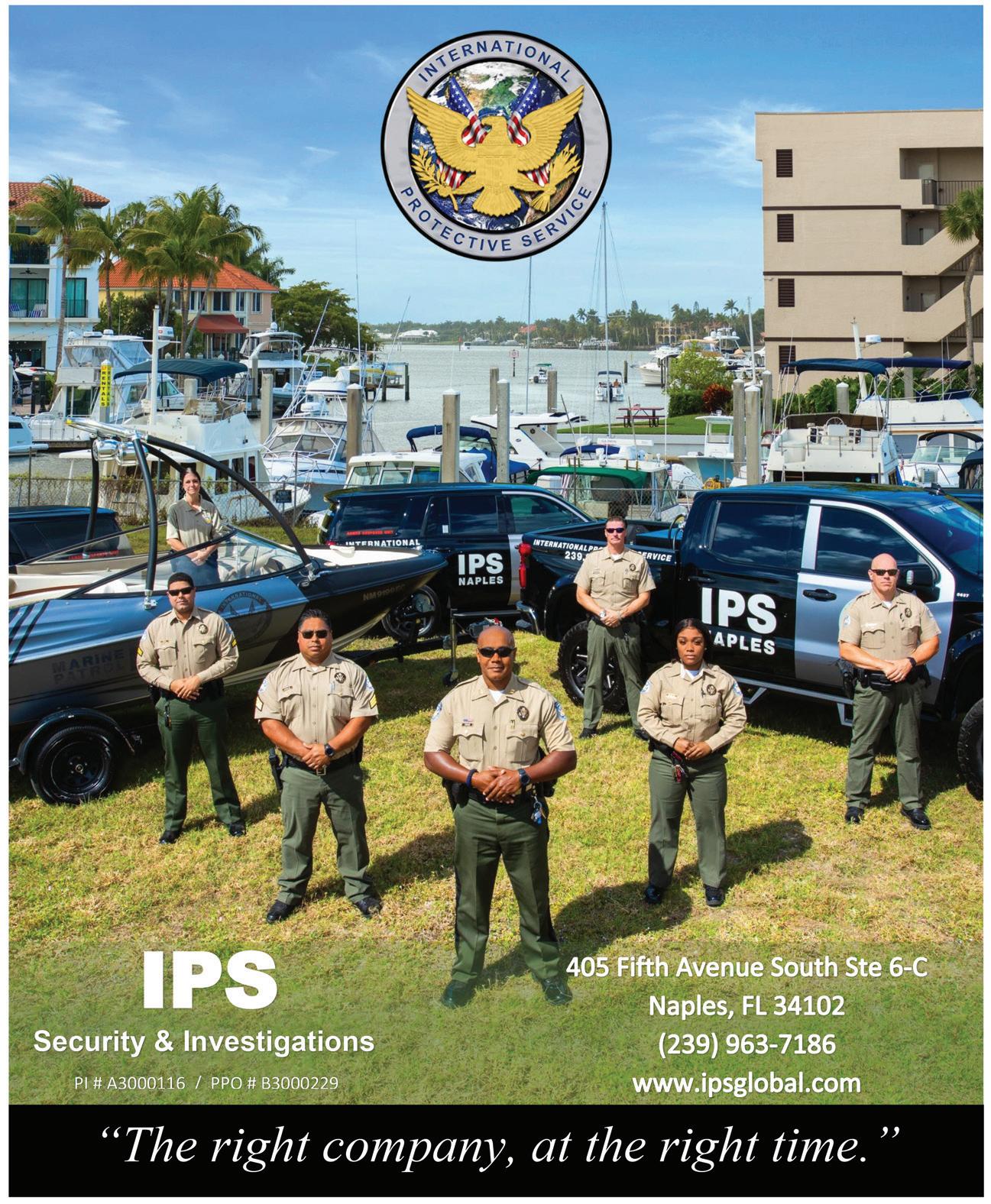
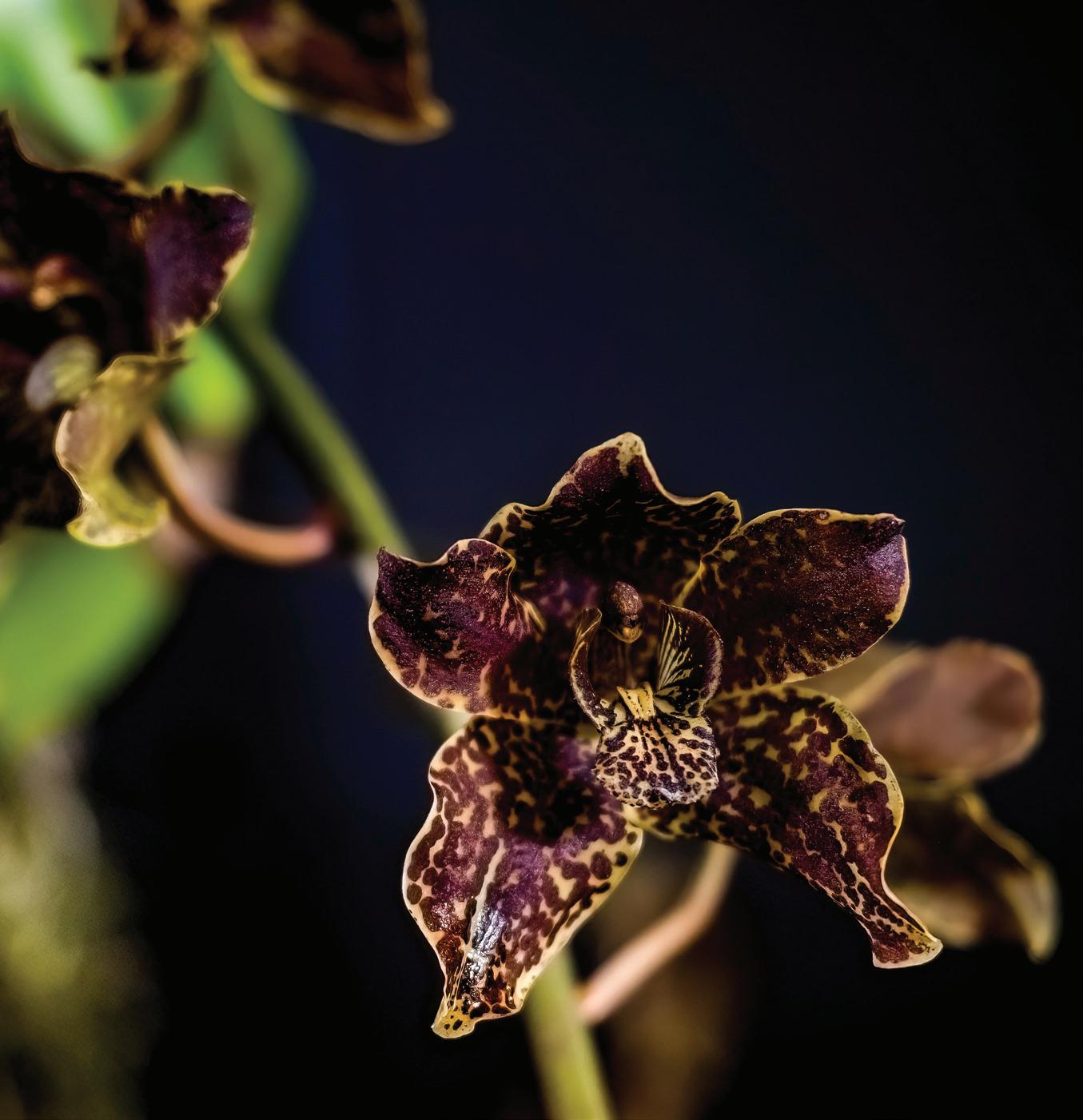
Naples is home to the most golf clubs with Audubon Cooperative Sanctuary Program certifications in the country—proof of the city’s commitment to exalt our natural setting.
The Audubon Cooperative Sanctuary Program for Golf (ACSP) rewards golf courses for their efforts in protecting the environment and promoting sustainability. Florida is home to more courses that have earned this certification than any other state in the country, and Naples leads the way with 21 certified clubs.
Naples’ oldest, privately owned club, Hole-in-the-Wall, set a good example when it earned its ACSP in 1994, followed closely by Olde Florida Golf Club in 1995. Back then, Darren Davis, the long-time superintendent, says courses were not seen as positive environmental forces, which they can be—when built and managed properly. “Golf courses are a safe haven—a greenway that allows habitat to still flourish in an area that’s growing at an extreme pace,” he says. Local superintendents, like


Darren, Matt Taylor of the 36-hole Royal Poinciana and local sustainable golf legend Tim Hiers, were motivated to change the narrative and make good on the promise of golf courses as refuges in the unofficial Golf Capital of the world.
Clubs started placing greater emphasis on sustainability, redesigning layouts to make more room for wildlife habitat, restoring broken lands, reducing the use of chemical fertilizers and pesticides, using electric golf carts, increasing native vegetation and technologies to reduce irrigation and energy needs, replacing turf with more resilient varieties, creating built structures with recycled material and amplifying recycling standards. Olde Florida protected 120 of its 220 acres as thriving woodland and wetland habitats, supporting as many
as 75 bird species. “We can offer several hundred green acres, which have become a safe haven for all the wildlife that’s being displaced,” Darren says. Within the next five years, six other courses, including Hole-in-the-Wall, Royal Poinciana and Wilderness Country Club, joined the sanctioned ranks.
Golf course architect legend Arthur Hills’ firm is behind many of the ACSP-sanctioned courses in town—including Wilderness, Foxfire, three of the Bonita Bay courses, Club Pelican Bay and Quail Creek—the most recent to be inducted in 2022. His designs abound with native trees, wetlands and cart paths that meander around the vegetation rather than through it.
Clubs like Bonita Bay, The Club at Mediterra and Collier’s Reserve take things a step further as Audubon Signature and


Classic Sanctuaries, the most elite environmental certifications. In 1994, Old Collier—which preserves 53 acres of mangrove and wetlands along the Cocohatchee River and 109 adjacent acres of continuous native habitat corridors—was the first in the world to receive the apex Gold Signature Sanctuary status. The club, opened by Miles C. Collier in 2001, irrigates exclusively with brackish water and pioneered the use of salt-tolerant seashore paspalum turf from tee to green.
Collier’s Reserve, another Gold Signature Sanctuary, signed their agreement with Audubon before the first shovel was turned. Golfers there enjoy spotting any of the 400-plus resident species, including endangered gopher tortoises, roseate spoonbills and eagles. And, at Bonita Bay—where about half of

the 2,400 acres are protected and all five golf courses follow the same strict environmental standards—the grounds team is said to consist of arborists, certified horticultural professionals and a wildlife handler.
Tiburón Golf Club—one of the most popular courses in town—allows golfers to see the efforts in action through the 20 acres of protected native lands, 40 built birdhouses, buffered lakes and repurposed coquina shells used for waste bunkers.
Courses like Olde Florida and Quail Creek have also built nesting structures, created reintroduction programs for native wildlife and partnered with environmental groups. Wilderness Country Club, for instance, collaborates with the Conservancy of Southwest Florida to monitor wildlife.

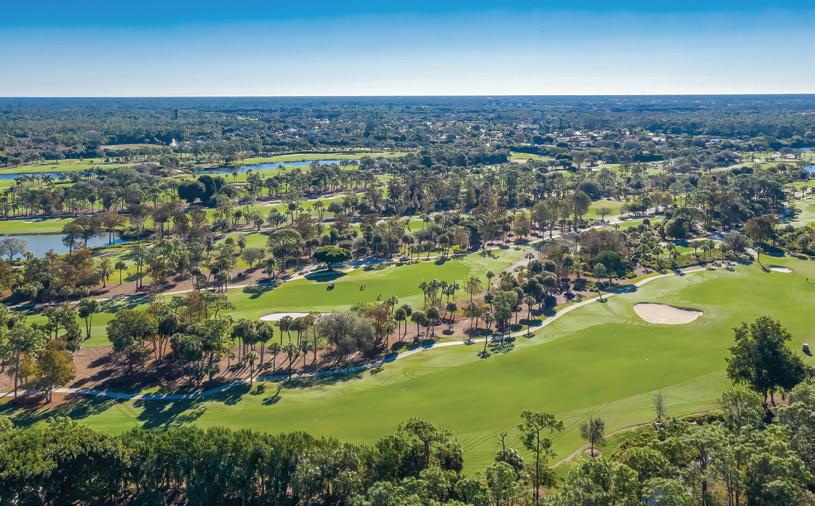
Initiatives such as these capture members’ interest. At Olde Florida, members go to the club with their kids and grandkids
in tow for golf cart tours to see alligators sunning on the banks, eagles perched in nearby pines and osprey flying overhead. “They’re proud of what we’ve carved out of this natural environment,” Darren says.
As part of the ACSP certification process—and recertification, which is done every three years—golf clubs and their staff must demonstrate a commitment to outreach and education. It’s an aspect of the program that Davis especially values. He points to Tim Hiers, the former director of agronomy at The Old Collier Golf Club, as someone who championed the cause decades ago and inspired Darren to be more involved. “He heightened my passion to not only do the right thing for the environment but to talk about it and showcase it,” Darren says. “As Tim did that for me, I’m doing that for others, and others are doing it for others. A rising tide lifts all ships.”
WHEN WE PROTECT NATURE, NATURE PROTECTS US.
YOUR SUPPORT MAKES A DIFFERENCE IN THE HEALTH OF OUR REGION.
The teams at the Conservancy of Southwest Florida have been working for almost 60 years to find a sensible balance between the demands of a growing population and the preservation of our natural resources.


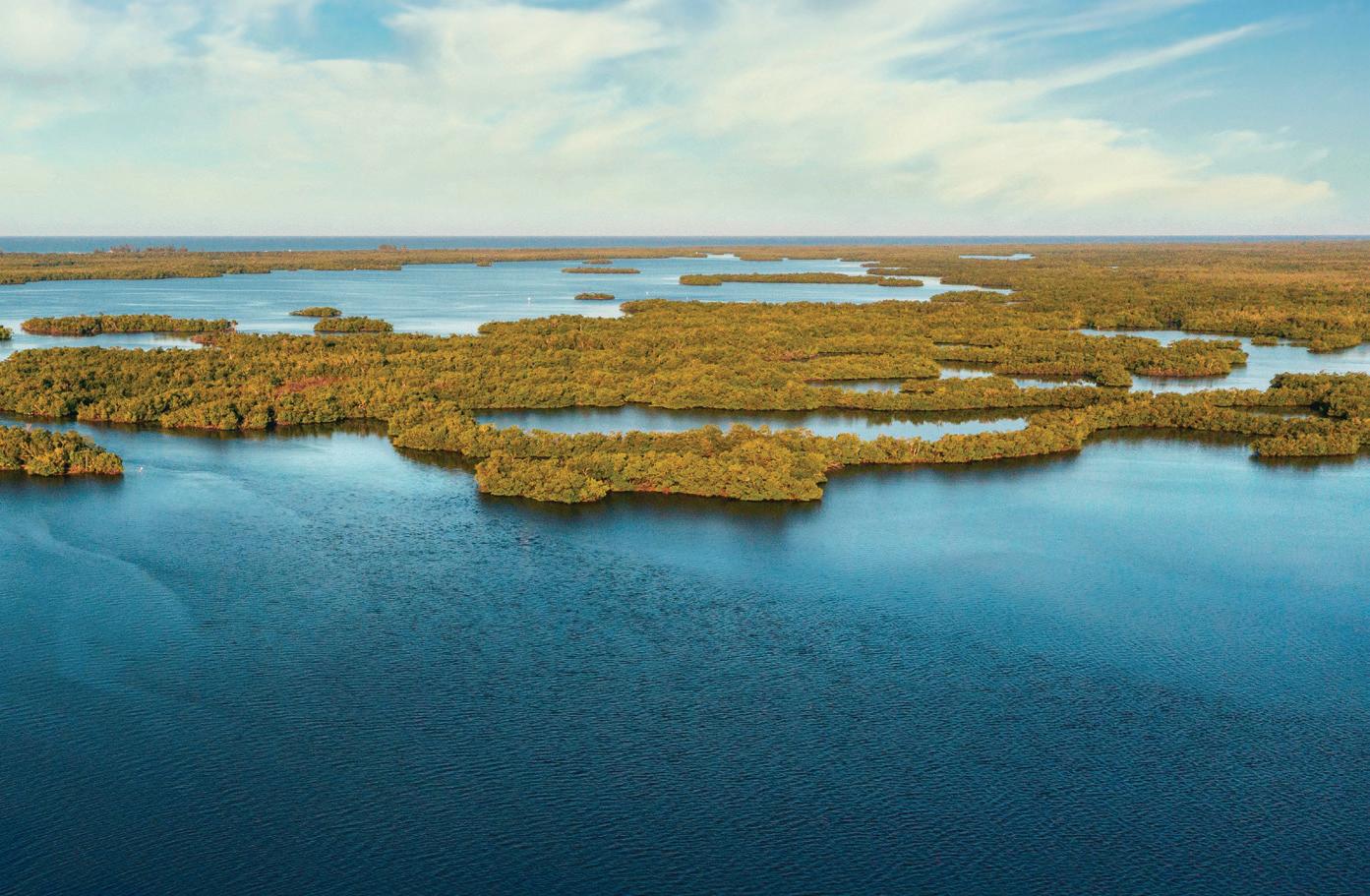
By becoming a member, you will not only help protect Southwest Florida’s ecosystems, you will become part of our diverse community striving to support the health of our environment.

Sign up for E-News at conservancy.org and receive the latest news about the work we’re doing, policy updates, memberships and events at our Nature Center.
BECOME A CONSERVANCY MEMBER TODAY.
Athletes at the top of their game favor Naples as an ideal home base.
With its plentiful golf courses, tennis courts and beaches, Collier County lends itself to physical activity. For long, the temperate climate and coastal ease lured a mostly retiree population. Increasingly, athletes and those pursuing a healthy lifestyle have taken note.
Runners and cyclists revel in the ubiquitous flat roads, which are easier on the joints. Triathletes appreciate easy access to the Gulf for open-water swims. Pickleball players take pride in Naples hosting the Minto US OPEN Pickleball Championships. And, athletes of all stripes find dependable warm weather a motivator to get out and about. Whether amateur, pro or retired, there are plenty of good reasons for sporting enthusiasts to call Naples home. Just ask these four greats.

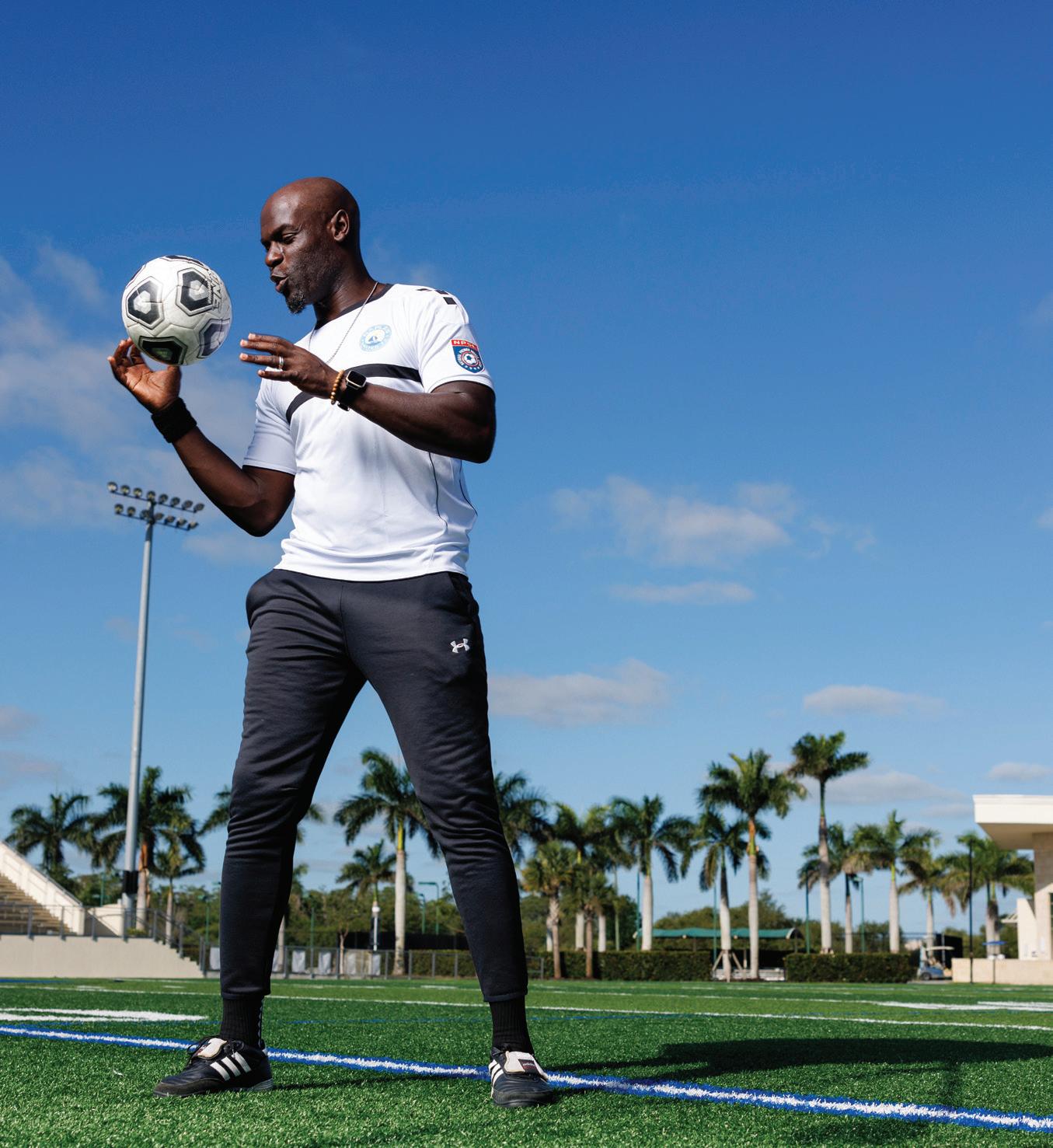
Growing up in football-crazed London, Enoch Showunmi dreamed of playing professionally. He got his chance two months before his 22nd birthday, when he signed with Luton Town Football Club. He played pro for 12 years for esteemed clubs, teams and leagues across the U.K. and Nigeria. Years later, he’s helping shape Naples’ future as a soccer community.
After the 41-year-old entrepreneur moved here with his wife in 2019, Enoch became director of Naples United FC, the only professional soccer club in the city, which has a semi-professional team for adults and several youth groups for ages 5 to 19. Around the same time, he launched Global Soccer Pathways, where he mentors young players. And this summer, he introduces MPC Academy, an after-school program that teaches students marketing, branding and industry insights for various fields to help them figure out their education and career paths. “I always felt, growing up and going through school, it’s like, ‘OK, here’s your degree, here’s your qualifications,’ and then ‘Bye! See you later,’” Enoch says. “The main way people learn and the way people grow as individuals is when they go through a course or go through a program and there’s that connection with the leader of that program or the teacher.”

The retired athlete is committed to feeding Naples’ soccer scene, building on the strong enthusiasm for the sport.
During any given Sunday pickup game, he says, there could be up to 200 people showing up to play. And, there are five groups of the recreational Gulf Coast Adult Soccer League in Naples—many of which are at membership capacity. “Over the years, you create a hub within the community and you have events and soccer games with people coming to watch and cheer on their local teams. Especially [a place] as small as this, it can galvanize a community,” Enoch says. He still gets in regular games with the Gulf Coast rec league (“It’s for all us old folks who want to keep playing the game, keep fit, keep running around and have a fun, organized meet,” he says), and you’ll find him weekly at Paradise Sports Complex coaching the youth teams. Enoch often pulls players from Naples United FC to help. Players from the semi-professional team have gone on to play in Uruguay and Israel, giving kids inspiring access to top talent.
He looks forward to a time when star athletes don’t have to leave their hometowns to compete at the highest level. “You don’t have to go to New York or Miami or Orlando,” he says. “You can stay close to family; you can stay close to your roots, where you grew up, that became a big part of your life.”
Discover an established country club honoring time tested traditions while embracing the modern expectations of membership today. Here neighbors are not only friends but tennis and golfing partners. Woven through 300 acres of cypress, pine, and palm trees is a hidden enclave of only 460 doors. Become one of the few and fortunate that call Eagle Creek home.


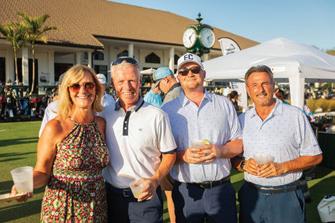

(239) 793-0500 joineaglecreek.com

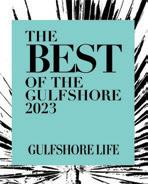


Few individuals have done more to propel cycling in Naples— especially for women—than Tish Kelly. A former tennis player, Tish founded Florida’s first women’s professional cycling team, Goldman Sachs ETFs Racing, eight years ago. Riders try out worldwide for a spot on the team (this year’s athletes hail from as far as Mexico, Israel and the United Kingdom). Until recently, the roster included her 30-yearold daughter, Madison Kelly Brookshire.
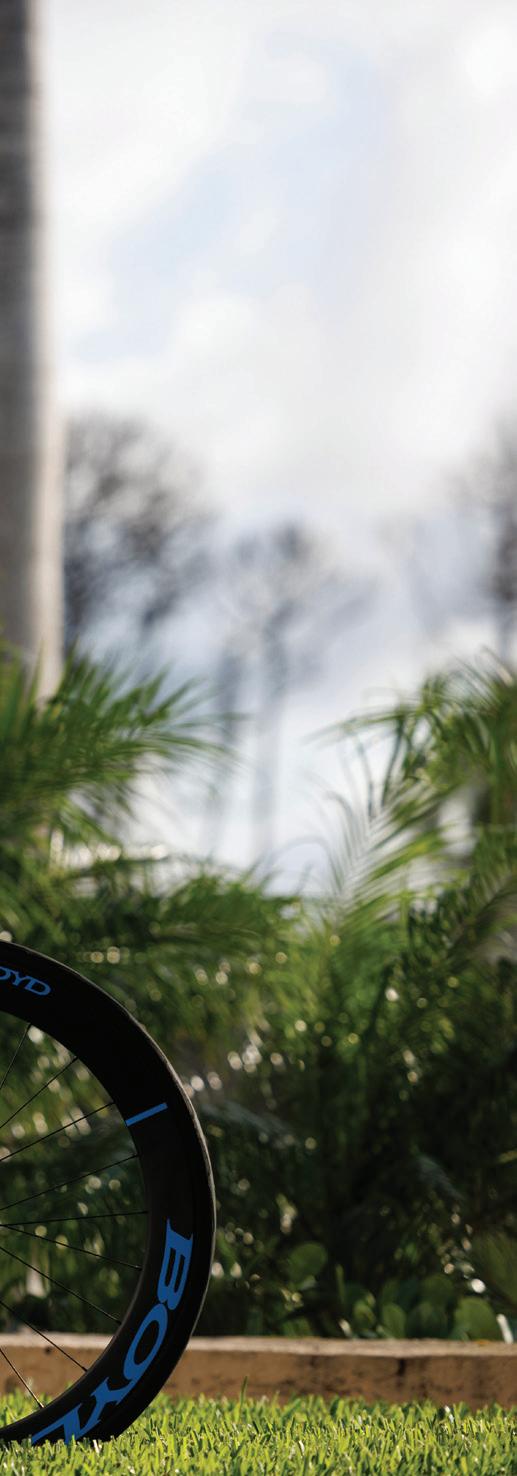
Tish turned to cycling 17 years ago when a tennis friend introduced her to the sport, and Tish found racing made her faster on the courts; now cycling is her sole focus. When Tish showed up to her first Naples Velo club ride in 2006, she looked around and wondered, ‘Where are all the women?’ She’s worked ever since to bring more females into the fold. Back then, Tish was one of three women in the group. Now, female riders make up about 50 percent of the entry-level group and 20 percent of Velo’s high-speed rides. Tish rides with all of them: “I’ve told so many women, ‘Come with me … I can show you how to do it.’”
Nine years ago, she invited Madison to ride, which turned into the two of them competing in professional races. Six months later, Tish started gathering investments for a Naples pro team. Working with the team’s director, Ben Renkema,
she trains the women—all in their 20s and early 30s—in criterium, or ‘crit’, racing, which emphasizes fast and short rides with tight corners and multiple laps over distance rides. She says Naples’ Pine Ridge neighborhood provides a perfect setting to navigate tight corners and work on aerobic conditioning. With no mountains to coast down, cyclists have to peddle constantly, and the year-round warm weather keeps them consistent.

Tish says crit cycling is a spectator sport. Locals are awed when they see a peloton with eight women peddling shoulder -to-shoulder at high speeds. “It’s like the NASCAR of bike racing,” she says. “You see them come around like 30 times at high speeds; we’re talking well over 30 mph.” Fittingly, NASCAR is one of the team’s sponsors.
When the women are in town for training, Tish hosts several of them at her house. “It’s a labor of love,” she says. “I don’t make any money off of it.” Her background running in Naples philanthropic circles, since moving to town with her tennis champ ex-husband, Johan Kriek, in 1978, equips Tish to fundraise for the team. She also gets the women involved in the community, participating in local rides to raise awareness for the sport, and works on bike-friendly road legislation with Naples Pathways Coalition.
Now, Tish rides 200 to 300 miles a week. Whether she’s pedaling through Port Royal with her Velo club or racing down main thruways with the women on her racing team as they train for their next meet, the cyclist pushes herself to the limits. “It keeps me in shape and keeps me young as long as I don’t hit the deck,” she says with a laugh. “I’m in better shape than I was when I played tournament tennis when I was 25.”



Freezing temperatures and iced-up sledding tracks are not typical concerns for Florida residents. But to Naples native Brian Shimer, these things are second nature.
Growing up in Naples, Brian wrestled and played baseball and football at Naples High School in the 1970s. He says the community’s deep involvement made sports special in those days. A Naples police officer coached his traveling football team, and Brian’s dad coached little league and basketball.
After graduating from Morehead State University in Kentucky, where he played collegiate football, one of his coaches suggested he try out for the Olympic USA bobsled team. He knew little about the sport but enjoyed watching the event on television. After sending in tapes of physical aptitude tests (average bobsledders weigh between 185 to 250 pounds, and exceptional strength and flexibility are crucial for navigating the sled around tight corners), he flew out to Lake Placid, NY, for an in-person athletic test. “Two weeks after that trial, I was on a plane to Germany,” he recalls.
As a bobsledder, the Olympian competed in five games during his 17-year professional athletic career. He’s since coached Team USA men’s and women’s teams and led the men to their first gold in 62 years in 2010. Through his success, Brian, who remains the head coach for the men’s and women’s teams, has always called

Naples home. He travels for work months on end—to Europe for the bobsled circuit, to Lake Placid and Colorado Springs, CO, for camps and recruitment events—but his time spent at home with his teenage son, Bodie, and daughter, Brianna, is the most rewarding. During the summer, Bodie, who plays soccer and runs track, often trains with Brian. “I get him in the gym lifting, and he pushes me; I try to keep up with him,” the former Olympian says.
As he stays active with his kids locally, Brian’s enjoyed watching Naples develop as an athlete’s hub, with more spaces for talent to grow, from better equipment in schools to elite training facilities. “When I was competing earlier on as an athlete, I moved to Atlanta to train at a high-performance facility because we just didn’t have that here in Naples,” he says. “Now we have some of those facilities here that take any level of athlete and train them.”
Brian’s also stayed connected with the community, donating memorabilia to local schools and playing in charity golf tournaments, including Mike Ditka/Jim Hart’s Celebrity Golf Invitational. He gets out with his kids and bikes to the beach for sunsets. “I grew up not really appreciating how fortunate it was to grow up here for me,” Brian says. “I certainly realize, each time I come back, this is truly paradise.”
Naples was not yet dubbed the Pickleball Capital of the World when superstar player Simone Jardim moved here in 2016. Back then, there were few permanent courts at East Naples Community Park, where the lauded Minto US OPEN Pickleball Championships is hosted in the spring (there are now 64 courts).
The renowned athlete—ranked number one in women’s singles, doubles and mixed doubles from 2016 to 2020—transitioned
from tennis to pickleball in 2015, around the same time she first visited Naples for a tennis conference as the coach of Michigan State University’s team. On a return visit a year later to compete at the US OPEN, she felt at home in Collier. After braving seven Midwestern winters, she was ready for Florida’s weather, which is more akin to her native Brazil’s. She and her baseballer husband wanted to live where their kids could run free outside.



Proud to be planted in this community
When pickleball's most decorated player, Simone Jardim, moved to Naples, there were few permanent courts at East Naples Community Park. There are now 64.


Simone’s pickleball career thrived in tandem with the sport’s national rise and Naples’ claim as the capital. As Collier County built out more pickleball courts, added the sport to the public school’s curriculum and grew multigenerational interest, Simone was racking up about 100 medals (many of them golds) and a sponsorship deal with Nike. At first, it may have been Naples’ sunny year-round weather, the existing popularity of tennis and the elder demographic’s favoring of pickleball as a lower-impact sport that made the city a natural hub. But, now pickleball presents its own draw. With younger athletes getting into the sport through camps and school programs, older

players are now sharing the court with the next generation, bringing families—and the community—together. And, with Simone here to coach the next generation, other impressive players are moving here, too, like No. 3-ranked Catherine Parenteau, who moved to Naples several years ago.
Simone now tours with the Association for Pickleball Professionals, competes in tournaments and plays regularly on the court she built in her home. She continues coaching through the Naples-based Peak Performance Pickleball Academy she founded with her husband. “[Pickleball] is fun to teach, and I feel like I’m still learning as the game changes,” she says.
With restored water flows, fortified beaches and protected habitats, Collier County’s environmental conservation efforts lay the foundation for generations to come.

The topic of local development and conservation is complex—it’s not enough to consider that 80 percent of Collier County falls within protected lands if new construction sprawls across vital habitats and sensitive areas. Still, our natural ecosystem has seen major wins, especially in recent years with emboldened support for the federal-and state-driven Comprehensive Everglades Restoration Plan (CERP). In this area, you rarely have to venture far to connect with Florida’s wild beauty. Organizations and government agencies continue to collaborate on landmark projects to promote a verdant future.
Since launching in 2003, the countywide Conservation Collier has had a major impact on preservation, with 4,664 protected acres stretching between Marco Island and Immokalee. The tax-funded plan acquires parcels of land to preserve and restore the native habitat, with more than half of these lands being open for public recreation (think: Gordon River Greenway, Freedom Park, Pepper Ranch Preserve). In February, the board approved the proposal for the largest purchase yet with Owl Hammock at 7,378 acres.
Being mindful of our natural environment is as much about preserving land as maintaining what’s there. Since 2013, Audubon’s Corkscrew Swamp Sanc -
tuary in Naples has worked to control overgrown Carolina willows and woody vegetation to make room for the natural grass needed for a wetland to thrive. By late 2022, the Sanctuary was a year ahead of schedule in its five-year goal to restore more than 1,000 acres, where wading birds are now returning to fishfilled marshes that were once shrouded with overgrowth. Shawn Clem, director of research and interim director of conservation at Corkscrew, says wetlands are vital to Collier County’s way of life, helping manage water quality and feeding tourism and recreation.
“That’s the goal of the sanctuary, is to hold on to that ecological value of ‘Old Florida,’ of the habitat that was here before we were, so that people can find their peace,” she says.
Further south, The City of Marco Island, the Florida Fish and Wildlife Conservation Commission (FWC) and the Florida Department of Environmental Protection completed the largest mangrove restoration project in the state’s history—209 acres of wetland at Fruit Farm Creek in Rookery Bay Natural Estuarine Research Preserve. And in May, the Tigertail Lagoon/Sand Dollar Island Ecosystem Restoration Project finished moving more than 600,000 cubic yards of sand on the island’s northern shore to create
a coastal barrier system that protects against severe weather and natural disasters. It also re-establishes a flow channel connecting the north and south points of the lagoon to improve water quality, keeping the coastline pristine for resident shorebirds, nesting sea turtles and beachgoers.
Moving inland, the Picayune Strand Restoration Project in Naples is almost complete as part of CERP, which replenishes more than 55,000 acres of Florida wetlands by restoring historic water flows. With plugged canals, leveled roads, three pump stations to move water, engineered berms, and a levee to protect existing agricultural and residential lands from flooding, the project feeds parched wetlands, improves water quality and restores the balance in Florida Bay. The fruits of labor are already evident: At the Merritt Pump Station, completed in 2014, the spreader basin teems with Florida panthers, alligators, deer, cormorants, great blues and white pelicans in winter. “All the scientists and field researchers want to work at Merritt because you can see the restoration working—it’s full of birds,” says lead project manager Joanna Weaver of South Florida Water Management District. “Give it three years and Faka (Union Pump Station, completed in 2021) will be the same.”
With restored water flows, fortified beaches and protected habitats, Collier County’s environmental conservation efforts lay the foundation for generations to come.

The topic of local development and conservation is complex—it’s not enough to consider that 80 percent of Collier County falls within protected lands if new construction sprawls across vital habitats and sensitive areas. Still, our natural ecosystem has seen major wins, especially in recent years with emboldened support for the federal-and state-driven Comprehensive Everglades Restoration Plan (CERP). In this area, you rarely have to venture far to connect with Florida’s wild beauty. Organizations and government agencies continue to collaborate on landmark projects to promote a verdant future.
Since launching in 2003, the countywide Conservation Collier has had a major impact on preservation, with 4,664 protected acres stretching between Marco Island and Immokalee. The tax-funded plan acquires parcels of land to preserve and restore the native habitat, with more than half of these lands being open for public recreation (think: Gordon River Greenway, Freedom Park, Pepper Ranch Preserve). In February, the board approved the proposal for the largest purchase yet with Owl Hammock at 7,378 acres.
Being mindful of our natural environment is as much about preserving land as maintaining what’s there. Since 2013, Audubon’s Corkscrew Swamp Sanc -
tuary in Naples has worked to control overgrown Carolina willows and woody vegetation to make room for the natural grass needed for a wetland to thrive. By late 2022, the Sanctuary was a year ahead of schedule in its five-year goal to restore more than 1,000 acres, where wading birds are now returning to fishfilled marshes that were once shrouded with overgrowth. Shawn Clem, director of research and interim director of conservation at Corkscrew, says wetlands are vital to Collier County’s way of life, helping manage water quality and feeding tourism and recreation.
“That’s the goal of the sanctuary, is to hold on to that ecological value of ‘Old Florida,’ of the habitat that was here before we were, so that people can find their peace,” she says.
Further south, The City of Marco Island, the Florida Fish and Wildlife Conservation Commission (FWC) and the Florida Department of Environmental Protection completed the largest mangrove restoration project in the state’s history—209 acres of wetland at Fruit Farm Creek in Rookery Bay Natural Estuarine Research Preserve. And in May, the Tigertail Lagoon/Sand Dollar Island Ecosystem Restoration Project finished moving more than 600,000 cubic yards of sand on the island’s northern shore to create
a coastal barrier system that protects against severe weather and natural disasters. It also re-establishes a flow channel connecting the north and south points of the lagoon to improve water quality, keeping the coastline pristine for resident shorebirds, nesting sea turtles and beachgoers.
Moving inland, the Picayune Strand Restoration Project in Naples is almost complete as part of CERP, which replenishes more than 55,000 acres of Florida wetlands by restoring historic water flows. With plugged canals, leveled roads, three pump stations to move water, engineered berms, and a levee to protect existing agricultural and residential lands from flooding, the project feeds parched wetlands, improves water quality and restores the balance in Florida Bay. The fruits of labor are already evident: At the Merritt Pump Station, completed in 2014, the spreader basin teems with Florida panthers, alligators, deer, cormorants, great blues and white pelicans in winter. “All the scientists and field researchers want to work at Merritt because you can see the restoration working—it’s full of birds,” says lead project manager Joanna Weaver of South Florida Water Management District. “Give it three years and Faka (Union Pump Station, completed in 2021) will be the same.”
 BY JAYNIE BARTLEY
PHOTOGRAPHY BY ANNA NGUYEN
ARRANGEMENTS BY ELAINE GATES
BY JAYNIE BARTLEY
PHOTOGRAPHY BY ANNA NGUYEN
ARRANGEMENTS BY ELAINE GATES
Exuberant collections, longtime local growers and a warm, subtropical climate prove Collier County is an orchid lover’s paradise.

Naples Botanical Garden has long been a hub for orchid lovers, thanks to their dreamy LaGrippe Orchid Garden and hosting the Naples Orchid Society Annual Show & Sale every February. Naples Botanical’s Nick Ewy loves the shade-loving Miltoniopsis (above) for their painterly petals. Southwest Florida’s subtropical climate is perfect for Paphiopedilum philippinense (previous spread), which can grow up to 19 inches. The palm-sized dendrobium Hibiki (previous spread, right) is ideal for a sunny windowsill.

The buzz of conversation emanates from Naples Conference Center as Gulf Coast Orchid Alliance (GCOA) begins their final season meeting. I enter the cheerful chaos to find Florida Gulf Coast University’s orchid expert John Finer weaving through the crowd, a white folding chair hoisted overhead. “We’re running out of chairs,” he shouts. I’m here to meet John and his Rolodex of orchid contacts in a pursuit to discover why the tropical flowers are omnipresent in our community.
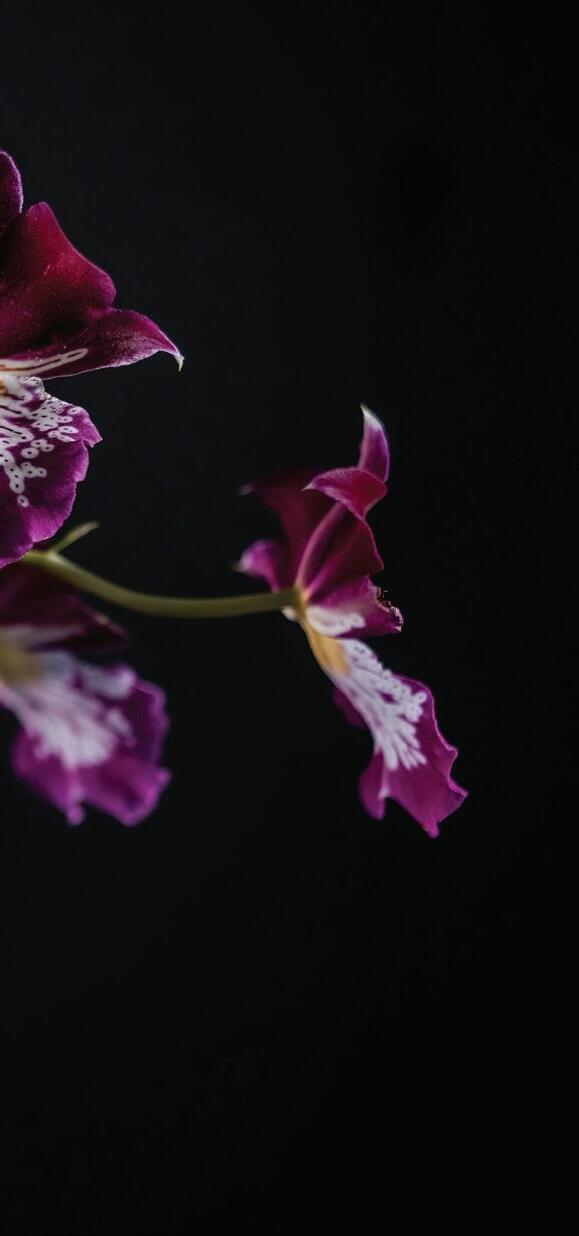
Flipping through Gulfshore Life archives dating back to 1970, we repeatedly find the flowers in society photos and editorial features. For one city to hold two orchid clubs—Naples Orchid Society formed in 1963, long before GCOA formed in 2012—with hundreds of members each and to be home to a flourishing annual orchid show, there must be something behind the obsession. So what makes Collier County an orchid lover’s mecca?
With humid, sunny days and a quick stint of ‘Florida winter’ (read: 68 degrees and sunny), South Florida has more than 60 native orchid species—many growing in our backyard swamps and cypress forests. Just south of Miami, Fairchild Tropical Botanic Garden’s decade-old Million Orchid Project aims to plant 1 million natives throughout the Everglades. On our coast, the ghost orchid is renowned for its singular bloom. In peak season, a telescope is planted on the boardwalk at Corkscrew Swamp Sanctuary, pointing directly to the drooping white flower grafted to a far-off towering cypress. And Naples Botanical Garden recently exhibited the breed at London’s esteemed RHS Chelsea Flower Show.
Serious orchid collectors, like GCOA president Jim Longwell, don’t stop with one orchid. They have thousands. Each GCOA meeting starts with members showing off their prized flowers—a 2-foot-tall dendrobium with bamboo-like spikes and pink-tipped flowers, a drooping LC Cornelia hybrid resembling a dancing flower from Alice in Wonderland. Members and visitors peruse
FGCU researcher John Finer is an expert in hybrids, like the Brassia Rex (above), which stands out with long, spider-like petals. Phalaenopsis, also known as moth orchids (right), come in a plethora of colors and are popular among beginners. Gulf Coast Orchid Alliance’s vice president, Elaine Gates, who is known around town for her prize-winning arrangements, grouped the “phals” with vibrant, star-shaped Bratonia Charles M Fitch (far right) and a tiny, single-bloom Paphiopedilum thaianum, or white genie (center).


at least 100 vibrant blooms that hang from racks and fill tables around the room’s perimeter. Vice president Elaine Gates, who’s unpacking Hawaiian orchids to hand out as prizes, says a turnout like this has become commonplace as the club’s membership skyrockets. Naples Orchid Society president Jim Davenport later echoes her sentiments, telling me the society’s annual orchid show at Naples Botanical Garden saw 5,000 visitors this February. While most local collectors source their blooms from shows and growers nationwide, newbies might look to Jade Orchids in South Naples. Owners Judy and David White launched the farm 36 years ago. Now the only commercial grower in the county, the couple stocks common types such as moth-like phalaenopsis, fragrant vandas and dainty dendrobiums. For a no-maintenance option, seasonal residents and not-so-green thumbs opt for hyperrealistic artificial
orchids from Naples’ Sweetgrass Galleries, where owner Norine Fuller stocks dozens of handpainted fabric varieties. (Hot take: Elaine says many collectors stick faux spikes in their real plants between blooming periods.) Off the rock, Marco Island Florist offers same-day delivery for artful orchid arrangements.
For observers, Naples Botanical Garden’s dreamy LaGrippe Orchid Garden reveals the species’ diversity through towering lady slippers with wispy petals, big-bloom vandas with stickstraight roots grazing the floor and magenta Miltoniopsis showing off painterly petals. The Garden’s head of collections, Nick Ewy, favors native Florida breeds like the fiery butterfly orchids commonly found growing in sabal palms and bald cypress throughout the county—more proof that Collier truly is an orchid lover’s paradise.


One of the few who can say they were born and raised in Naples, Leslie Vega remembers when she and her family could ride horses down Fifth Avenue South. Leslie’s dad, the late George Vega, was a local hero—serving as attorney for Port Royal pioneer John Glen Sample, among many other respected locals, and backing environmental causes such as Conservancy of Southwest Florida, for which he served as executive director in its early days.
In combing through more than 53 years of Gulfshore Life archives, we found this charming snap from 1976 of Leslie’s brother, John, biking with a few other Naples kiddos, Robin Carroll and Bob Billings Jr., through the streets of Port Royal. Leslie recalls riding her bike up and down the “hills” of neighbor’s driveways, pre-screening movies at Walt Disney’s friend’s home and hunting for Easter eggs in the Briggs family’s yard. “There were so many fun things to do back then,” Leslie says. She vividly remembers self-made millionaire John Slater’s compound near the Port Royal Club, where the retiree created a makeshift animal sanctuary to house injured dolphins, manatees, seals and other wildlife. While today’s Port Royal homes have swapped petting zoos for koi ponds, you’ll still catch Leslie riding her bike up and down Gordon Drive.

